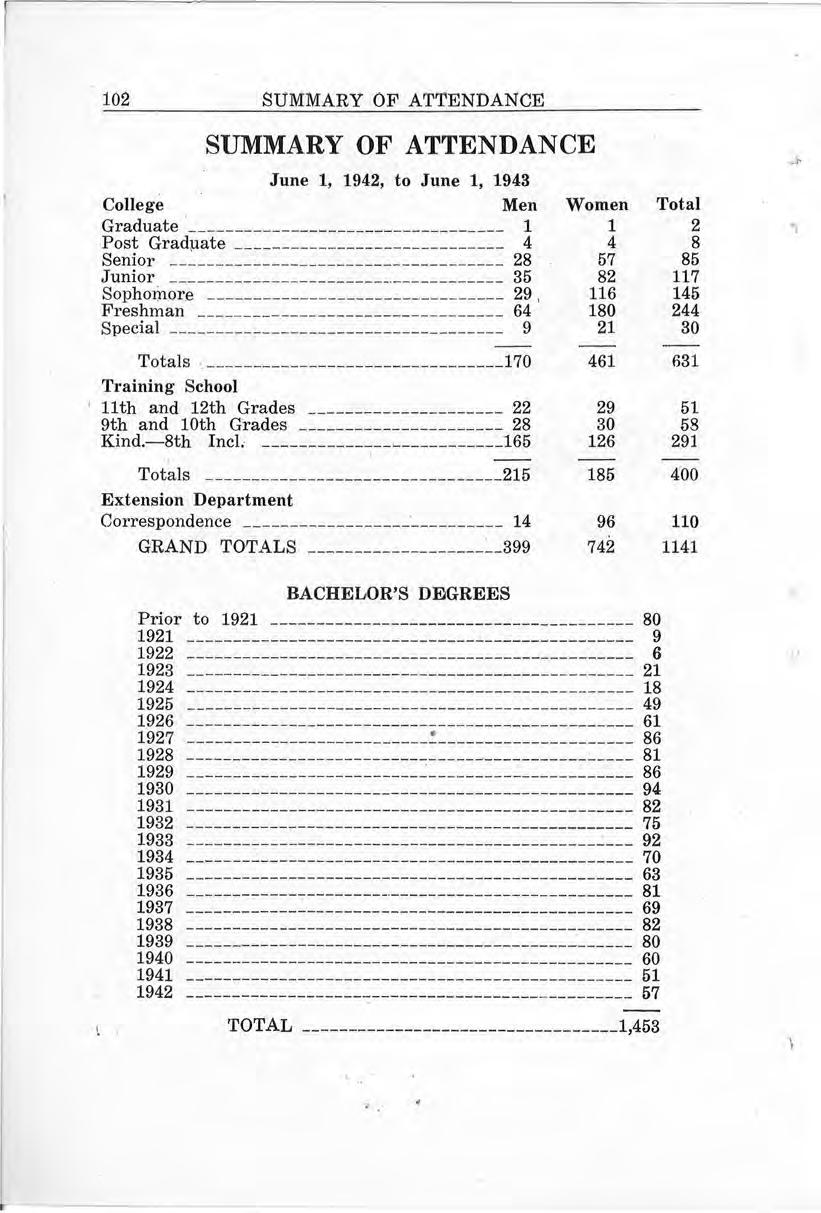




Entered as second class matte r August 27, 1936, at the post office of Peru, Nebrnska , under the Act of August 24, 1912. Issued Quarterly.

I.


First Se me ster
Sept. 6, Mond ay _ Fre shman tests, 8 :00 a.n1, (Required of all fr e shm en . Late r e gistration -· fee charged freshmen who fail to report. See FEES.)
Sept. 7, Tuesday _ Registration of all upperclassmen, 8 :0012 :00 a. m. Late registration fee charged after 12 :00 m this date.
Sept. 8, Wednesday_____ . Registration of freshmen, 8 :00 a .m.
S ept. 9, Thursday _______ Classes begin, 8 :-00 a. m.
Sept. 17, Friday ___ Last d ay to change registration.
Nov. 8, Monday _________ Second quarter begins. Last day to change registration for second quarter.
Nov. 24, Wednesda.y _____ Thank s giving recess begins 12:30 p. m.
Nov. 29, Monday ___ Classes resume 8:00 ~- m .
Dec. 22, Wednesday _ Christmas vacation begins 12:30 p .m.
Jan. 3, Monday ____ Classes resume, 8 :00 a. m.
Jan . 21, Friday _____ _:_ First semester closes.
Second Semester · ..
Jan. 24 , Monday _ Registration, second sem ester . Late registration fee charged after this date .
j an · 25, Tuesday _ Se cond s e mes t e r classes begin.
F eb. 2, Wednesday __ Last day to change registration.
March 27, Monday _ Fourth quarter beg-ins . Last day to change · registra tion for fourth quarter.
Apr. 6, Thursday _ Spring recess begins 12 :30 p, m.
Apr. 11, Tuesday __ Cl asses resume, 8 :00 p. m.
May 26., Friday __ Second semester closes.
Short term (6 weeks) opens _____ June 5
Lon g tern1 (9 weeks) op€ns ____ June 5
Address the Registrar for a summer school bulletin.
STATE BOARD OF EDUCATION
Mr. Everett L. Randall, President, Kearney _____ Term expires 1947
Mr. Alvin E. Johnson, Vice-President, Omaha __ Term expires 1949
Mrs. Evelyn A. Ryan, Secretary, Grand Island __ Term exp!res 1945
Dr. Walter Benthack, Wayne ____ Term expires 1945
Mr. Edwin D. Crites, Chadron _ Term expires 1949

Mr. Edgar Ferneau, Auburn ___________ Term expires 1947
Mr. Wayne 0. Reed, State Superintendent of Public Instruction, Lincoln _____ Ex-Officio
W . R. Pate , A . B., A. M., President. 1923.
*J A. Jimerson, A. B., A. 'M., Ph. D. , Executive Dean and Director of 'Extension . 1938.
Mrs. !nice Dunning, A. B., Dean of Women. 1924.
E . H . Hayward, A. B., Registrar. 1929. -
Mrs. Mary 0. Delzell, A. B., Assistant to the Registrar. 1941.
Elma I. Gockley, Bursar and Secretary to the President. 1918.
Beulah O. Bridgewater, Bookkeeper. 1943.
Mrs. Genevie H. Marsh , Dormitory Assistant. 1929.
Mrs. Ruth f ussel, Matron, Men's Dormitory. 1939.
The departments of the College are members of one or more of six groups as indicated below.
DIVISION L ~--- - Mr . Winter, Chairman
Biological Sciences Mathematics
Geography (Also in Physical Education
· Division V) Physical Sciences
DIVISION n ______________________________ Mr. Maxwell, Chairman
Education Training- School
Rural Education
DIVISION IIL __ Mr. Bradford, Chairman
English Speech
DIVISION IV _________ Miss Konig, Chairman
Foreign Languages
DIVISION V ___ Mr. Brown, Chairman
History and Other Geography (Also in Social Sciences Division I) Commerce
DIVISION VL __ Mr. Larson, Chairman
Practical and Fine Arts including :
Industrial Arts Art
Home Economics Music
• On lea ve of a bsence for war service.
(Final date indicates year service at Peru began)
W. R . PATE ..... . ..........................•...• . .President
A. B., University of Nebraska ; A. M. , Columbia University. 1923.
BARNEY K. BAKER, ........ . ........... Professor of Education
B. S in Education, State Teachers College, Pittsburg, Kansas; A. M., University of K a nsas ; Graduate work , Universit)• of Chicago; Ph . D .. University of Kansas. 1926.
ROBERT T. BENFORD .•..••••• • Instructor. in Piano and Organ and Director of Public School Music in the Training School
Graduate , Artists Music Course, State Normal a nd Teachers College , Ypsilanti, Michigan ; A. B . Peru State Teachers College; Graduate Student, Sherwood Music School , Chicago , University of Iowa, and Un iversity of Michigan. 1926.
InA MAE BRACKNEY •••.. Assistant Professor of Home Economics
B . S. , Miami University, Oxford , Ohio ; M. S., Co lumbi a Uni versity. 1930.
ARTHUR L. BRADFORD •. • Professor of English, Head of Department
A, B ., University of Missouri ; J\1. S., Missouri Schoo l of Mines; Ph. D., George Peabody College, 1939
RuTH G. BRANDT .••••. Assistant Professor of Education, Princip~l ' Junior High School
A . B., Peru State Teachers Co ll ege; A. M., Universit y of Nebraska. 1921.
ERNEST E. BROD •• •• •. .- ...•• Assistant Professor of Education, Supervisor of Junior High School Training
A. B., Peru State Teachers Coll ege; A. M., University of Nebraska . 1941.
CASTLE M. BROWN • • Professor of History and Other Social Sciences , Head of Department
Ph. B., Deni son Unh·ersit y, Granv ille , Ohio; A. M , Columbia University; J D. Unive r s ity of Chicago; Graduate Student , University of Minnesota . 1928 .
MRs. RuTH S. BnowN ..•• • ••. Assistant Prof essor of Education, Supervisor of Third and Fourth Grade Teaching
A B. , Peru State Teachers College; Student, University of Minnes ota 1943 .
ESTHER A. CLARK . Professor of Foreign Languages Emeritus
A B., A. M , Na tional Normal U nive r s ity, Lebanon, Ohio ; A. B., University of Nebraska; Graduate Student, Yale University . 1898. ( Emeritus since September , 1938.)
ANSEL BENNET ~LAYBURN ... . Professor of Geography and Geology
Graduate of Kea rney State Normal School ; A. B. , A. M., Un i versity of Ne braska; Graduate Student . Uni ve rsity of Chi cago, U ni versity of Nebraska 1922.
SANFORD L. CLEMENTS ..... Professor of Education , Superintend ent of Training School
Graduate two -year co urse, Peru State Teachers Coll ege; B. Sc , Unive rs ity of Nebraska ; A . l\I., T eaeher s College, Co lumbi a University ; Graduate Student, Columbia University 1925.

PHYLLIS DAvrnsoN Associate Professor of Physical Education, Director of Physical Education for Women
B. S., Kansa s State Teachers Co ll ege, Empori a; M A., •.reac h e r s Co llege; Columbia Univers ity. 1929.
NORMA L. DrnDEL • ..••.••••••••• •• • Associate Professor of Art
I,.. B., University of Denver ; Student, University of California ; A . M., Colorado State T eachers College, Greeley. 19 29.
•on leave of absence for war service. tVisiting Instructor.
·
MR s I NICE DuNNING ••... .••• ••• .• • .•. Dean of Wom en
A. B ., Peru S t ate T each ers Co ll ege; Studen t, State Ju n ior Normal, Allia n ce, Ne bras ka; S t ate Teac h e r s College, Greel ey , · Co l o r a do; H a stin ~·s Co n serva tor y of M u s i c, S a n ta Cr uz , Cali fo rni a; G r ad u ate St u de n t, Co-
··, , · l u mbi a U nivers i ty 19 24. ·. · ·
MARIE HELEN FAULHABER • •••••• • Associate Professor of English
A. B. , Nebraska -vVes l eyan ; A JII ., Un ive r s i ty of Nebraska; Gr ad uate: Stude nt , Co lu m bi a '· Un i ve r sity. 192 0. ·
t STEPHEN 0. GAIN ES : • • • A s sis tant Professor Iudustrial Arts
A. B. , Peru State Teacher s Coll ege 19 42.
BLANCHE A . GARD ..•. .• .• Assistant Prof e s s or of Educat i on, S up erv i sor of First and S econd Grade T eaching

A. B., U n ive r s i ty o f Ka n sas; A. 111. , State Teac h ers Co ll ege, G r eel ey, Color a d o; Gr a du ate Stud en t, U ni ve r s i ty of Chi cago. 193 0
FRANCIS HARVE Y • • ..•.... A ssistant Prof e ssOr of Edu cat i on , Sup ervisor of Junior _High School T eaching
A. B Park Co ll ege, Par ksv ill e, Missou ri : A. J\I. Un i ver s it r of Texn s, A us tin , Texas; . St ud ent, No r t h T exas Ag ri cu lt ur a l Co ll ege, Arlin gcton, Texas; S tud ent, U nive r s ity of Co l o rad o, Bou l de r , Co l orado. 1 920.
MARGARET HENNINGSEN .• •• .•• • : : .••. Colleg e Nur_s e
A. B. , Dan a Coll ege; R. N ., Imm an u el Hosp ita l , Sc h ool of N urs ii1g ·; Oma h a. 193 9
MARY L . HILEMAN· Ass i stant Prof e ssor of Education, Supervisor of Th i rd and Foifrth Grade T eaching
A B , A. i\1 , State '.r eac h er$ Coll ege, G r eele.l', C'o l om<lo 19 2!l.
\ * ARTHUR LORN HILL .. • •••. . • .. : . . •O Prof essor of Math ematics
A. B ., D011ne Co ll ege, Crete, Ne b ras ka; Graduate Stude n t, Un h ersltx of Neb r aska. 1923. · ·
C. A. HucK • . • ••••• • •• . ••• . •. Associat e Prof esso1· of Mathematics
A. B., Cen t r a l vVesl eyan College, Wa r re n ton, 1\ Ii r,so u ri : :\I. A ., Ge o r g e P eab o d )• Coll ege f o r T each e r s, Nas h v ill e, Tenn essee 1923.
* JoHN A. JIMERSON • . • Executiv e D ean and D i r ector of Extens i on
A. B. , Per u S t a t e Teach ers Co ll ege; A. M., Pl1. D ., U ni vers i ty of Nebr aslrn.. 19 38.
V1cToR HuGo JINDR A . . .. ... . . . . . Dir ector of Band and Orch estra and Instru ctor in Violin •
A . B. , U ni ve r s i ty o f Nebra~ lrn; V iolin Stu de n t, Ca rl Freder i ci, · Stec k elb er g, Max F i sch el , Vi ctor Ku z d o; M u sic -Certi ficate, Chi ca:;o :\fu s i ca l Coll ege. 19 23.
* ARTHUR JON E S . Assistant Prof e ssor of. Physica(Educq,tion Assistant Dir ecto r of. Phys i cal Education for Men
B. Sc ., U ni ve r s i ty of Neb r as k a; A . i\I. , U n frers i ty o f Nebras k a . 1938 .
PEARL A. K E NTON • •. A ssoc i at e Prof e ssor of Foreign Langu ages
A. B , Peru State T e ac h e r s Coll ege; Stu d e n t , Bou l de r U ni ve r sity;° A.· M. , U ni vers i ty of Mi chigan . 1 924 .
EMILIE PAPEZ KrnK .•...• A ssistant Professor of Art
Sta t e T eache r s College, Wayne , Neb ras k a; A. B. . Un i ve r s i ty of i,ebraska : A 111 , U ni ve r s ity of Iowa. 1928.
SELMA S. KoNIG ..... . . ... . . . .. . Prof e ssor of Mod ern Languag e
A . B ., A. M , Ph D ., U ni v ers i ty o f W iscons in: Gradu ate Studen t, Un iversity of Chi cago , a n d th e So r bon n e, Pa r is . 1 9 31.
A. V. LARSON . . .... ... .. ......... . Prof e ssor of Industrial Art s
B . S c. i n Mee . E n g in eeri n g , U n bcers i ty of Nebras k a; A. M . , U ni ver s i ty of Minn es ota; Gra du a t e Stud e n t , U ni vers i ty of Nebr as ka, U ni vr r sity o f Chicago. 19 26.
*On leav e of a bsen ce for wa r ser v.ice. t Vis itin g Ins tru ctor.
C. R. LINDSTROM . . .. .. . . Assistant Pro f essor of Industrial Arts
B. S. in Eel. , U ni rn r sit r of Idah o; M S., Oregon State College; Gracluate Stud ent, Un h·er s i ty of Nebraska 1 93 0.
ELIZABETH McCoLLUM . Assistant Pr ofess or o f Education, Direc t or of Kindergarten
B. E., Na ti ona l Kindergarten Co llege. Chi cago; Stud ent Bloomsburg
S t a t e No rm a l Sch ool , Bloomsburg, P e nnsyll·ania, Valparai s o U ni ve r s ity, Pennsyh ania Un iversity , Co l umbi a Unirnrsity; A. M., Colorado _ State Teac h e r s Co ll ege, Gree ley. 1924.
t JoHN J. McINTIRE Instructor in Physical Educqtion
A. B., Peru Sta te 'l'eac h e r s Co l lege. 19 42
M. FLORENCE MARTIN .. .... .. . ... . Assistant Professor of English
A. B , State Teach e r s Co ll ege , Per u , · Nebrns ka; M. A., U niY ers i ty of Chi cago 1937
ISABEL MASON ....••...... • Assistant Professor of Education, Supervisor of Fifth and Sixth Grad e Teaching
A B S tat e •reachers Co l lege, Iloll'lin g G r ee n , Kentucky; A 1\1., Peabod y Co ll ege 1930 ·
LAVERN B. MATHEWS ... . .. ... . Associate · Professor of Education, Principa l High School
G raduate , two - ye ar Co urse Peru State r.reac h e rs Co ll ege; A. 13. 1 U nivers ity of J'\e b raska; A M., •reacher s Co llege, Co lumbi a U nh·ersity 1927
PAUL A . MAXWELL Prof essor of Education, Head of Department
B. S. , i\I. A. , P h D. , t;,1h·er s i ty of Pitts burg; Graduate Stu de n t Co lumbia U niversit y 19 29. ·
* WILLIAM T MILLER Associate Professor of History and Other Social Sciences
B. S., Cent ral i\Ii sso ur i State Teachers College, Warrensburg, Mis so uri:
A. i\I. , U nh·er s it y of i\Ii sso uri ; P h . D. , Ohio State U niv ers i tr. 1933.
RoBERT D. MooRE •... Associate Professor of English and Instructor in Speech Education
A B. , East Centra l S t ate Teac h e r s College, Ada, O kl a h oma; i\I. P h ., U nh·er s i t ,• of Wi sco nsin . 1937. · · ·
N oNA M. PALMER . .... ....... ......... . . Professor of Commerce
A. B. , Pern S t ate T e ach e r s Co ll ege ; Grndu ate G regg Sch oo l of S horth a nd , Chi cago; Graduate St ud e n t, State T eac h ers College , G r eel ey , Co lorado ; ·De nY el' U niv el' s.it y; A . i'\ l. , U niver sit y of Nebr ask a. 1915.
GRA CE MARY PETERSEN .... ...... • . Associate Professor , Librarian
A. B .. Oberlin Co ll ege, Ob~t·lin, O hio ; Libra1·y Trainin g Class, Ne," York Pu bli c L ibr a ry ; Graduat e St ud e nt , Un ir er s i ty o[ Mi c hig a n ; B. S., in L. S . School of Librnry Sc ien ce, Weste rn R ese n ·e Uni,·er s i ty. 19 25.
F. ELOISE PooL . .. .. . .... . . .. Assistant Prof e ssor of Mathematics
A. Jil. , M A., Uni rn r s it y o f Ne braska. 1942 . t Eu LA F. REDENBAUGH • A ssistant Professor, Assistant Librarian
A. n Pern Sta t e 'l'each e r s Coll ege. 1942
ARTHUR R. REYNOLD S As s i stant Prof e ssor of History and Other Social Sciences

A B., Per u State 'l'each e 1·s Coll ege ; Graduat e Sturl e n t, Uni\·ers i ty of Minneso ta. 1943 .
* CLINTON H. SHARP Assistant Professor of Physical Sciences
A. B. , j\J. A. , M S. , Gradu ate St ud ent, Louisiana State Uni vers ity. 1940.
*On l ea ,·e of abse n ce foe war se rvi ce . tVisiting ins tructor.
* GEORGE HoLT STECK .Instructor in Voic e and Public School Music
Gra du a te , Chicag o Mu s i cal College; B. Mu s. , Gunn Sc ho ol of Mu s i c a nd Dr a m a tic Art 19 28.
MARY I. STRICKLAND •• .• • Assistant Professor of Physical Sciences
B S. , Colora do A di M Colleg e; M A , Colorado State College of E ducation ; 111 S ., U nive r s i ty of Color ad o ; Gr a du ate S tud e nt , Colo r ado State Coll ege of E ducati on 19 42.
PAUL C. ·SwEETLAND •• . • Assistant Professor of Physical Sc,iences
A B ., B S., M S., F or t H ays K a n sas State College. 1 941.
GRACE TEAR • •• • Professor of Principl e s and Methods in Education
S t ate Teach er s Coll ege, E mpori a, K a n sas; A. B ., , v i ch jta U ni ve r s i ty:
A. M , Columbia U ni ve r s ity; Gradu ate Stud en t , Columbi a U ni ve r sity : Gradu ate Stud en t, Uni vers ity of Cali forn ia 19 21.
LAURELLA A TOFT • • • • • • • Assistant Professor of Education Supervisor of Junior High School T eaching
A. B ., P e ru State Teac h ers College 1942
J . W . TYLER . ... . . . .. .. . .. .. . Assoc iat e Professor of Education , Dir ector of Rural Educatio n Gradu ate, tw o-year course , Kirk svill e Sta t e Teach ers Coll ege ; A. B and
A. M., Phillip s U niversit y; A . M ., Okl a h om a U ni versity ; Gra du ate Stud ent, Col ora do State T each e r s College. 19 28 .
EDNA WEARE .. . ...... . Assistant Prof essor of Hom e Economic s
B . S , K a n sas S t ate T each er s College , P itts bur g; A . M ., Columbia U n ive r s ity. 19 29.
ALFRED G . WHE E LER .• Associate Professor of Physical Education , Dir ector of Athl etics and Physical Education
A. B., Oberlin Coll ege ; A. M., Columbia U n ive r s i t~•: Gr ad u a t e Stud ent, Iowa S t ate Coll ege a nd No r t h wes t e rn U ni versity. 1938.
t Mas. FRANCE S R . WHE E L E R Assistant Prof essor of Physical Education
B . S ., Uni ver s ity of No rth Carolin a ; M . A. , T each e r s Coll ege , Columb i a Unive r s i ty 19 43
f Mas . CLARA K. WINTER •• Assistant Professor Biology
B S., M A. , Gr a duat e S tud en t, U ni e r sity of Nebras k a 1 943
JoHN MACK WINTER • • Professor of Biology , H ead of Department of Scienc e
B . Sc., M. A ., Pb . D ., Un ive r s ity of Neb r aska. 1932.
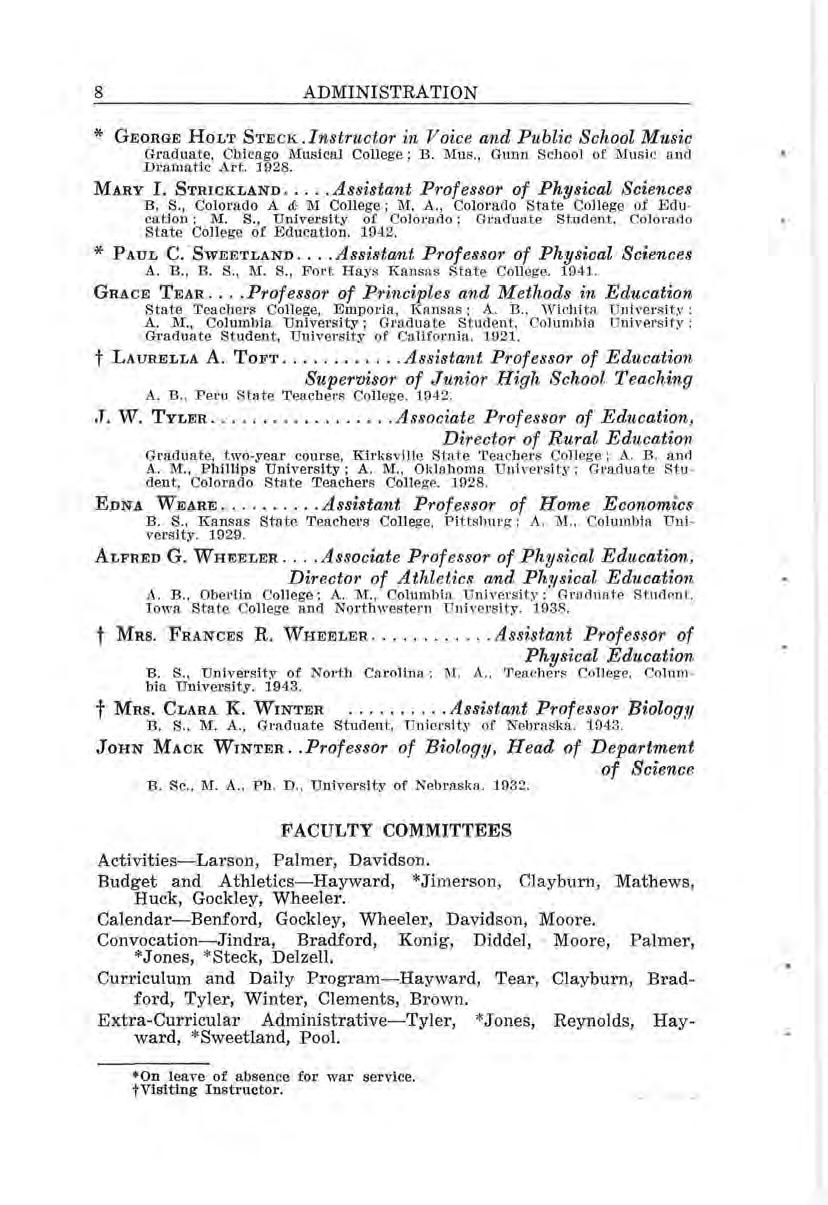
Activities-Larson, Palmer, Davidson.
Budget and Athletics-Hayward, *Jimerson , Cla.yburn , Ma thews , Huck, Gockley, Wheeler.
Calendar-Benford, Gockley, Wheeler, Davidson, Moore
Convocation-Jindra , Bradford, Konig, Diddel, • Moore, P a lmer, *Jones, * Steck, Delzell.
·curriculum and Daily Program- Hayward , Tear, Clayburn, Bradford, Tyler, Winter, Cl ements, Brown.
Extra-Curricular Administrative-Tyler, *Jones, Reynolds , Hayward, *Sweetland, Pool. ·
•on l eave of absen ce f or w a r service tVlsitlng Ins tructor.
Faculty Advisory and Graduation-Tyler, *Sweetland, Petersen, Winter. · ·
Faculty Meetings-Diddel, *Jimerson, *Miller, Martin, Brandt, *Steck, Redenbaugh.
Library-Petersen, Maxwell ; Bradford, Brown, Winter, Clements, Tyler, Konig, Larson.
Personnel-Maxwell, .Dunning, *Jimerson, Baker, *Brod, Gard.
Peru vian-Se nior, Junior, Sophomore, and Freshman Advisers
Social- Brackney, Weare, Gockley, Kenton, Mason, Hileman, McCollum, Delzell, *Harvey, Faulhaber, 'Kirk, *S teck, Toft, Bridgewater, Strickland, Gaines.
Teachers Bureau-Clements.
Welfare and Health- Henningsen, Davidson, Dunning, *Jimerson. Wheeler.
Faculty meetings are held on the third Thursday of each month from 0-ctober to May, inclusive, at 4:30 to 5:30 p. m.
Sigma Tau Delta-A. L . Bradford.

Kappa Delta Pi-P. A. Maxwell.
Tri Beta- J. M. Winter.
Alpha Mu Omega- Eloise Pool.
Epsilon Pi Tau-A. V. Larson .
Kappa Omicron Phi-Edna Weare .
Lambda Delta Lambda-Mary I. Strickland.
Commerce Cl~b-Nona Palmer.
Future Teachers of America- B. K. Baker.
Dramatic Club-R. D. Moore.
Internation;i.l Relations Club- C. M. Brown.
Y. M. C. A.-L. B. Ma.thews, A. R. Reynolds.
Y. W. C. A. - Mrs. Mary 0. Delzell, Edna Weare. College Catholic Association-E. H. Hayward.
Lutheran Club-Marie H . Faulhaber.
College Men's Club-E. H . Hayward.
College Girls' Club- Mrs. Inice M. Dunning. Scholarship Club____:S, L. Clements.
Art Club-Norma L. Diddel.
W. A. A.-Phyllis Davidson.
P. Club-A. G. Wheeler.
Seniors-A. L. Bradford.
Juniors-A. B. Clayburn:
Sophomores-A. V. Larson.
Freshmen-Grace Tear.
•on leave of absence for war service.
The General Catalog is intended to give such information concerning the Peru State Teachers College as may be desire d b y students planning to continue their education in a well -equipped state school. Because of limitation in s pa ce, some things may be omitted from the catalog, information conce rning w hich ca.n readily be obtained by writing to the Preside nt or to the Registrar at Peru, Nebraska.
The purpose of thi s college i s to train teachers for service in the public schools . Young people who have not fully d ecided on a life vocation may complete the academic work generally accepted for the freshman a nd sophomore years of any lib er al arts college. The Bachelor of Arts degree in education can only be conferred on those who have completed the four-year course, w hich includes the required pirofessi onal preparation f 9r teaching,
The institution is organized to include every ph ase of public school work-rural, lower grades, upper grade s, junior high school, senior high school, and the teachers college. Its purpose is to develop the best possible conditions for the child in the public schools and to supply the most effective training for h is teachers.
·Nebraska became a state, the L egislature provided for the establishment of a training school for teachers at Peru. It was the third state normal west of the Missouri River, only one State Normal School in California, and one in Kansas, having been established before Peru.
In 1867, the same year that
For thirty-eight years Peru was the only State Normal Scho ol in Nebraska. As the population increased, however, the Legislature · provided for three others. One was established at .Kearney in 1905, one at Wayne in 1910, and one at Cha.dron in 1911. In 1921 the legi slature extended the work of the Normal Schools from two to fo u r years and designated them as Nebraska State Teachers Colleges with authority to grant a Bachelor's degree which might be a Bachelor of Arts Degree in Education, a Bachelor of Sc ience Degree in Education, or a Bachelor of Fine Arts Degree in Education. Peru awards the Bachelor of Arts Degree in Education to tho se who complete the four-year course.
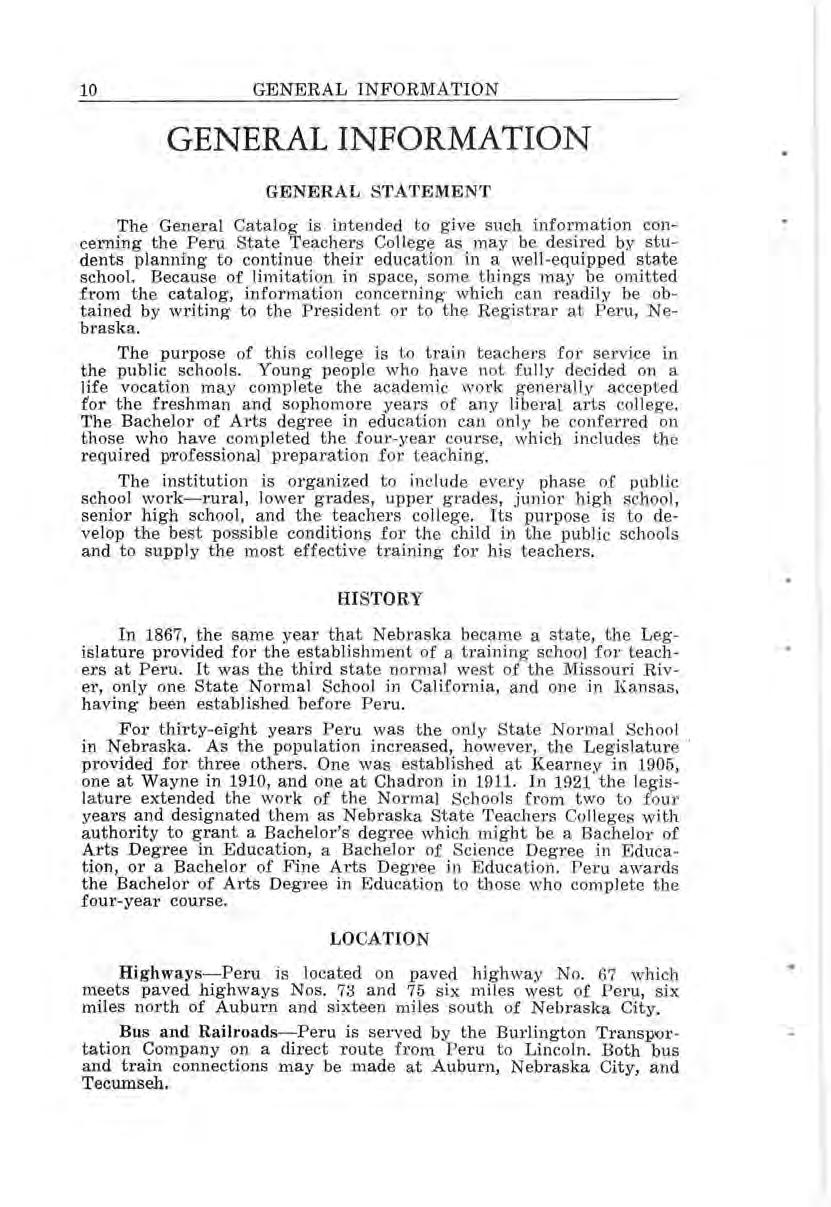
Highways-Peru is located on pa.ved highway No. 67 which meets paved highways Nos. 73 and 75 six miles west of Peru, six miles north of Auburn and sixteen miles south of Nebraska City, Bus and Railroads-..:Peru is served by the Burlington Transp'Ortation Company on a direct route from Peru to Lincoln. Both bus and train connections may be made at Auburn, Nebraska City, and Tecumseh.
The Administration Building houses the administrative offices, including the offices of the President, the Dean of Men and the Registrar. The remaining rooms in the building are class and lecture rooms and department offices. '
The Library Building contains the library of 52,000 volumes, the little theatre and class and lecture rooms. ·
Hoyt Hall, completed in 1930, is a three-story building designed especially for the departments of science. The building is divided into five units, each of which contains a lecture room, laboratory , office, and storeroom. The lecture rooms are constructed with elevated seats, and each room is equipped with a demonstration table. Gas and water are piped to all laboratory desks.
The Auditorium has a seating capacity of twelve hundred, and it is used for general convocations, music and dramatic productions, an d other assemblies.
The T. J. Majors Training Building houses the elementary school and the high school. It is furnished with modern public school equipment, and is the center of the observation and practice teaching work. ·
The Music Hall, known to former students as the science hall, was completely remodeled in 1935 to house the music department. On the first floor are individual practice rooms, a group rehearsal room, classrooms, .and studios, all of which are soundproofed. A small auditorium, which is used for recitals, school dances, and organization meetings, and two smaller meeting rooms are located on the second floor.
The Gymnasium, known to former students as the chapel, is now used by the departments of physical education. A swimming pool, shower and lock er rooms, and .a basket ball floor are a part of the equip ment in this building.
Mount Vernon Hall has rooming facilities for ninety women, Eliza Morgan Hall, opened September 1, 1929, accommodates one hundred and twenty women.
Delzell Hall, opened in the fall of 1939, accommodates one hun. dred twenty-four men,

The Infirmary is equipped to provide first aid- treatment and hospitalization for stud ents needing emergency medical care. Two hospital rooms, two isolation wards, a treatment room, and the nurse's quarters are housed in this building.
The Industrial Arts Building is equipped with classrooms, shops, and modern shop equipment for the department of Industrial Arts. The basement of this building houses the college po,wer plant.
The Peru campus overlooking the Missouri River is beautiful and distinctive. It contains .about sixty acres of rolling, oak-covered hills. A natural amp hitheatre furnishes a splendid athletic bowl, at the bottom of which lie the gridiron, the cinder track and the cement tennis courts. An excellent lighting system makes it possible to conduct athletic games at night.
Three clay tennis courts are provided for on the one-half block, located directly north of the campus, which was presented to the ·College in 1932 by the Peru Alumni .Associ8,tion.
Concerts, plays, lectures, and recitals are presented by students, faculty members and professional talent. Student-planned and student directed productions, through which students gain valuable and useful experience, are an outstanding feature of the entertainment program
Peru's splendid location in the rolling, wooded country along the Missouri River offers many op'Portunities for hikes and outings. The recreational facilities of the campus, including the basketball court, swimming pool, locker and shower rooms in the gymnasium, the five tennis courts, and two playing fields are available to all students. Intercollegiate and intramural sports programs are conducted for men, while the Women's Athletic Association carries on a program of sports for women.
Social activities, in the main, are centered in the various student organizations. Dances, teas, parties, receptions, and picnics are a part of the direct responsibilities of the social committees and provide opportunity for students to take part in both formal and informal social affairs.
Educational and Social:
The Student Advisory Council acts in an advisory capacity to the President of the College on matters of particular interest to the . student body. In addition, the Council acts as a sponsoring group for certain all-school activities, such as the annual Homecoming. Eight students elected annually from each of the four classes (two from each class) constitute the membership of the Council.

The Girls' Club, sponsored by the Dean of Women, is open to all college girls. Its purpose is to foster a spirit of friendship and mutual helpfulness among the girls enrolled in the college.
The Men's Club, sponsored by the Dean of Men, is open to all college men. It brings the men together to talk over school and professional problems.
Freshman Clubs, eight in number, were organized during the spTing of 1929. They are designed to entertain, to broaden the interests, and to give social training to young people coming to Peru for the first time. While only freshmen may be active members, upper classmen who have once joined may continue with the groups as associate members.
The Dramatic Club, one of the oldest dramatic organizations in the state, has striven throughout its existence to give to the college and the community the best in drama. Members are selected on the basis of interest, ability, and quality of their work.
The International Relations Club is conducted under the auspices of the Carnegie Endowment for International Peace, which supplies materials for study. Membership is open to any college student interested. The programs are arranged by a committee of four students elected by the members.
Religious:
The Y. M. C. A., the Y. W. C. A. and the College Catholic Association encourage the student fellowship and participation in the religious life of the school. Membership in these organizations is open to any student interested .
Music:
The Peru Singers is an organization devoted to the study and performance •of good choral literature. Members of the group may receive credit for their work by registering for Music 19, Chorus.
The College Orchestra is open to all students who play instruments. College convocation programs, concerts, and out-of-town engagements necessitate the mastery, by the members of this organization, of an extensive repertoire of orchestral literature.
The Band, uniformed in school colors is particularly active as a marching organization during the football and basket ball seasons. As a concert organization , it has gained a prominent place on the entertainment program.
Honor Societies:
Kappa Delta Pi is a national educational fraternity. It is open to both men and women of full junior standing who are in the highest fourth of the student body in scholarship and who show evidence of a continued interest in the field of education. Sophomores who meet the same requirements a.re admitted to pledge membership. The purpose of the organization is to promote the highest educational ideals and professional spirit among ~ts members.
Sigma Tau Delta is the national professional English fraternity, the purpose of which is to promote the mastery of written expression, encourage worth-while reading, and foster a spirit of fellowship among those specializing in the English language and literature. A major in English and high ·scholarship are the requisites, and the members assume the obligation to be productive in order that their scholarship may be effective, ·
Tri Beta is a national professional honorary biological fraternity. Its membership , includes those of junior and senior rank who are majoring in biological sciences. Candidates must be above average in scholarship and must intend to make biology their permanent interest. The fraternity aims to promote the study of biological problems and to interest students in the field of biology as a profession.
Alpha Mu Omega is an honorary mathematics fraternity. Its aim is to develop and promote interest in the study of mathematics and to investigate subjects of mathematical interest that are not presented in the class room. Students who are majoring in mathematics are eligible to membership. Meetings are held every two weeks when a program is conducted under the leadership of students. The fraternity has been officially recognized as a branch of the national Council of Mathematics Teachers,

Kappa Omicron Phi is an honorary national home economics fraternity. Members are elected from students who have completed a minor in the department with a grade average of "B" and have done satisfactory work elsewhere. '
Epsilon Pi Tau is a national honorary professional organization operating in the· fields of Industrial Arts Education and Vocational Education. The purposes and idea.ls of this fraternity are to recognize the place of skill, to promote social efficiency, and to foster counsel and reward research in the fields of interest. Members are selected from juniors and seniors who have an average of "B" or over in the department and are doing "C" work ,elsewhere.
Lambda Delta Lambda is a national honorary p•hysical science fraternity. The object of the organization i s to promote interest in the study of chemistry and physics and to encourage and recognize a high standard of scholarship in the work. Any regularly enrolled student of the school who has completed sixteen semester hours in chemistry or physics or both, or who at the time of pledging is taking sufficient work to total sixteen hours of work in these fields, and who has a "B" average in these subjects i s eligible to as so ciate membership.

Future Teachers of America is an honorar y fraternal organization of young men and women students who expect to teach. Admission is based upon those qualities most desirable in teachers, namely: scholarship, personality, willingness to accept responsibility, willingness to cooperate, professiona.J interest, and character.
The Scholarship Club is an organization for tho se students who hold Nebraska State Normal School Scholarships. The purpose of the organization is to permit these students to meet together once each month to get acquainted, to promote scholarship, and to cr eate professional interests. Students who hold high scholarships from other state s are eligible for associate membership. Since its organization in 1929, about 400 students have been members of the club.
Athletics:
The "P" Club is an organization of Peru letter men whose purpose is to foster the spirit of good sportsmanship. .
The W. A. A. is an athletic organization for girls under the leadership, of the director of physical education for women. It offers letters for satisfactory work in a program outlined by the association.
The Teachers' Placement Bureau is conducted for the purpose of helping students secure desirable positions. Graduates are not guaranteed positions, but every effort is made to locate worthy teachers in -satisfactory places. A fee of one dollar is paid b y each student . joining the Placement Bureau. The superintendent of the Training School is chairman of the Bureau.
The college nurse g ives practical instruction in school sanitation, in ca re of school children, and in guarding against contagious and infectious di se a ses . She has charge of the school infirmary where students may consult her, or, if necessary, she will attend them in their rooms. A fee of one dollar and fifty cents per day is charged for p erso n a l care in the infirmary . Howeve r, thi s pays only the infirmary fee and sh ould a do ctor be called, or medical supplies _ furnished, thi s expense is to be pai d by the student. Patients will be cared for in the infirmary no longer than required to communicate wi th th eir parents or friends and mak e arrangements for their safe removal.
When a stud en t enters coll ege h e is confronted with many p,erplexing problems. H e meets many difficulties in adjusting himself to the coll ege situation Problems of' the proper bafance between stu d y and recrea.tion; wh en an d h ow to study; college friendship s, se lection of studi es and the formation of a de sirable schedule; the sel ectio n of the most d esirabl e field of education in which to specialize; social life; participation in the traditions and customs that make up sch oo l spirit, all confront the s tudent during his first year in coll ege. Th e manner in which ad justments are made to these problems d etermin e the s u ccess and happiness of the student, in college life, an d to a large extent, at lea s t, in later life.
Stud en t s are aided in making such ad justments by several , agencies The dean of men and d ean of women •g ive mu ch general counsel on these matters Other problems a re cared for by the freshman adviser in the freshman clubs and in the course: Introduction to Educati on. Still furth er assistance is rend ered b y the advisers f'or subject majors a nd minors. Th e p ersonn e l committee conducts a testing pro- · gram and passes on curricular load. The extracurricular administrative committee a djusts extracurricular load

On grad uati on , a number of classes have l eft memorials consisting of pictures, tablets an d vario us mementos. The Fortnightly Art Club ha s contributed a frieze, s t at uar y and other works of art. The clo ck in th e library was the g ift of the class of 1903; the drinking fountain of the class of 1911; th e campus e lectroliers of the class of 1914; th e p ortal s of the north en tran ce of the class of 1915; the sundial of the class of 1920. Th e cl ass of 1924 built a cement walk from the pavement to the athletic field. ·The cl ass of 1927 contributed $2 10, the class of 1928 an additi onal $2 10, the Philomathean Literary Society con tribu ted $100 and the cla ss of 1930, $150, to be expended for an electric bell system , w hi ch i s now installed. The fountain in the ros e ga rden east of the a dministratio n building and south of the audi torium was t h e gift of the cla ss of 1929. The electric fans in the library were given b y the classes of 1931 and 1932, and those in the auditorium b y the classes of' 1933, 19 34, and 1935. The water fountain in the science hall is the gift of the class of 1936.
The class of 1913 founded what is known as the Student Loan Fund with an initial gift of $50.00. Other classes, the Nebraska State P. E. 0 . of 1929, and interest accumulations have increased the fund until it now totals approximately $2500.00.
The fund is in the custody of the Registrar, who receives all loan applications. They are acted upon by a faculty committee in the order that they are received. When approved, loans are made as the money becomes available. Prompt payment is necessary in order that help may be given to as large a number of college students as possible. The funds were not given to assist teachers in service or persons wishing to attend other colleges.
In order to receive the approval of the committee, the app,Jicant for a loan must show (1) that he is enrolled in the college, (2) that he is planning to teach, (3) that he is in need of the money, and ( 4) that he is unable to secure it elsewhere. He must furthermore present ·a note signed by himself and by some co-maker who is financially responsible. A reasonable interest charge is made,
The Girls' Club maintains a loan fund of approximately $1000 for the benefit of any regularly enrolled college girl who may need the help of (a) a small loan ($10- or less) for an emergency expenditure, or (b) a larger loan (maximu.m is $50) to take care of a part of the expenses of a school term. The small loans are usually made for short periods of a few days, while the larger loans may run for several months or until the borrower is employed.
Applications are made through the Dean of Women and are referred to the Girls' Club Council, which acts on all applications.
The Peru Branch of the American Association of University Women maintains a loan fund of $50.00 as a memorial for Miss Anna Irwin, who was a former member of the Peru faculty and the first treasurer of the local chapter A.A.U.W. Women students within a s emester of a two or three-year diploma or the A. B. Degree are eligible to apply for a loan. When the fund is available, a notice is published in the college paper.

The dramatic club awards are made each year to the senior man and the senior woman who have contributed most to dramatics during their four years of participation in college dramatic activities.
Miss Louise Mears, a former member of the faculty of Peru has established a medal to be awarded for achievement in geography. This medal is awarded annually to a student of Senior College rank, who contributes the most outstanding piece of original investiga.tion of some phase of the geography of Nemaha County. The medal award carries with it a stipulated amount to be used in carrying forward the research and the preparation of the final report for permanent filing.
The University of Nebraska awards annually a tuition scholarship in the Graduate College to one member of the graduating class whose record places him in the upper ten per cent of his class. In 1942 two scholarships were awarded-one to Rose McGinnis and one to Ella Mae Hurlburt
Bert E. Swenson, '09, and Stella Spillner Swenson , '09, have given to Peru an athletic medal, which is awarded annually, in memory of their son, Bert Edward, Jr.
Juniors and seniors are eligible, and no student shall rec eive theaward more than once.
Bas is for judging- 100 points
(a) General
l. Character and personality _____________ 15 p0int s
2. Scholarship __ 15 point s
3. Loyalty to school traditions __ 20 points
(b) Athletics
1. Must receive school letter in at least two different sports. They need not be made in any one year _ 50 points
Note- A student who receives a third letter will receive additional consideration in connection with point "a-3".
Medals have been presented each year since 1925. The 1942 award was made to Robert Henderson, Anderson, Iowa.
The Alpha Mu Omega (Mathematics Club) award is . made annually to a member of the freshman class for excellence in Mathematics . The 1942 award was made to Harold Snow, Auburn.
Kappa Delta Pi Educational Award
Beta Mu Chapter of Kappa Delta Pi, national honorary educational fraternity, annually bestows upon the freshman whose scholarship and professional attitude are outstanding, a suitable award. The 1942 award was made to Dennis Wehrmann, Wabash.
Sigma Tau Delta Freshman Medal
The Sigma Tau Delta Freshman medal is awarded annually to the author of the best written contribution submitted in a contest open only to students registered as freshmen. The type of writing for the contest is to be decided each year by the fraternity. The 1942 award was made to Wallace Cleaveland, Peru.
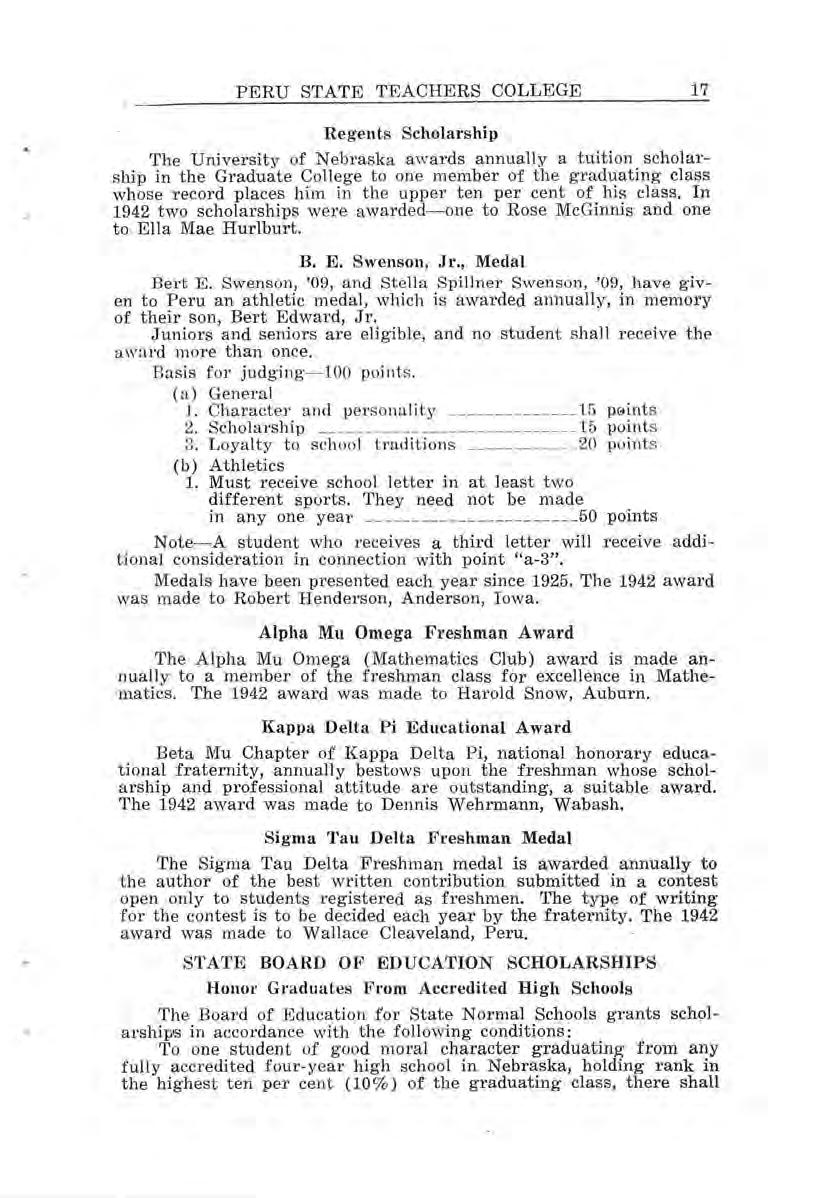
The Board of Education for State Normal Schools grants scholarships in accordance with the following conditions:
To one student of good moral character graduating- from any fully accredited four-year high school in Nebraska, holding rank in the highest ten per cent (10 % ) of the graduating class, there shall
be awarded a free scho larship to any of the State Teachers Colleges in th e State. The selection of the student sha]] be left entirely to the discretion of the superintendent or principal of the high school and the Board of Education of such high schoo l. This scho larship is not transferrable from individual to individual; it entitles the holder to exemption from fees, amounti ng· to not to exce ed $37.50 per year of nine months, excep t the matricul a tion fee, tuition, dormitory rent, p,rivate le ssons in music a nd speech, bre akage charges, and such deposit s as may b e required for the return of equipment lent to the student.
Any student holding this scholarship i s entitled to exemption from fees, with the excep tion a bove set forth, to the amount of not t o exceed $9 .25 for a nine weeks' term of s ummer school and $6.25 for a six weeks' t erm of s ummer school, from the amount of this s cholarship.
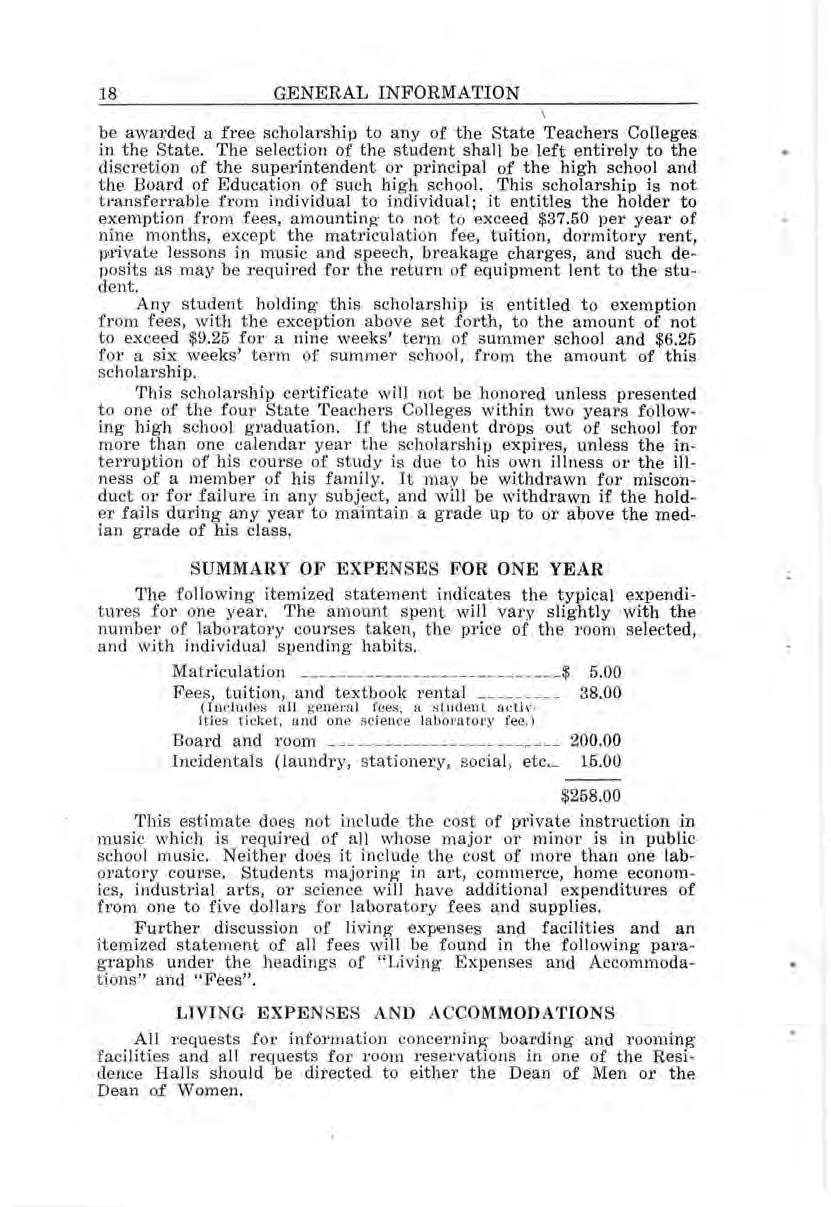
This scho lars hip certificate will not be hono red unless presented to one of the four State Teach e r s Co ll eges within two years following hi g h school graduation. If the s tudent drops out of schoo l for more tlian one calendar ye ar the scho larship expires, unless the interruption of hi s course of stud y i s du e to hi s own illness or the illness of a member of hi s family It may be withdrawn for misconduct or for failure in any s ubject, and will be withdrawn if the holder fail s during any year to maintain a gra de up to or above the median grade of hi s class.
The following itemized s tatement indicates the typica l expenditures for one yea r Th e amount spent will vary slightly with the numb e r of laboratory courses taken, the price of the room s elected, and with individual s pendin g habits .
(Includes a ll g en era l fee s, a s tude n t a ctivities tick e t, and one s ci en ce l a b ora t ory fee )
Thi s estimate doe s not in cl ude the cost of private instruction .in music w hich i s required of all w ho se major or minor is in public sc ho ol mu s ic. Neither do es it includ e the cost of more than one laborator y course . Students majoring in art, commerce, home economics, industrial arts, or s ci en ce wi ll hav e addition a l expenditures of from one to five dollars fo r la borator y fees and supplies.
Further dis cussion of livin g expenses and facilities and an it emized statement of all fees will be found in the following paragra ph s under the h ea din gs of "Living Expenses a nd Accommodat io n s" and "Fees".
A ll r eq u es t s for information concerni n g· boarding and rooming fac ili ties and a ll requests for r oom reservations in one of the Re s idence Hall s should be directed to either the Dean of Men or the Dean of Women.
Residence Halls-The College Residence Halls offer attractive living accommodations near t)1e classrooms and the library. Two halls are maintained for women and one for men.
A deposit of $2.00 is required of each student, applying for a reservation in .any of the halls. After a room is occupied, this amount is retained as a deposit against misuse of equipment, and it must be maintained at this level at all times.
A refund of the full ar~ount of the dep~sit, or the unused portion, will be made when the student leaves the college. A refund of the deposit less fifty cents will be made in case cancellation of a reservation is made four weeks before the opening of the session.
Rental is charged only for the time school is in sessio~, and a student who stays at one of the halls during a vacation poeriod will pay the established rate for his ro'om.
Students are .allowed to have radios in their rooms, but a charge of fifty cents per month is made for each radio. Since the electric current on the campus is 220 volt a. c., radios must be equipped with a transformer.
Halls for Women-Eliza Morgan and Mount Vernon Halls for women are under the supervision of the Dean of Women. The price of rooms ranges from $1.00 to $1.75 a week per student, two students occupying a room, with the majority of rooms in Mt. Vernon Hall renting for $1.25 and the majority of rooms in Eliza Morgan Hall renting for $1.50. All rooms are arranged as combination sleeping and study rooms. In Eliza Morgan Hall rooms are equipped with twin beds and lavoratories. Residents of both halls must furnish bed linen, blankets, ·towels, dresser scarfs, and curtains. They are expected to take their meals a.t the college cafeteria.
Men's Hall-Opened in the f,all of 1939, Delzell Hall has facilities for one hundred twenty-four men and is under the supervision of the Dean of Men. Rooms rent for $1.5() per week per student (corner rooms $1. 75), two students occupying a room . All rooms are ai·ranged as combination sleeping and study rooms an.d are equipped with twin beds and lavoratories. Residents of the hall furnish be,l linen, blankets, and towels. Curtains and rods are furnished by the college at a rental charge of 50c per person per semester (summer session 25c).
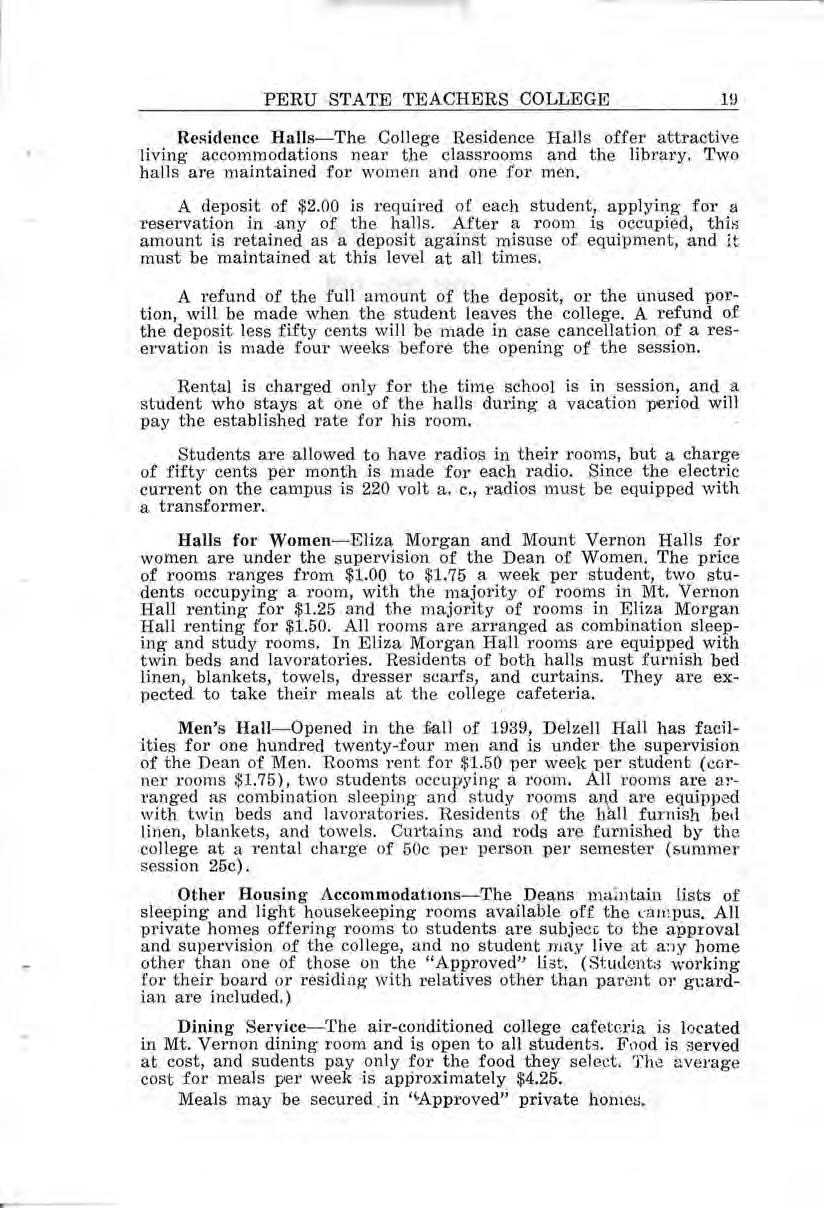
Other Housing Accommodations-The Deans maintain lists of sleeping and light housekeeping rooms available off the can,pus. All private homes offering rooms to students are subjecc to the approval and supervision of the college, and no student may live at a:iy home other than one of those on the "Approved" Ii .st. (Student::i working for their board or residing with relatives other than parent 01· gt:ardian are included.)
Dining Service-The air-conditioned college cafeterir. is l ocated in Mt. Vernon dining room and is open to all student.~. Food is served at cost, and sudents pay only for the food they select. The average cost for meals per week -is approximately $4.25.
Meals may be secured in '•Approved'; · private hornet:.

To s tudents leaving college within two weeks a fter registration for the first or second semesters :
1. Instrument and key deposits will be refunded when the ke y s or instruments are returned in good condition.
2. Material deposits , in so far as they represent the value of unused materials, will be refunded .
3. The Textbook deposit, exclusive of the rental fee, will be refunded when the student has returned, in good condition, all books which he has withdrawn from the library.
4. Ninety per cent of all tuition, library, infirmary and depar tmental fees, typewriter and piano rentals (with reasonable deductions for any service received), and the remainder of the contingent fee after deducting the full admission price of each event up to the time of the student's withdrawal from college.
5. Dormitory room refunds, If the room is released by Saturday night of the first week o~ school, a 50 per cent refund will be given. If released after the first week for any cause other than illness, students shall pay a transient rate of fifty cents per day a~d

the balance will be refunded, provided that in no case shall more than 50 per cent of the rental be refunded. No refund whatever is made to students who transfer from dormitories to local rooming houses, unless room made vacant, is filled by a new student entering schoo l, in which case refund in fu]] may be made. If student is compelled to leave school, because of continued illness, upon proper endorsement of the college nurse and doctor, a refund of 50 per cent of unused rental may be made.
To students leaving college within more than two weeks after registration for the first or second semest er:
1. Instrument and key depo s it s will be refunded when the keys or instruments are returned in good condition
2. ·Material deposit s, in so far as they represent the value of unused materials, will be refunded.
3. The textbook depo sit, exclusive of the rental fee, will be refunded when the student has returned, in good condition, all books which he has , withdrawn from the library
4 Ninety per cent of typewriter and piano rental in so far as they represent service not already received, and the remainder of the contingent fee after deductin g the full admission price of each budget event up to the time of the student's withdrawal from college will be refunded.
To students changing program s after registration:
1. Students changing their programs after registration shall , on presentation of their receipts, receive a refund of the amount of difference in fees between their altered program and the preceding one.
Nonresident students will be charge d fees in accordance with the following enactment of the Nebraska legislature, passed in 1923, and put into effect at Peru in September of that year:
"All state educational institutions sha]] charge a nonresident fee to each nonresident of Nebraska, who sha.]J matriculate after taking effect of this act. This fee shall not be less than the fees charged to residents of Nebraska for a similar course of study in a corresponding institution by the state in which such nonresident has his home."

Students are classified as follows: le ss than 26 hours, freshmen; 26 to 55 hours, sophomores; 56 to 87 hour s , juniors; 88 to 125 hours, seniors .
Students whose total number of hours a.t the end of the first semes t er permit them to change classification, may d o so provided they secure written permi ss ion from the registrar and both c lass advisors concerned by th e close of the first quarter.
A unit applies to high schoo l or secon d ary sub jects used for entrance to the College. A "unit" is the credit received for a subject carried five hours per week, with the requii;:ed preparation for a period of thirty -s ix weeks.
A "sem ester hour " apP'lies to college work and represents the completion of a total of three hours of work per week for one semester (18 weeks), consisting of lecture s, recitation s, preparation or laboratory.
Seventeen hours, one of whic h must be in physical edu cation, or 16 hours without physical e du catio n, is the maximum credit which may be earn ed by a freshman during his first semester in co ll ege After his first semester a st ud e nt may register for any 17 hours ,. ~nd under ce rtain conditions he may take one additional hour as follows: After one semester ( or its eq uiv a len t in summer sessions) a stud ent may register for one a dditional h our in a semes t er or in a s umm er session , (1) if he h as d emonstrated s uperior scholarship, or (2) if he secures the permfa s ion of the faculty personn el committee. A · student who qualifies for the privilege of registering for on e additional hour because of superior sch ol ars hip must have completed a minimum of 16 hours in his preceding semester (6 in a short summer session or 8 in a long s umm e r session) and must hav e earn ed a grade point ave rage of 2.2 with no mark below "C". No more than 18 h o urs may be earned in one semester.
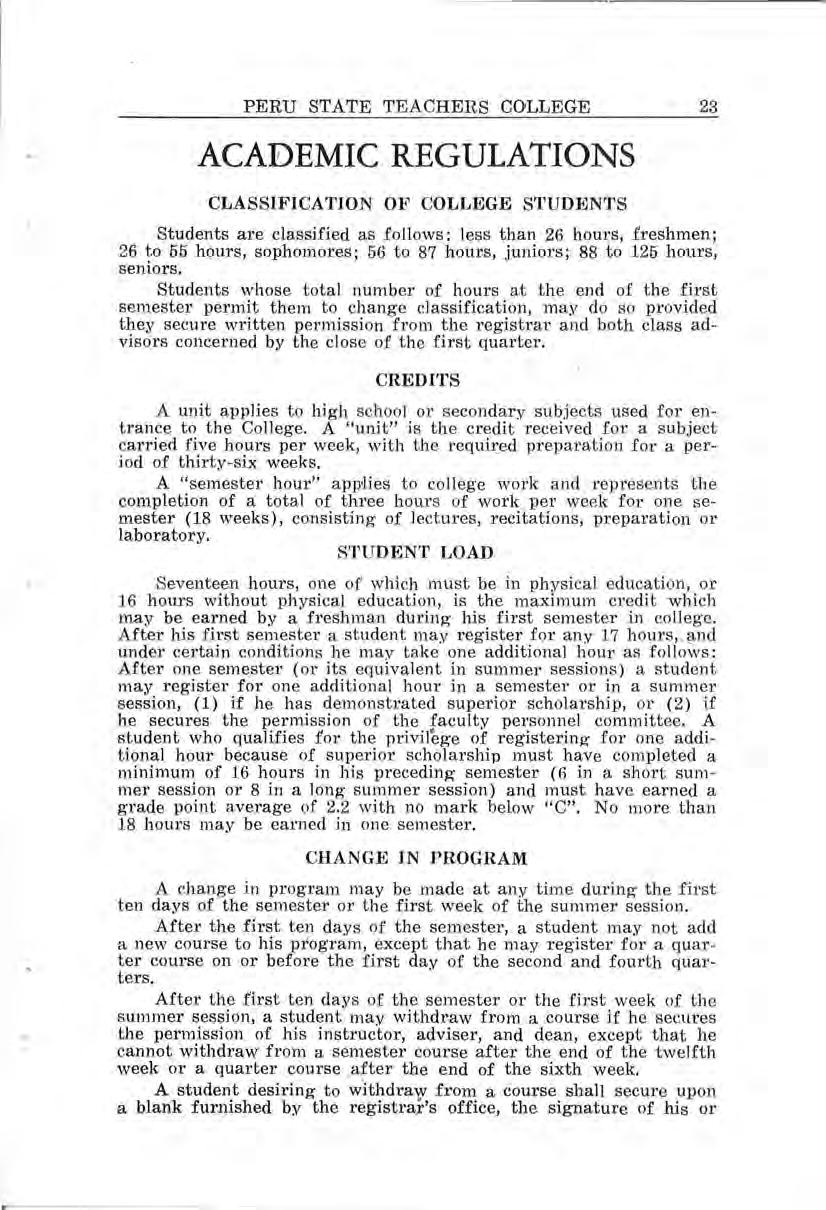
A ch ange in program may be made at any time dur ing the first ten days of the semester or the first week of t h e summer session .
After the first ten day s of th e semester, a student may not add a new course to his program, except that he may register for a quarter course on or before the first day of the second and fourth quarters.
After the first ten day s of the semester or the first week of the s ummer session, a student may withdraw from a course if he secures the permission of his instructor, adviser, and dean, except that he cannot withdraw from a semester course after the end of the twelfth week or a quarter course ,after the end of the sixth week.
A student desiring to w·ithdraw from a course shall secure upon a blank furnished by the registra,r's office, th e signature of hi s or
her adviser, instructor in charge, and dean The instructor in charge will also at the time assign the grade for the course in accordance with the grading system.
If a student desires to withdraw from the college, he . must secure the permission of his dean If he leaves the college and for some unexpected reason is unable to return, he should communicate immediatel y with his dea n, setting forth the reasons preventing hi s return .
Attendance is required at all classes and convocation
A student who finds it necessary to be absent from any class or convocation must, not later than the da y following his return p:r:esent to the instructor in charge a DEAN'S PERMIT TO RE -ENTER CLASSES.
In order to distribute the responsibilities of student organization office s, and in order to afford wider opportunities for participation in extra-curricular activities, the extra-curricular administrative committee has put into effect two regulations as follows:
1) In no instance shall any student hold more than two organization offices simultaneous ly, and these shall be distinctly different in nature. For the purpose of administering this section ; organization offices are to include the editorship of the Pedagogian and the editorship and business managership of the Peruvian, each of which is to be considered in the nature of and equivalent to the presidency of any campus organization.

2) Whenever it appears to the extra -curricular administrative committee that a student's tota.I working load, including all curricular, extra-curricular, and self-sup<porting activities, is excessive, such student will be required to reduce his working load.
The following grading system is used:
"A" to be interpreted as EXCELLENT work. (This grade will be given only for ability and performance of an exceptiona.Jly high quality.)
"B" to be interpreted as ABOVE AVERAGE work. (This grade will be given for ability and performance distinctly above the average.)
"C" to be interpreted as A VERA GE work. (This grade will be given for good work where ability and performance are of medium or average quality.)
"D" to be interpreted as BELOW A VERA GE work. (This grade will be given for ability and performance of only fair to poor quality, distinctly below average, but still passing.)
"E" to be interpreted as, FAILING work. (This grade will be . given where the quality ·of work does not justify credit. A failure can be removed only by repeating the course.
"Inc." Incomplete. An incomplete becomes a failure if not removed during the semester after the incomplete occurs.
"W" Withdrew in good stan ding. (This mark to be given for a course from which the student withdrew and was passing at the l ast attendance of class . This does not carry make -up privileges.)
(See "Chan ge in Program" for withdrawal procedure.)
"WE" Withdrew failing. (This mark to be given for a course from which the student withdrew and was failing at the last attendance of class. This does not carry make -up privileges.)
Student s failing, during a particular semester, to pass one -half of their work, may in the discretion of the President, aided by the student's adviser and the Personnel Committee, be excluded the followin g semester. • Students excluded for poor scho larship may rgister thereafter only by special permission of the Presid()nt.
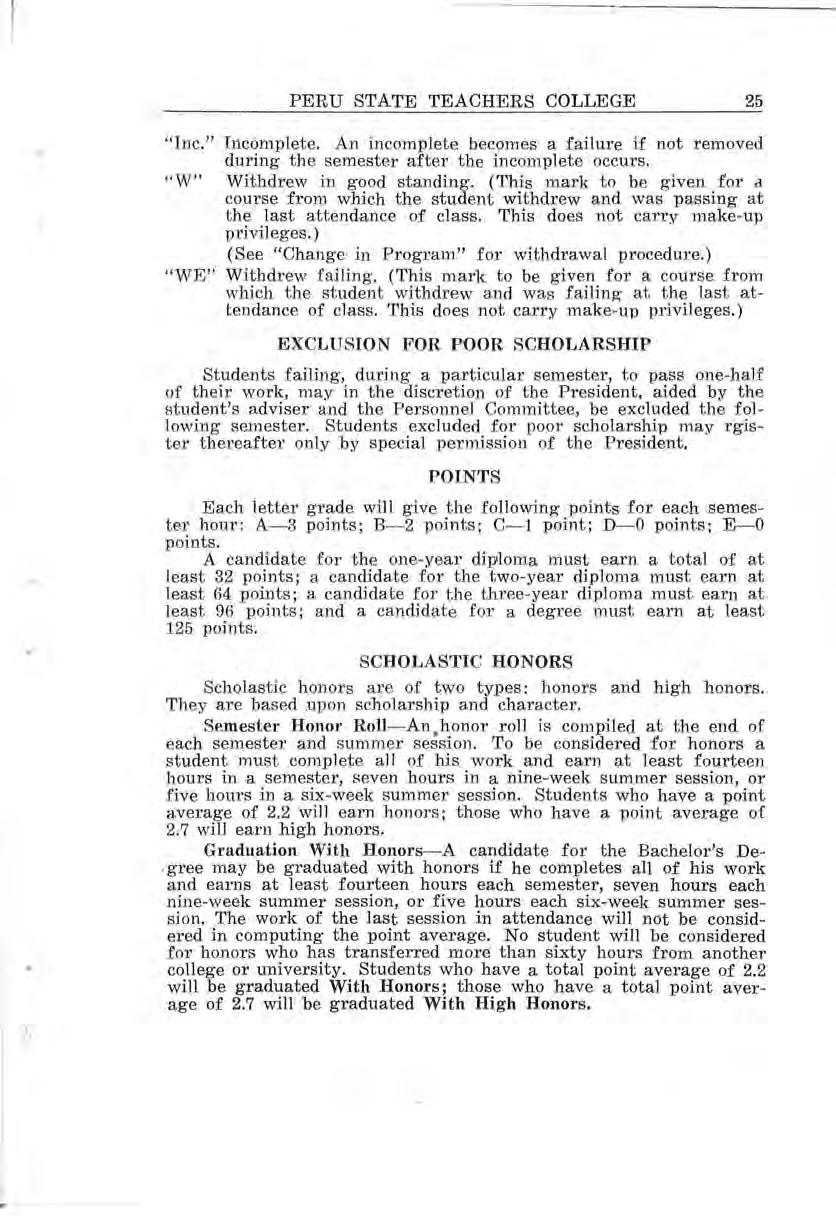
Each letter grade will give the following po ints for each semester hour: A-3 points; B-2 points; C- 1 point; D- 0 points; E - 0 points.
A candidate for the one -year diP'loma must earn a total of at least 32 points; a can didate for the two-year diploma must earn at least 64 points; a can didate for the three -year diploma must earn at least 96 points; and a candidate for a degree must earn at least 125 points.
Scholastic hon ors are of two types : honors and high honors . They are based .upon scholarship and character.
Semes ter Honor Roll- An , honor roll is compiled at the end of each semester and summer session. To be considered for honors a student must complete a ll of his work and earn at least fourteen hours in a semester, seven hours in a nine ~week summer session, or five hours in a six-week summer session. Students who have a point average of 2.2 will earn honors; those who have a point average of 2.7 will earn high honors.
Gradua,tion With Honors-A candidate for the Bachelor's De, gree may be graduated with honors if he completes all of his work and earns at least fourteen hours each semester, seven hours each nine-week summer session, or five hours each six-week summer session. The work of the last session in attendance will not be considered in computing the point average. No student will be considered for honors who has transferred more than sixty hours from another college or university. Students who have a total point average of 2.2 will be graduated With Honors; those who have a total point average of 2.7 will be graduated With High Honors.
Admission Forms- Students should have a transcript of their high school credits prepared on the Nebraska College Admission Form and sent to the registrar at least ~wo weeks before the opening of the term. Copies of the admission form may be secured by writing the registrar. Transcripts of credits and other credentials which are accepted toward admission become the property of the college and are kept permanently )!'I the files,
To Freshman Standing-Graduates of accredited high schools ·may have full admission to freshman standing on 15 units (conditional 14 units) properly selected and completed in a four-year high school or on 12 units ( conditional 11 units) properly selected and completed in a senior high school (grades 10, 11, and 12).
The required credits shall include not fewer than eight units earned in grades 9, 10, 11, and 12 in the fields of English, foreign language, mathematics, natural science, and the social studies. Of these eight units seven shall be grouped in the following manner. A major of three units in English and two minors of two units each. The two minors shall have been completed in grades 10, 11, and 12, except that one unit of a foreign language, or one unit of mathematics, or both, earned in grade 9 may be used in completing the minor requirements.
If the student does not s ubmit these subjects for college entrance and in lieu of them submits other credits acceptable to the institution, he must take these subjects in college courses for which he may receive elective college credit.
Students who are not high school graduates may receive conditional admission upon presentation of 14 units from an accredited four - year high school), or 11 units from ff senior high school (grades 10, 11, and 12). An official transcript of credits and a request from the superintendent that the student be admitted before graduation must be filed with the registrar.
Advanced Standing- Applicants for admission from other colleges or universities must file with the registrar (1) a statement of honorable dismissal; (2) an officially certified statement of college work already accomplished; (3) an officially certified record of the secondary school work satisfying the admission requirements.

Full credit is given for work completed at institutions which maintain standards of admission and graduation equal to those of Peru.
College credit may be given for work done in a secondary school for not to exceed 9 semester hours and then only on condition that it all be included in entrance credit which the applicant presents in excess of 16 units of secondary work. Credit is allowed only in applied music, chemistry, Greek, mechanical drawing, solid geometry, trigonometry, third and fourth-year German, third and fourth-year French, third and four-year La,tin, . and fourth-year English. To receive college credit for such work, appllcation must be made at the time of first registration in the tea.c!J.ers -college, and the examination
must be taken by the end of the first semester. A special examination fee of two dollars is charged. These transferred secondary credits ma,y be u s ed for electives but may not be used to meet the requirements for majors and minors or group requirements for an A. B. degree.
Adult Special-Mature individuals who do not have full college entrance credits may be matriculated as adult specials, but before any certificate or diploma may be granted to such students all entrance requirements must be made up and all collegiate requirements for the certificate or diploma sought must be met.
No student will be granted a degree or diploma until he has fulfilled the entrance requirements.
A minimum of thirty-six weeks of attendance and thirty semester hours of residence credit earned at this college are required for the issuance of a degree or a diploma. Twenty-four of the last thirty hours of work for the degree and twelve of the last sixteen hours o-f work for a two- or a three-year diploma shal! be earned in residence at this college. (Applies to all candidates for degrees and diplomas to be issued on or after September 1, 1942. )

The Peru State Teachers College issues by authority of law and rules of the State Board of Education a degree and diplomas as follows:
1. Bachelor of Arts Degree in Education.
2 Three - Year Diploma.
3. Two -Year Diploma.
4. One -Year Diploma .
On completiori of the requirements for a degree or one of the diplomas a student may be ·recomrg.ended to the State Superintendent of Public Instruction for a teaching certificate of the type to which his preparation entitles him.
Attendance at Commencement- Attendance at the commencement exercises is required of all candidates for degrees and diplomas who are in residence during the second semester.
The various curricula are planned to train teachers for two distinct types of teaching-elementary and secondary-and it is to the student's advantage to decide whether he wishes to prepare himself for elementary or for secondary teaching and to follow one curriculum throughout the four years . Students who transfer from one curriculum to another cannot do so without some loss of credit. Only those students majoring in Elementary or Early Elementary Education may count the following courses toward a degree: Art 103; Education 132, 150, 153, 202a, 202b, 231, 205-305, 303, 323; English 103; Geography 202; Industrial Arts 112; Music 110.
REQUIREMENTS LEADING TO THE BA CHELOR OF ARTS DEGREE IN EDUCATION AND ONE OF THE FOLLOWING CERTIFICATES :
NEBRASKA PROFESSIONAL SENIOR GRADE SCHOOL CERTIFICATE: NEBRASKA INI'.rIAL SEC ONDARY SCHOOL CERTIFICATE ; AND NEBRASKA INITIAL ADMINISTRATIVE AN D SUPERVISORY CERTIFICATE

The am ount of work required for the Bachelor of Arts Degree in Education is 125 semester hours (120 during the period of the war emergency) including 26 hours in professional work, 40 hours of credit in junior and senior courses, 125 honor points, a major and two minors.
"Elec tives" on next page In making up your program
sections on "Majors
studies follow one of the outlines beginning on page 30.
* Students who c omplete t he one- ot· two -year rural cour:e m ay s ub stitute Education 150 for Education 108.
t Students who take Education 2 0 4 for the two -year diploma need not tak e Education 3 04 for the degree
Two hours of te ac hing must, be clone in t he seniol" year. Teachers of high school s ubj ects ancl special subjects tak e 4 hours of teaching ; teachers of eleme ntary g rades take 6 hour ~
The selection of a major of at least 20 hours and two minors of at least 15 hours each must be made not later than the beginning of the sophomore year. Majors and minors may be selected from the following d epartments: Art, Commerce, Education, English, Foreign Languages, Geography, History and Other Social Sciences, Home Economics, Industrial Arts, Mathematics, Music, Physical Education (Men and Women), Science. Requirements for majors and minors in the various departments and divisions thereof are to be found under "Courses of Instruction." (See page 42 ff.). Credit transferred from secondary work may not be used to meet the major and minor requirements.
The subjects of the minors must be in departments other than the major; however, a major and a minor or two minors may be earned in the same department provided that each is entirely within a different division of that department.
Credits transferred from another college may be used to meet major and minor requirements under the following conditions:
(a) Each department head under whom the majors and minors are to be earned must approve the credits transferred to his department.
(b) Under the guidance of the department heads at least one course in each major or minor must be earned in this institution.
Not more than 40 hours of work in any one departmei.t may be applied to a degree, unless a stu dent makes application to and is granted permission by the curriculum committee.
Not more than 6 hours may be earned in physical exercise unless physical education be made a major or minor.
Not more than 5 hours in applied music nor more than 3 hours in ensemble music may be applied "to a degree unless public school music be made a major or minor. Public school music majors and minors may count 8 hours of applied music and 6 hours of ensemble music toward a degree.
Not more than one -fourth of any curriculum leading to a degree shall be taken in extension classes or by correspondence; and not to exceed one -ha):!'. of this amount shall be taken by correspondence.
Foreign language is not required of candid:ates for the bache lor's degree, except of those who are majoring or minoring in the field. However, since many students will even tuall y want to continue their training in a gra duate school, it is suggested that they read carefully the statement on page 55 under "Modern Language" relative to the foreign language requirement for the master's and doctor's degrees.

FOUR-YEAR PROGRAMS LEADING TO A DEGREE FOR TEACHERS OF SECONDARY SCHOOL SUBJECTS AND SPECIAL SUB JECTS
Suggested
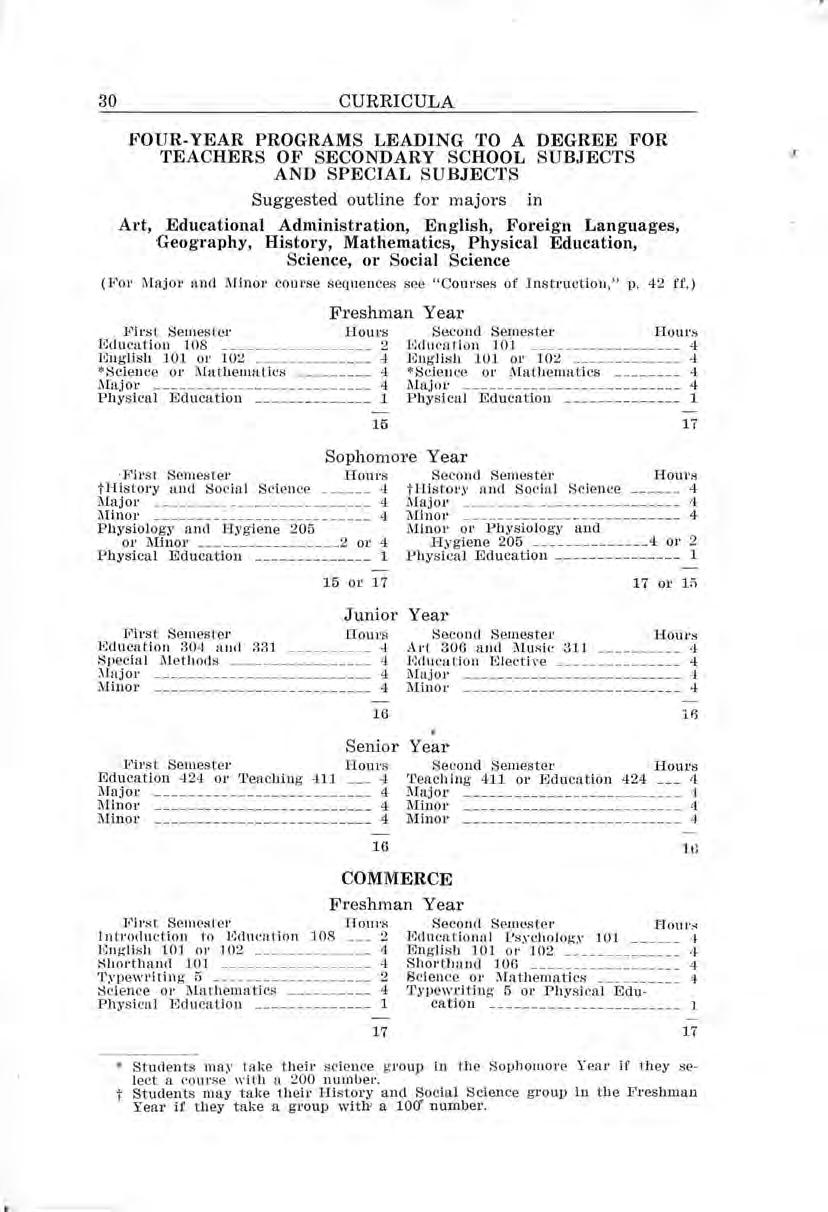

* This requirement may be co mpe t ed in either the freshman or sophomore year.

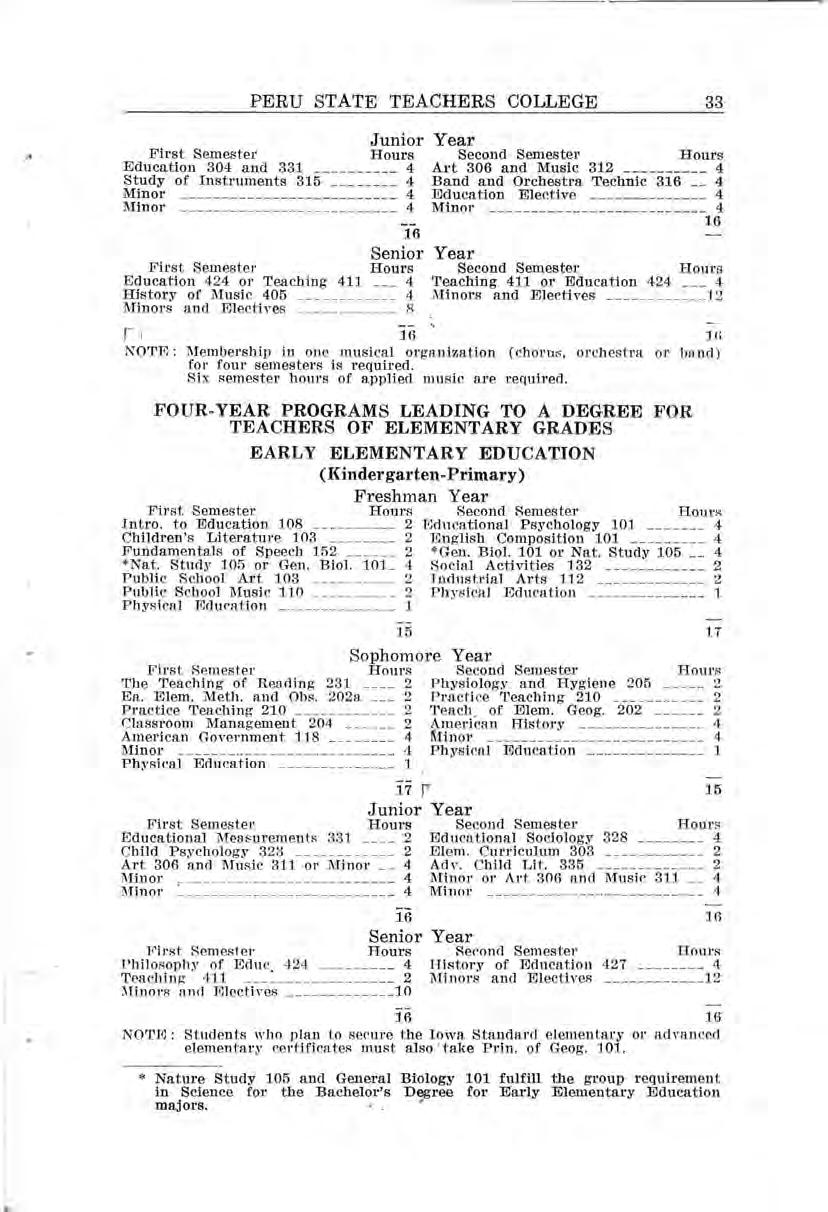

The amount of work required is 96 semester hours (90 during the period of the war emergency), including 15 hours in education of which 3 must be in practice teaching, and 96 honor points In addition, the student must fulfill the requirements of ONE of the following three paragraphs. ·
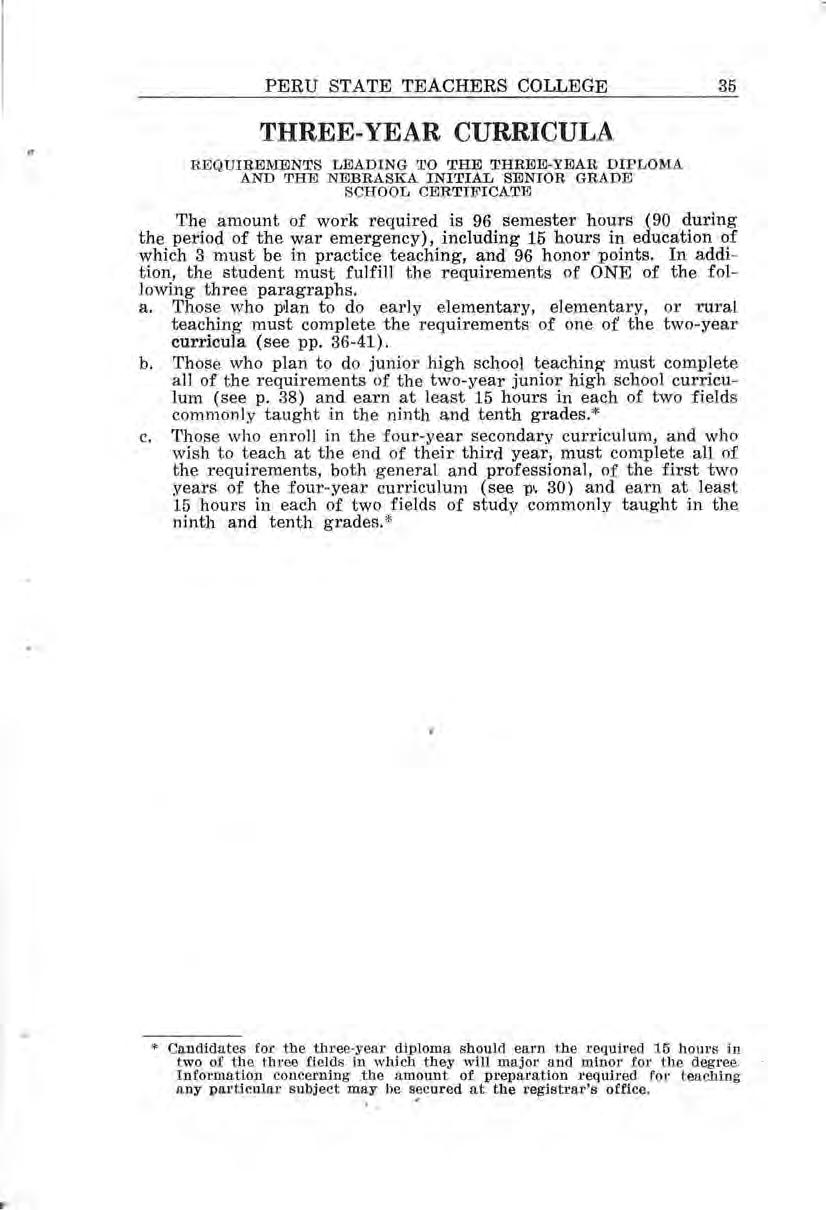
a. Those who pilan to do early elementary, elementary, or rural teaching must complete th e requirements of one of the two -year curricula (see pp. 36-41).
b. Those who plan to do junior high school teaching must complete all of the requirements of the two-year junior high school curriculum (see p. 38) and earn at least 15 hours in each of two fields commonly taught in the ninth and tenth grades. *
c. Those who enroll in the four-year secondary curriculum, and who wish to teach at the en d of their third year, must complete all of the requirements, both general and professional, of the first two years of the four-year curriculum (see p•. 30) and earn at least 15 hours in each of two fields of study commonly taught in the ninth and tenth grades.*
• Candidates for the three-year diploma should earn the required 15 hours in two of the three fields in wh i ch t hey will m a jor and minor for the degree . Information concerning the amo unt of preparation required for teaching a ny particular subject may be s~c ured at the registrar's offi~e.
Sixty-four hours (60 during the period of the war emergency) and 64 honor points are required. Not less than 16 nor more than 24 hours must be in courses in education.
In addition to the above all of the departmental requirements· for one of the two-year curricula must be met, and, if possible, the freshman and sophomore courses in each of two minor fields should be completed. Departmental requirements for each of the five twoyear curricula will be found as follows: Early Elementary Education, page 37; elementary Education, page 37; Junior High School, page 38; Public School Music , page 39; Rural Education , page 39.

Four hours is the ma.ximum which may be earned in physical education. ·
Three hours is the maximum credit which may be earned in applied music or ensemble music. Only one hour may be earned in ensemble music in one semester.
Not more than one-fourth of any curriculum leading- to a diploma shall be taken in extension classes or by correspondence and not to exceed one-half of this amount shall be taken by corresponence.
t Rur a l Management 153b may be substituted for Cl a ssroom Management 204 by thos e who complete the ·two -yea r Rural Curriculum .
Thi s Curriculum is plann ed for those who expect to t each in the kindergarten or in the first or second grades.
first two years of four-year program, page 30. ELEMENTARY
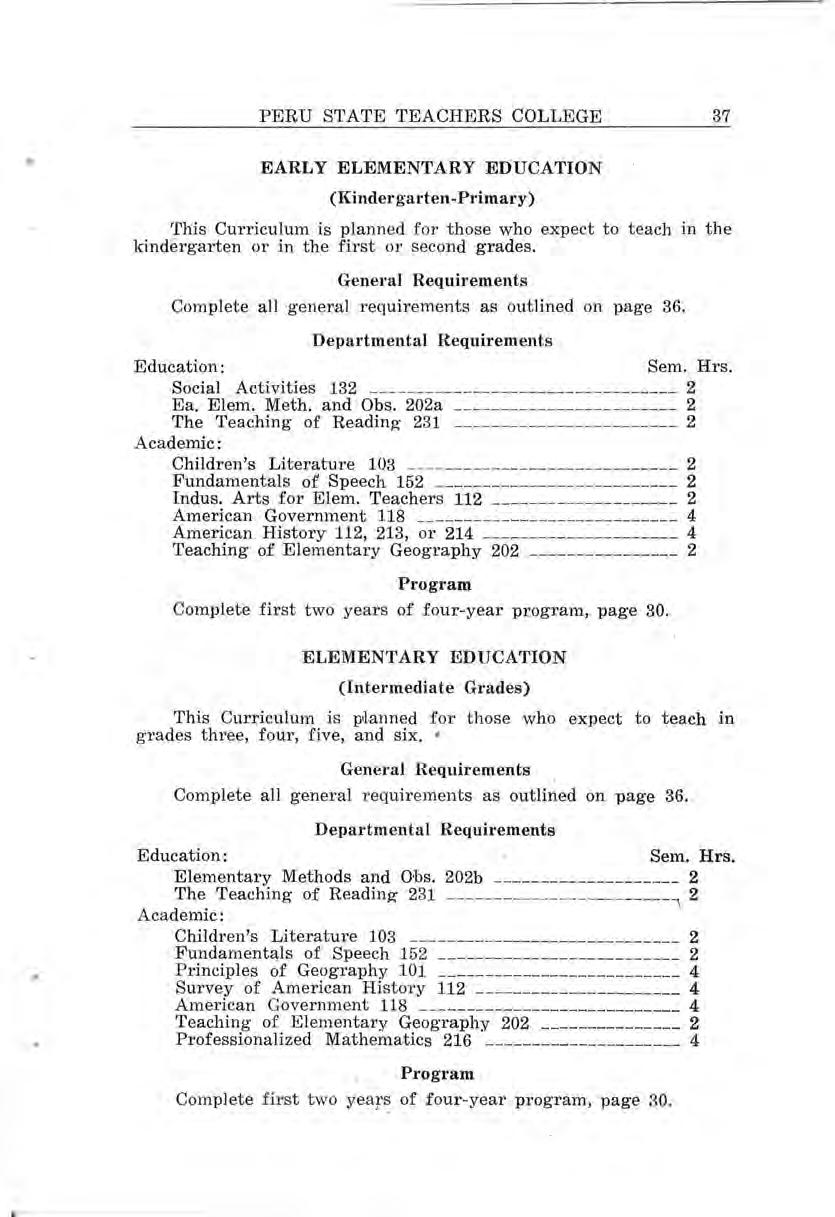
This Curriculum is p.J.anned for those who expect to teach in grades three, four, five, and six. •
General Requirements Complete all general requirements as outlined on page 36.
firs.t two years of four-year program, page 30
This curriculum is planned for those who expect to teach in grades seven and eight. Those junior high school teachers who would also like to qualify for ninth and tenth grade work should complete the r equirements for a three -year diploma ,
Complete all
requirements as outlined on page 36.
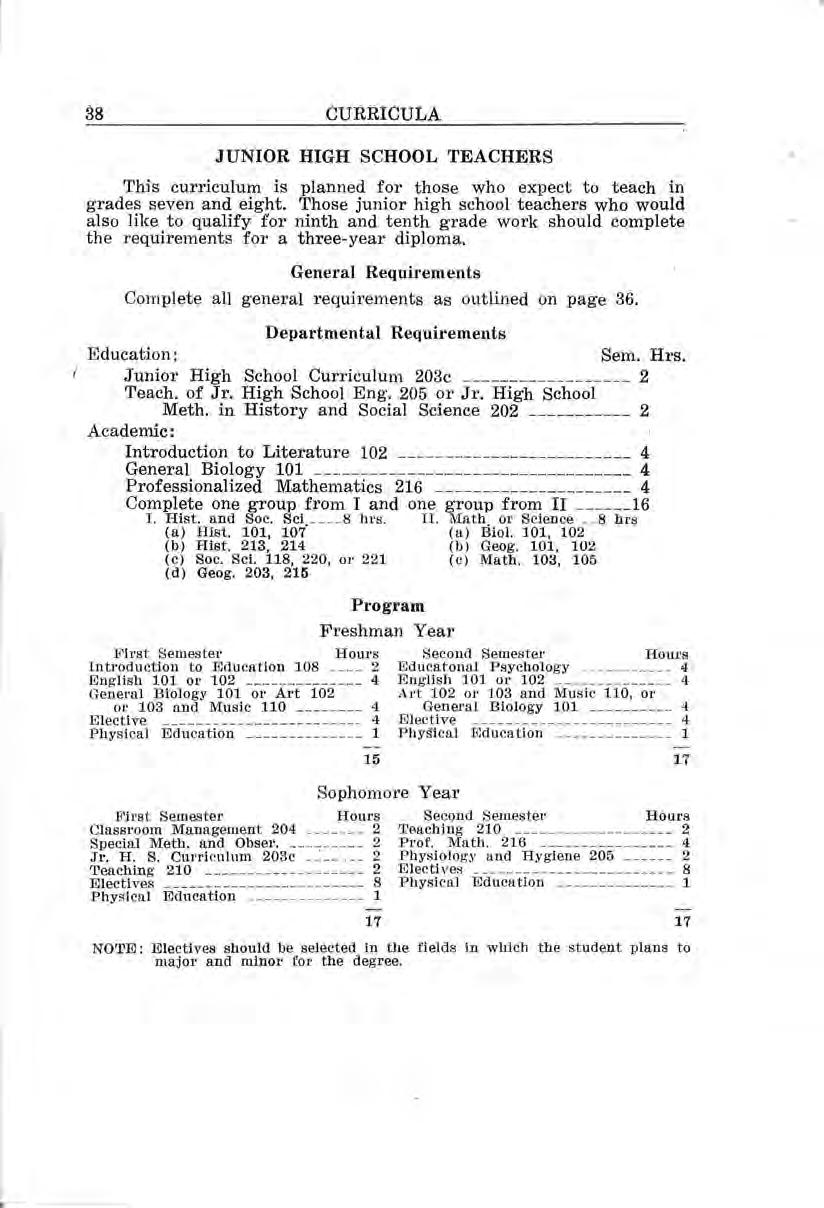
1. Students who wish to take a degree without fir st completi ng th e r equirements for a two-year diploma should follow the fourye ar course outlined on page 30.
2. Since mus ic teach e r s who h a v e completed the above twoyea r course are e li g ibl e only for" a combination music and grade s chool te ac hing p os ition, the y a re ,a dvised to select el e ctives from the elementary or early elem entary departments and to do additional practice teaching.

Thi s program df work is intended for those who desire to teach i n the rural s chools or in th e e lementary grades of consolidated anct tow n schools.
General Requirements
Complete all gen eral r e quirements as outlined on page 36.
1. Students who comulete the freshman year of the above twoyear Drogram will be qualified to receive the one-:vear diploma and the Nebraska Initial G/eneral Elementary School Certificate,
,
2. Students who later expect to preua.re for junior or senior high school teaching should e lect English 102, while those who plan to continue teaching in the elementary grades should e l ect English 103 and Speech 152.
8. Nature Study 105 and General Biology 101 meet the group re9uirement in science for the degree .for those stu<ilents who complete the two -year rural course .
4. Electives should be selected from those fields in which the student plans to major and minor for the degree. (See p . 29.) .
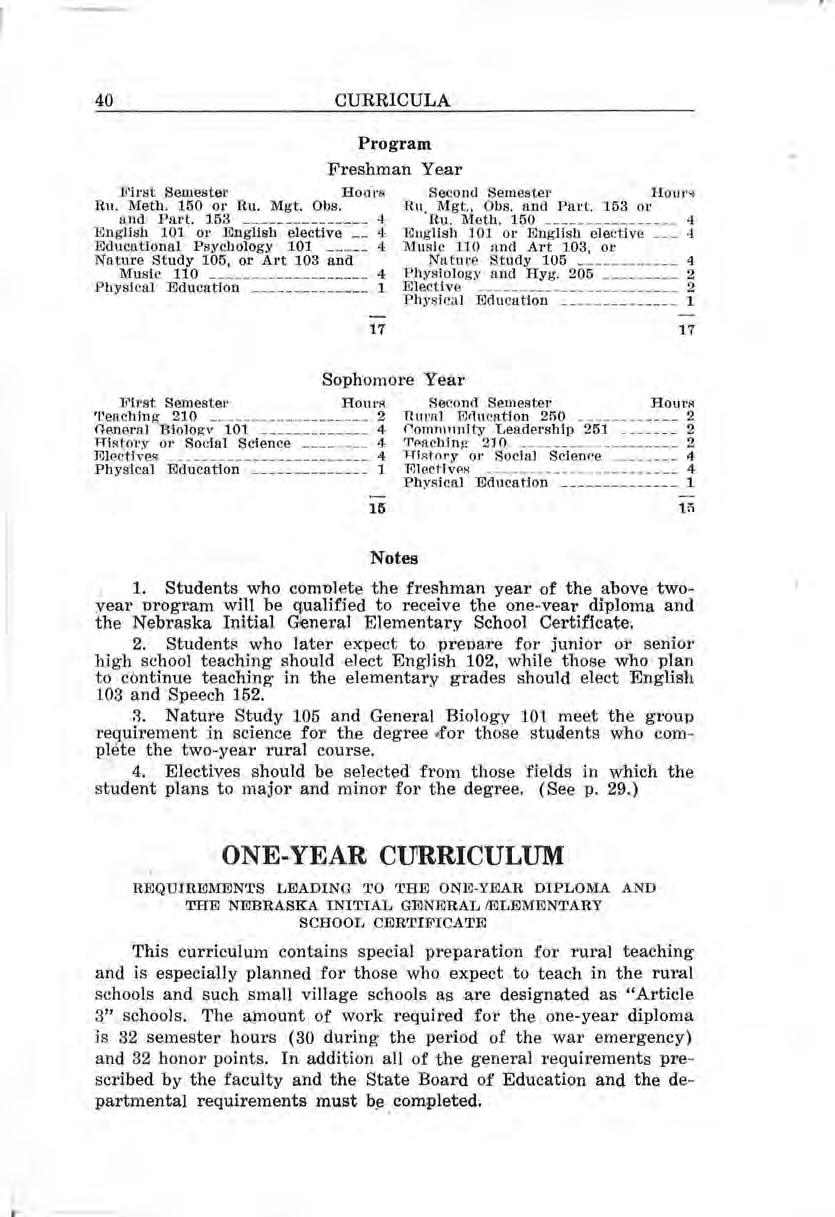
REQUIREMENTS LEADING '.1'0 THE ONE-YEAR DIPLOMA AND THE NEBRASKA INITIAL GENERAL /ELEMENTARY SCHOOL CERTIFICATE
This curriculum contains special preparation for rural teaching and is especially planned for tho se who expect to teach in the rural schoo ls and such small village schools as are designated as "Article 3" schoo ls. The amount of work required for the one-year diploma is 32 semester hours (30 during the period of the war emergency) an<l 32 honor points. In addition all of the general requirements prescribed by the faculty and the State Board of Education and the departmental requirements must bJ:l . completed.
Complete the program outlined for the Freshman Year of the two -year rural course. See "Rural Education", preceding piage. All of the general and departmental requirements for the one-year course are included in the program for the Freshman Year of the two-year course
Graduate work will be offered for the purpose of providing the necessary graduate credit, which is required under the new law, to renew, or raise to a higher level, those certificates issued on the basis of a bachelor's degree. A Graduate Council has b een appointed by the President to organize and administer the graduate program, and the following regulations govern students in this division.
Admission. Students holdin g a bachelor's degree from Peru State Teachers College, or other institution of approved rank, are eligible for admission to the Graduate Division.
Seniors in this college who require for graduation less than the work of a semester may be permitted to register in graduate courses for graduate credit provided the y secure the approval of the Graduate Council at the time of registration.
Applicants for admission to the Graduate Division should file a written application and a complete transcript of all undergraduate and graduate credit with the Registrar at least two weeks before the opening of the semester.
Graduate Courses. Courses numbered 500 or above are primaril y for graduate students, and are offered by members of the graduate faculty only. (See "Courses of Instruction," beginning on piage 42, for course descriptions . )
Fees. Graduate students will pay all of the regular fee s plus a course fee of $1.50 per credit hour, and a library fee of $2.00.
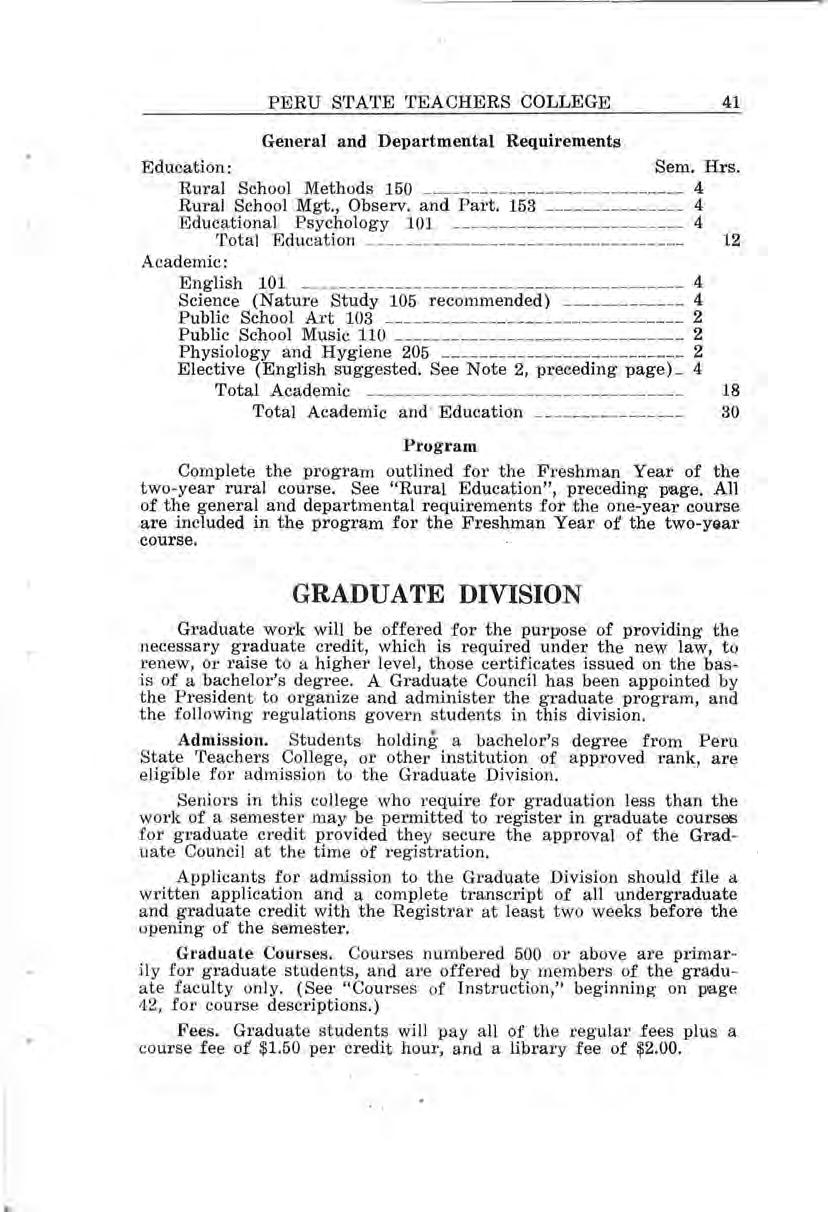
Each student should register for courses corresponding to hi s classification (freshman, sophomore, etc. ) , unles s it is otherwise impossible to work out a satisfactory program of studies . In such cases exceptions may be made. Courses numbered 1-99 are unclassified and open to all students. Those numbered 100-199 are for freshmen; 200-299 for sophomores; 300-399 for juniors; 400-499 for seniors and 500-599 for graduate s tudents. Only graduate students and seniors who are within less than the work of a semester for graduation may register for 500 courses.
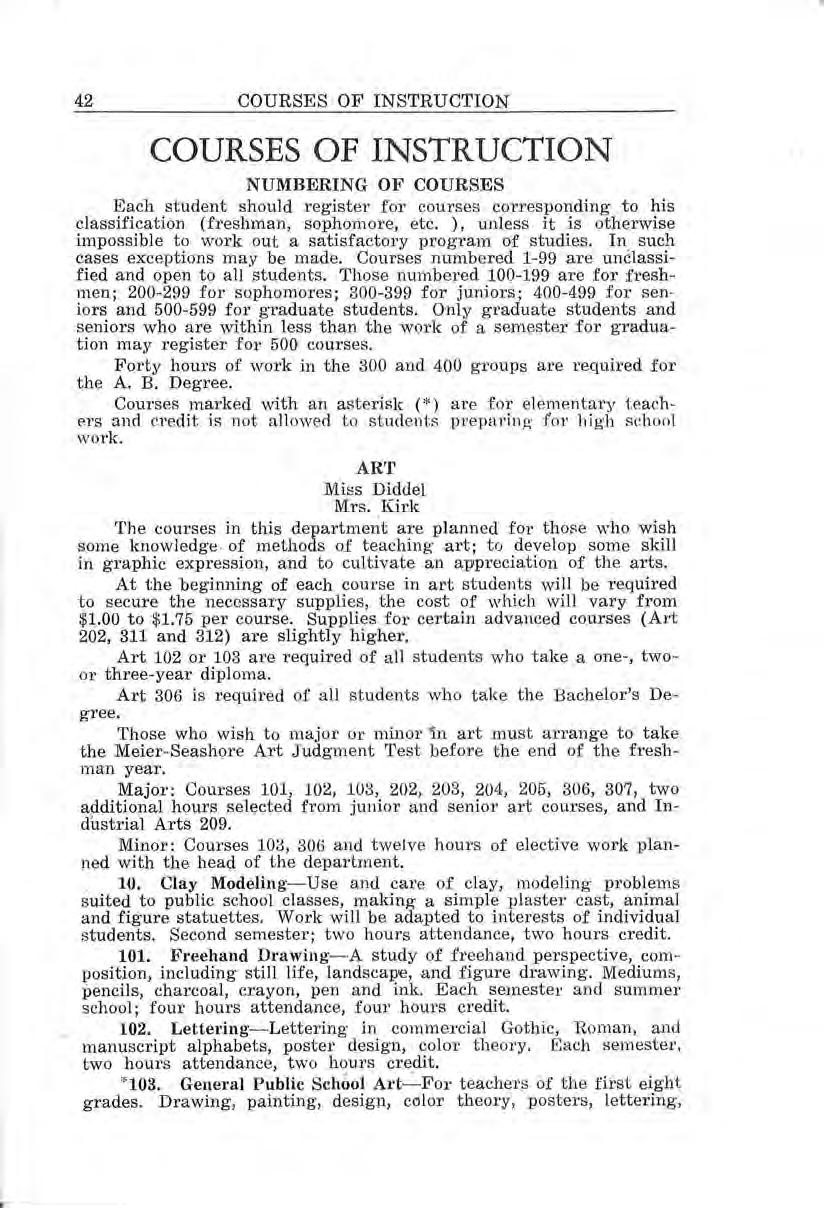
Forty hours of work in the 300 and 400 groups are required for the A. B. Degree.
Courses marked with an asterisk ( * ) are for el ementary teachers and credit is not a llo,ved to students preparing for ]Yigh s chool work.
The courses in this departme~f are planned for those who wish some knowledge . of methods of teaching art; to develop some skill in graphic expression, and to cultivate an appreciation of the arts.
At the beginning of each course in art students will be required to sec ure the necessary supplies, the cost of ,.vhich will vary from $1.00 . to $1.75 per course. Supplies for certain advanced courses (Art 202, 311 and 312) are slightly higher.
Art 102 or 103 are required of all students who take a one, twoor three -year diploma
Art 306 is required of a ll students who take the Bache lor's Degree
Those who wish to major or minor 'in art must arrange to take the Meier- Seashore Art Judgment Test before the end of the freshman year.
Major : Courses 101, 102, 103, 202, 203, 204, 205, 306, 307, two additional hours selected from junior and senior art courses, and Industrial Arts 209 .
Minor: Courses 103, 306 and twelve hours of e lective work planned with the head of the department.
· 10. Clay Modeling-Use and care of clay, modeling problem s s uited to public school classes, making- a simple plaster cast, animal and figure statuettes. Work will be adapted to interests of individual students . Second semester; two hours attendance, two hours credit .
101. Freehand Drawing- A study of freehand perspective, composition, including still life, landscap~ , and figure drawing. Medium s , pencils, charcoal, crayon, pen and ink. Each semester and summer schoo l ; four hours attendance, four hours credit
102. Lettering- Lettering in commercial Gothic, Roman, and manuscript alphabets, poster design, color theory. Each semester, two hours attendance, two hours credit.
' 103 . General Public School Art__:.__ For teachers of the first eight grades . Drawing, painting, design, color theory , posters , lettering,
and crafts such as clay modeling, bookbinding, basketry. Each semester and summer school; two hours attendance, two hours credit.
202. Water Color Painting-Prerequisite: Art 101 or its equivalent. A continuation of 101 with pictorial and decorative compositions in color. Practice in technique for transparent and opaque water color. Each semester and summer school; four hours attendance, four hours credit.
203. Design and Color Theory- A study of the principles of design and color harmonies. Practic e in making designs of abstract, geometric conventional and naturalistic types. Development of original designs for stencil, batik, and block printing on textiles. First semester; four hours attendance, four hours credit. (Home economics students may register for two hours credit by arrangement.)
204. Crafts-An industrial arts course. Includes a study of such crafts as bookbinding, leather tooling, reed and raffia basketry and weaving. Second semester and summ er school, two hours attendance , two hours credit.
205. Methods in Art-A teachers course. Prerequisite: Art 103. Art 101, Freehand Drawing, should be taken before or while taking this course. A study of the relation of art education to other school subjects, methods of teaching- drawing and construction for the grades, planning- les son s and an outline for a yea r's work. Observation in the training school. First semester: two hours attendance, two hours credit.
Education 210 -411. Practice Teaching- Four hours of p'l'actice teaching in art are required of thos e who complete a major. Prerequisites : Art 101, 205 .
221. Prints and Etchings- History of development of the graphic arts of block print, etching, lithograph with study of the technique of each proces s . Lecture s and reading- will be followed by making pictorial linoleum or wopd block prints One hour credit. Summer school.

301. Pottery- Building simple pottery shapes, firing, glazing . Study of pottery design. Two hours attendance, two hours credit. Given on demand.
306. Art Appreciation- To give teachers some standards of measurement for artistic appreciation. Study of art principles as apiplied to architecture, sculpture, painting and the minor arts. A general review of periods or art history. Each semester and summer school; two hours attendance, two hours credit.
307. Art History- History of great periods of art with relation to art of present time. Two hours attendance, two hours credit; first semes ter.
311. Advanced Drawing and Painting- Prerequisite: Art 202. Work in charcoal, crayon and water color. Four hours attendance, four hours credit; second semester.
312. Oil Painting- Prerequisite: Art 202. Still life, figure and landscape compositions. Four hours attendance, four hours credit, se cond semester. Given , on demand
421. Prints and Etchings--, Similar to course 221 with -the addition of more difficult projects . One hour credit. Summer school.
Miss Palmer
Those who major in this department will take Shorthand 101, 106, and 207, Accounting 203 and 204, Typ ewriting 6 hours, Commercial Law 302, Methods of Teachin g Typewriting and Shorthand 308a-b, and Geography 215
A minor in the department may b e earne d by choosing one of the following combinations:
1. Shorthand 8 hours. Accounting 4 hours. Typewriting 4 hours, Methods of Te aching Shorthand 308b. (Methods of Teaching Type,vriting 308a may be substitute~ for one hour of Typewriting.)
2. Typewriting 4 hours. Accounting 203. Commercial Law 302, Methods of Teaching Typewriting 308a, and 4 hours of either Economics, Economic Geography, or Accounting 204.
Students who have had two or more semes ters of Shorthand in h igh school will register for Shorthand 106.
5. Typewriting·-Special attention is given to punctuation, manuscript writing, and letter forms. Students may register for one, two three, or four hours work. First and second semesters; four hours attendance, one hour credit.
9. Methods of Teaching Penmanship-Principles and methods of writing and teaching the Palmer method. Palmer certificates are secured by those completing the required work. Two hours attendance, one hour credit; second semester.
101. Shorthand I, G-regg System- All fundamental principles are covered. Three hundred pages of readin g- is required. Students who have had two semesters of high school shorthand ma y not take this course for credit. First semester; f'our hours attendance, four hours credit.

106. Shorthand II-Continuation of course 101. Prerequisite: Ability to typewrite rapidly. Speed drills; transcribing and correspondence; general review of stenographic princiP'les. Second semester; four hours attendance, four hours credit.
108. Introduction to Business-A study of business principles and terms, simple businss transactions and papers, consumer information, insurance, investments, and simple legal procedure. Three hours attendance; three hours credit. First semester.
203 . Elementary Accounting-This course deals with fundamentals; the balance sheet, profit and los s statement, effect of every transaction on balance sheet, the account, effect of debit and credit on accounts, ' ledger, various journals, trial balance, work sh eet, adjusting and closing entries, business papers. First semester; four hours attendance, four hours credit.
204. Advanced Accounting- Continuation of course 203. Multicolumnar books, analysis of income and expenditures, the organization, capital stocks, dividends, f! Urplus, reserves, depreciations and branch store accounts are among the features considered. Second semester; four hours attendance, fbur hours credit,
207. Shorthand III-Prerequisites: Shorthand 101 and 106. Writing and trans cribing difficult matter, speed practice. Use of duplicating devices; filing. Practical office experience. First semester; four h ours attendance, four hour s credit.
302. Commercial Law-A course designed to show, in a nontechnical manner, the importa.nt factors of the common law affecting ordinary busine ss transactions. Second semester; four hours attendance, four hou rs cre dit.
308a -b. Methods of Teaching Typewriting and Shorthand-Prerequisites: Typewriting, Shorthand 106. First semester; two hours attendance, two hours credit.
310. Advanced Dictation- Prerequisite: Shorthand 207. The primary .aim of this course is to increase speed in writing shorthand and in transcribing di fficu lt material. Designed primarily for students wishing to become expert stenographers. Second semester; two hours attendance, two hours credit.
Mr. Maxwell
Miss Tear
Mr. Baker
Mr. Clements
Mr. Tyler
Mr. Jimersont
A teachers college is primarily a professional school. A considerable body of scientifically determined knowledge relative to teaching and learning now is availabl e. This is providing a sound basi s for a profession of teaching. The courses in education have the genera l purpose of acquainting th e student with this knowledge and guiding him in its application.
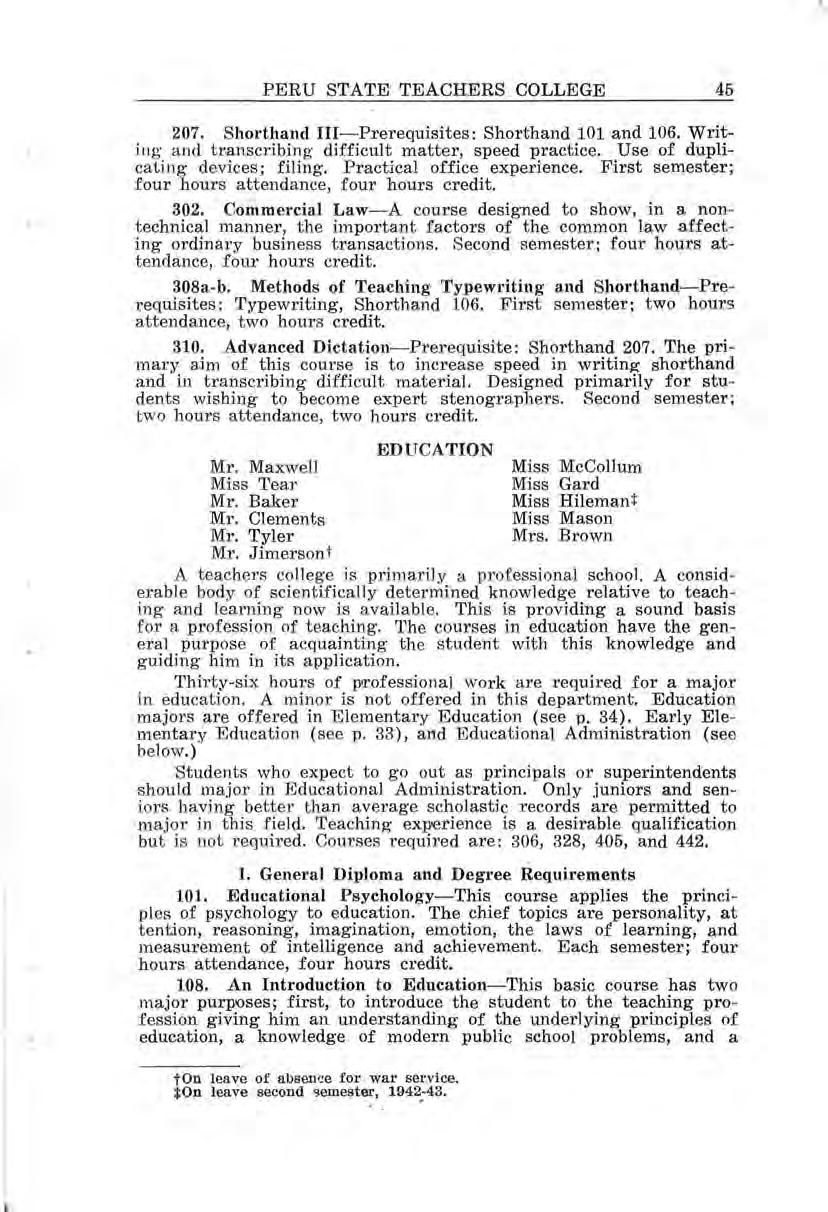
Thirty-si x hours of p,rofessional work are required for a major in education . A minor is not offered in this department. Education majors are offered in Elementary Education (se e p 34). Early Elementary Education (s ee p 33), artd Educational Administration (see below .)
Students who expect to go out as principals or superintendents s hould major in Educational Administration. Only juniors and seniors having better than average scholastic records are permitted to ·major in this field . Teaching experience is a desirable qualification but is not required Courses required are: 306, 328, 405, and 442.
101. Educational Psychology-This course applies the principles of psychology to e ducation . The chief topics are personality, at tention, reasoning, imagination, emotion, the laws of learning, and measurement of intelligence and achievement. Each semester; four hours attendance, four hours credit.
108. An Introduction to Education-This basic course has two major purposes; first, · to introduce the student to the teaching profession giving him an understanding of the underlying principles of education, a knowledge of modern public school problems, and a
t0n lea ve of absen ~e for . war service. :j:On leave second ~emes ter, 1942-43. ' .
gradual growth in professional attitudes ; seco nd, to serve as an exploring course which will aid in the decision as to a special field for later study and practice . Required of all except those enrolled in Rural Education 150, to be taken in the first semester of college attendance. Each semester; two hours attendance, two hours credit.
202. Methods and Ob s ervation- Two hours of credit in methods and observation are required for a two - year diploma. Students majoring in elementary fields must tak e Education 202a or 202b. Majors in junior high school teaching must take one of the following special methods and observation courses: Art 205, English 205, History 202, Mathematics 216, or Music 102.
*202a. Early Elementary Methods and Observation- The first half of the course will be devoted to kindergarten technique and procedure; the second half to spelling, numbers and English in the primary grades. This is a practical cours e in the discussion of specific problems in the early elementary field a nd will be accompanied by observation in the training school. A prerequisite for student teaching. First and third quarters; four hours attendance, two hour s credit.
*2 02b. Elementary Methods and Observation - A course primarily for majors in elementary e ducation . Includes materials and methods for teaching the va rious elementary school subjects. Students will be given ample opportunity to observe in the elementary department of the training school. A prerequisite for s tudent teaching. Required of all majors in e lementary education. First quarter; four hours attendance, two hours credit. ·

204. Classrnom Management- The purpose of this course is to s uggest ways and means of meeting the many daily practical classroom problem s every teacher has to solve. The course content will depend largely upon th e experience, training- and needs of individual s tudents . One objective is to familiarize s tudents with sources of help in solving such problem s as disci,pline, classroom attitudes, ass igning marks, making objective tests, daily program , classroom equipment, providing for individual needs, etc. First and third quarters; four hours attendance, two hours credit. ·
304. Classroom Management in High School-A course arranged especially for high school classroom teachers . The content will depend largely upon the experience, training and needs of individuals taking the course. Re,adings, reports, and discussions on numerous practical classroom problems every high school teacher must solve will receive major consideration. Second quarter; four hours attendance, two hours credit.
210-411. Practice Teaching-See "Training School."
331. Educational Measurement - A study of modern methods of measuring learning capacity and learning progress. First and third quarterfl,_; four hours attendance, two hours credit.
424. Philosophy of Education- Through the independent study of typical teaching problems each student in this course is led to reformulate his own philosophy - of education. Each semester; four hours attendance, four hours credit.
~132 . Socia l Activities in the Early Elementary Grades - This c ourse is base d upon the common social experiences of children. Th e students are taught h ow to s tudy the objects and situations met daily by children and to evolve play programs that will help children find beauty in the commonplace, discover worth y uses for leisure time , and create more ideal modes of behavior: Sec ond semester; four h ours · attendanc e , two hours credit.
203. The Junior High School Curriculum- Present status, origins, and significant trends. F our hours attendance; two hours credit. Second quarter.
*205-3 05 . Elem e ntar y _ S chool Curriculum and Management- A s tudy center course d es i g ne d to a id el ementary and rural school teac hers in evaluatin g their ow n school practices. Each member of t h e class will make an extensive study of one curricular problem Three hours cre dit.
• 231. The Teaching of Reading- Selection of efficient method s an d materials of teaching oral and s ilent reading in the elementary g r a de s. Topics included: problems concerning- the time for beg inning reading instruction; aims a nd achievements at different grade l evel s; the teaching of phon etics; remedial teaching; the development of interest in ind ep end ent reading. Students will be given an opportunity to become familiar with th e telebinocular and with the reading tests use d in clinics. Fee, $1.00 . Four hours attendanc e, two hours credit; secon d and fourth quarters.

*233. The Improvement of In s truction in Reading-A study center cour se de si gned to help s uperintendents carry on one phase of t h eir in -servic e trainin g program. An a ttempt is made to relate th e co urse work to the actual teaching of those ' who take the course. Emphasis is placed upon diagnostic and reme dial techniques. Three hours cre di t.
*3 03. The Elementary School Curriculum- A study of curriculum trend s in the modern sch ooi and principl es determining the initiation, organization, and adaptation of child-centered, teacher-guided ac tivities. Fourth quarter and s ummer; four hours attendance, two hours credit.
306. Extra Curricular Activities-This course deals with problems of or gan izing and directing extra-curricular activities commonly found in Elementary, Junior, and Senior high schools. Individual and group inv estigations will be made of such activities as Student Council, Home Room, Assembly, Dramatics, D ebate, Clubs, Athletics and Student Publications. Open to students above the sophomore year Third quarter; four hours attendance, two hours credit.
*323. Child Psychology-This course is concerned with the princi ples of the nature, growth and development of the child, a knowledge of which is fundamental to the successful management of children . The work is especially for elementary teachers. Second quarter; four hours attendance, two hours credit.
328. Educational Sociology- A study of the principoles of sociology which form a basis for the understanding of education. Emphasis is placed upon the i;ipplication of these principles to school problems. Each semester; four hours attendance, four hours credit. , ,
405. Fundamentals of School Administration-A survey of basic principles and practices in school administration; emphasis upon the small school system. Four hour s attendance; four hours credit; first semester.
408. Workshop--An approach to the solution of educational problems through group• discus s ion and individual study under the direction and supervision of a group of staff members. For a detailed discussion of the Workshop, se e the 1943 Summer Bulletin. One to six hours credit.
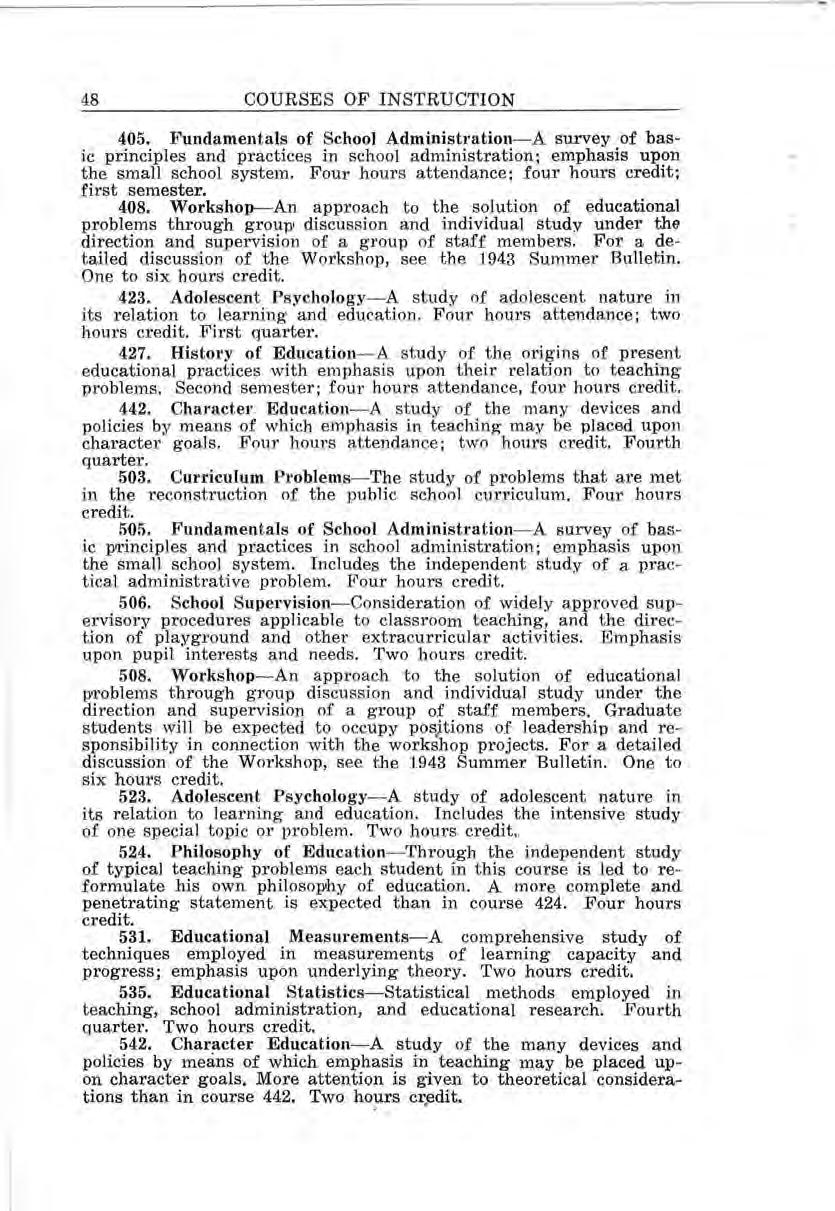
423. Adolescent Ps ychology - A s tudy of adolescent nature in i ts relation to learning and education. Four hours attendance; two hours credit. First quarter.
427. History of Education- A s tudy of the origins of present educational practices with emphasis upon their relation to teaching problems. Second semester; four hours attendance, four hours credit.
442. Character Education- A s tudy of the many devices and policies by means of which emphasis in teaching may be placed upon character goals. Four hours attendance; two hours credit. Fourth quarter.
503 . Curriculum Problems- The study of problems that are met in the reconstruction of the public s chool curriculum. Four hours credit.
505. Fundamentals of School Administration- A survey of basic porinciples and practices in school administration; emphasis upon the small school system. Includes the independent study of a practical administrative problem. Four hours credit.
506. School Supervision- Consideration of widely approved supervisory procedures applicable to classroom teaching, and the direction of playground and other extracurricular activities. Emphasis upon pupil interests and needs. Two hours credit.
508. Workshop- An approach to the solution of educational p•roblems through group discussion and individual study under the direction and supervision of a group of staff members. Graduate students will be expected to occupy posjtions of l eadership and responsibility in connection with the workshop projects. For a detailed discussion of the Workshop, s e e the 1943 Summer Bulletin. One to six hours credit.
523. Adolescent Psychology - A study of adolescent nature in its relation to learning and education. Includes the intensive study of one special topic or problem. Two hours credit.
524. Philosophy of Education- Through the independent study of typical teaching problems each student in this course is led to reformulate his own philosophy of education A more complete and penetrating statement is expected than in course 424. Four hours credit. .
531. Educational Measurements-A comprehensive study of techniques employed in measurements of learning capacity and progress; emphasis upon underlying theory. Two hours credit.
535. Educational Statistics-Statistical methods employed in teaching, school administration, and educational research. Fourth quarter. Two hours credit.
542. Character Education-A study of the many devices and policies by means of which emphasis in teaching may be placed upon character goals. More attention is given to theoretical considerations than in course 442. Two hours credit. ' .
Either elective education credit to the extent of four hours or academic credit is granted for the following special methods and observation courses:
Art 205; Commerce 308; English 205, 405; History 202, 402; Home Economics 331; Industrial Arts 215, 304; Mathematics 216, 307; Music 208; Physical Education 302, 306; and Science 406.
312. Scout Mastership-Th':! purpose of this course is to help young men prepare for Boy Scout leadership in the communities in which they work. The course embraces three essential factors: (1) the relation of the objectives of the Boy Scout movement to the problem of boyhood, (2) the techniques of Scouting, and (3) the educational principles governing the methods employed in administering the Scout program. Satisfactory completion of the course entitles the student to the National Boy Scout Certificate of Training. Fourth quarter; four hours attendance, two hours credit.
*150. Rural School Methods-A study of' approved, modern methods, devices and techniques of teaching the elementary branches. Special attention is given both to group aRd to individualized teaching; to the aims, standards, achievement, measurements, diagnosis , piroblems and remedial procedures involved; to schedule making, lesson planning and assignments, recitation types, study directions and supervision, and to the Nebraska Elementary Course of Study. Rural teaching background conditions, interests and needs receive due consideration . (a) Grammar, literature, reading spelling. (b) Arithmetic and social science. Each semester; four hours attendance, four hours credit
*153. Rural School Management, Observation and Participation (formerly Rural School Problems)-{a) Classroom-playground management: Problems of pre-planning, first day preparation and procedure, tentative and permanent programming, classroom routines, playground direction and supervision, stimulation of attendance and punctuality, constructive discipline, varied co-operative activities, equipment, library and supplies. (b) Diversified observations of schoolroom activities and procedures, and participation in conferences and assigned classroom and playground activities. Offered each semester; four hours attendance, four hours credit.

250. Rural Education-This course is offered for the benefit of rural, consolidated and village teachers, and aims to develop a broader perspective, a clearer insight and understanding, a deeper and richer appreciation of the existing factors and forces in this field. It is, therefore, a general background course which deals with the environmental conditions-economic, sociological, moral and religious-affecting the school; with the natural fitness, the required preparation and the professional and personal growth and develop, ment of the in-service teacher; and also with the prevailing educational status, the present general trend, and the redirection of probable future of rural education. Second quarter; four hours attendance, two hours credit.
251. Community Leadership and Parent-Teacher Association- A course which aims to acqu,aint the teacher with the opportunities and needs for effective school ·and community services; with published literature, outstanding movements- and recent trends and activities
in this field; to equip the teacher for serviceable leadership and cooperation in all general organizations and movements for community betterment; to give special attention to the basic philosophy, the organization, the purposes and the successful direction of the ParentTeachers Association toward the betterment of the school and the community. Fourth qua rter; four hours attendance, two hours credit.
350. Rural School Organization, Administration and Supervision - This course is offered for those interested in village, consolidated or county administration and supervision. It deals with problems relating to various organization types; and with such problems @f administration and supervision as teaching personnel, p<upil accounting, community co-operation, school officer relationships, course of study, extra-curricular activities, buildings and grounds, equipment and apparatus, school finance and transportation. Due attention is given to recent literature, type case studies, actual field problems and present day approved types of administration and supervision. Offered on demand or by correspondence; four hours attendance, four hours credit.
Mr Bradford
Miss Brandt
Miss Faulhaber
Miss Kenton
Miss Konig
Miss Martin
Mr. Moore
All students are required at the time of entrance to take a general proficiency examination in English. Those successfully passing the test will be excused from English 100 . All students must comp,lete English 101 and also 102 (10~ and 152 for Elementary and Early Elementary students) or eight hours of a foreign language.
A minor in English shall include courses 101, 102, 215, 234, 254, and 303 or 304.
A major ·in English shall include courses 101, 102, 215, 234, 254, 205 or 405, 303, 304, 324, 357, 417, and six hours of electives, three of which must be in senior literature .•
It is advisable for students who minor or major in English to supplement the required courses with work in dramatics and debate.
100. Fundamentals of English-A course in the fundamental skills of spoken and written English, including a study of basic grammar, sentence structure, punctuation, and spelling. Much practice in the organization of simple material. Required course for all freshmen deficient in the basic skills of English. Each semester; two hours attendance, two hours credit.
101 English Composition-A study of the principles of clear and effective expression as applied to the sentence, the paragraph, and the whole composition. Practice with the forms of discourse with emphasis upon exposition. Attention to the problem of efficiency in reading, the use of the library, note taking, the use of dictionaries and the thesauri, and vocabulary building. Training in the organization of short and long papers. Required course for all freshmerl. Each semester; four hours attendance, four hours credit.
102. Introduction to Literature-The appreciative study of literature in its various forms with reading and class discussion of modern specimens of poetry, drama, and prose. This course seeks to induce a pleasure in good literature and to develop discrimination and critical judgment. The relation13hip • of literature to life and to the
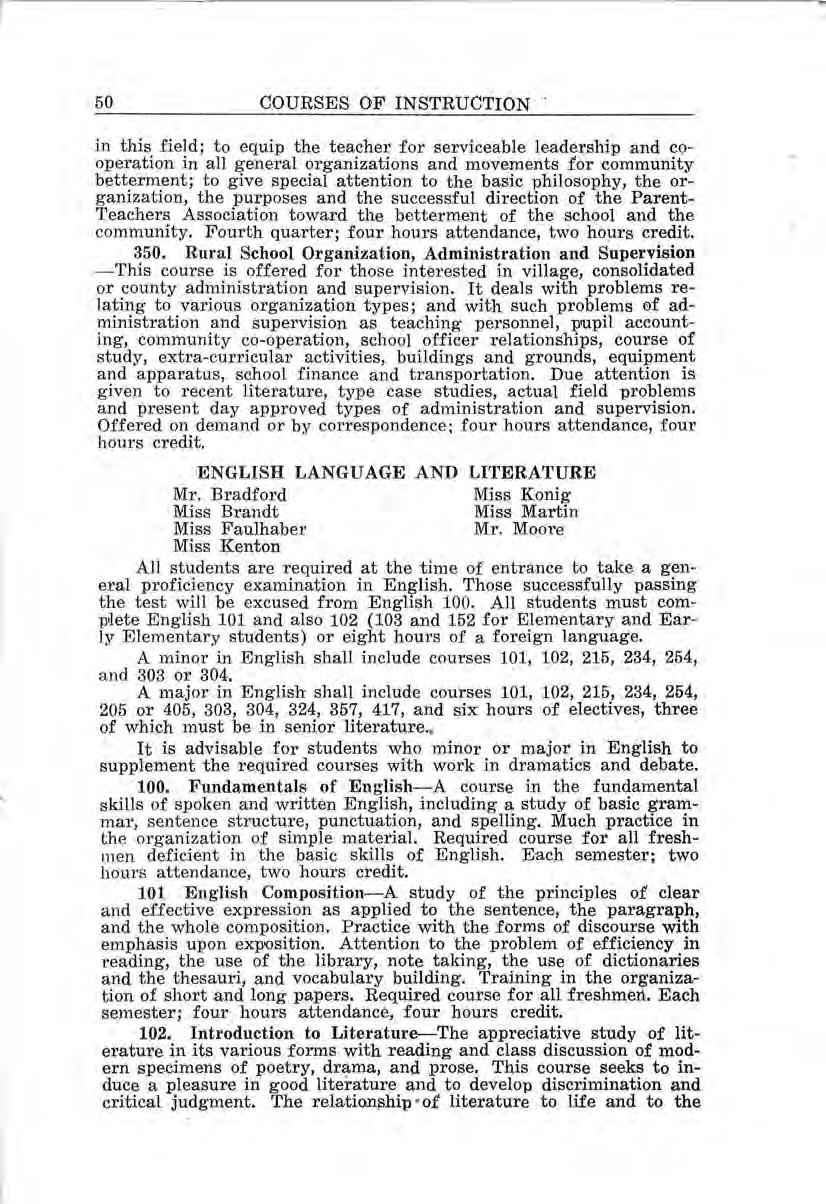
other arts is studied and an interest in ideas encouraged. Each semester; four hours attendance, four hours credit.
*103. Children's Literature- A survey of American Literature for children with its background from other countries. Practice will also be given in both telling and writing children's stories Planned especially for teachers who will enter the elementary field. First semester; two hours attendance, two hours credit.
205. The Teaching of English in the Junior High School- A co urse planned for consideration of subject matter and technique in. volved in the teaching of English in grades seven, eight, and nine. Some time is spent in planning specific lessons and units, in observing teaching in the Training School, and in enriching- the subject matter background . Readings for examination of ideas, and practic es of experts in the field. The inclusion of th e traditional subjects of reading, grammar, composition, a nd spelling is implied. First semester; two hours attendance, two hours credit.
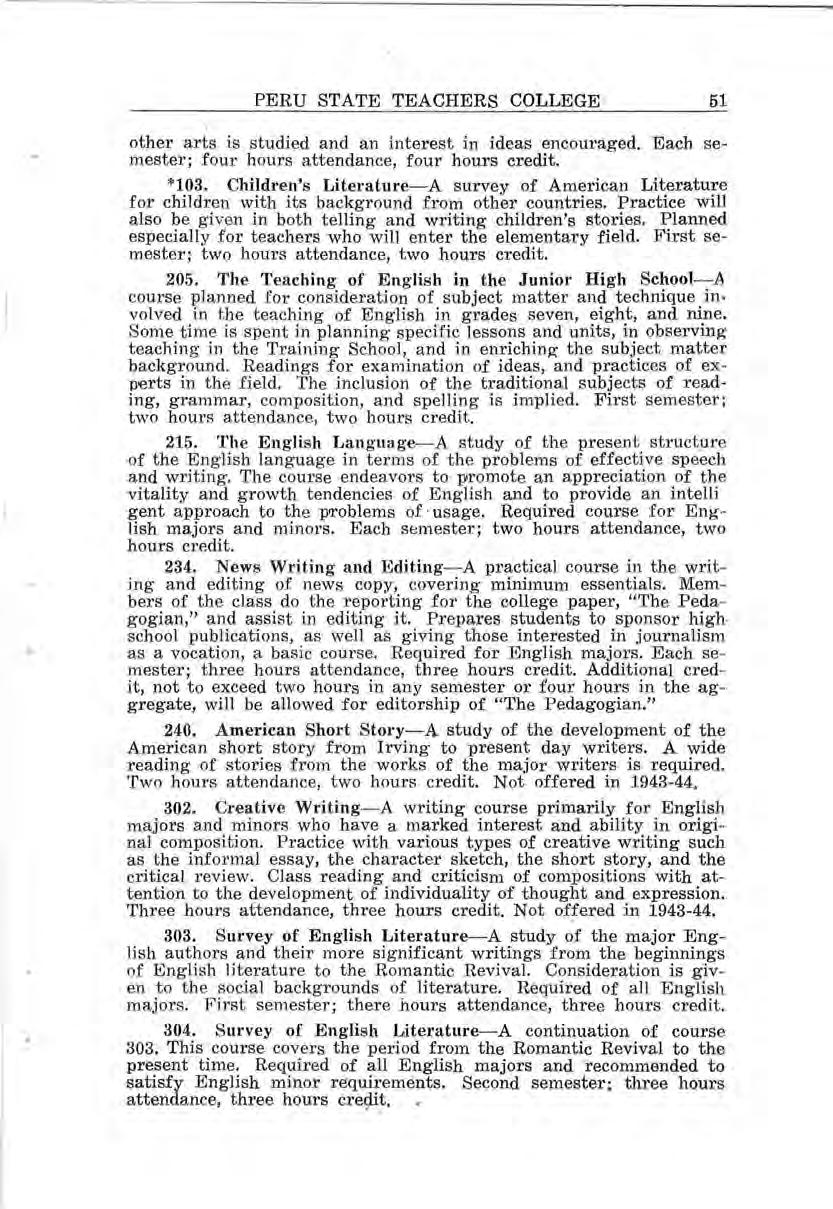
215. The Englis h Language- A stu dy of th e present structu re of the English language in terms of t he problems of effective speech and writing. The course endeavors to promote an appreciation of the vitality and growth tendencies of English and to provide an intelli gent approach to the prroblems of ·usage Required course for English ·majors and minors. Each semester; two hours · attendance, two hours credit.
234. News Writing and Editing- A practical course in the writing and editing of news copy, covering minimum essentials. Members of the class do the reporting for the college paper, "The Pedagogian," and assist in editing it. Prepares students to sponsor high, school publications, as well as giving those interested in journalism as a vocation, a basic course. Required for English majors . Each semester; three hours attendance, three hours credit. Additional credit, not to exceed two hours in any semester or four hours in the aggregate, will be allowed for editorship of "The Pedagogian."
240. American Short Story-A study of the development of the American short story from Irving to present day writers A wide reading of stories from the works of the major writers is required. Two hou rs attendance, two hours credit. Not offered in 1943 -44.
302 Creative Writing- A writing course primarily for English majors and minors who have a marked interest and ability in original composition . Practice with various types of creative writing such as the informal essay, the character sketch, the short story, and the critical review. Class reading and criticism of compositions with attention ·to the development of individuality of thought and expression. Three hours attendance, three hours credit. Not offered in 1943-44.
303. Survey of English Literature-A study of the major English authors and their more significant writings from the beginnings of English literature to the Romantic Revival. Consideration is given to the social backgrounds of literature. R equired of a ll English majors. First semester; there hours attendance, three hours credit.
304. Survey of English Literature- A continuation of course 303. This course covers the period from the Romantic Revival to the present time Required of all English majors and recommended to satisfy English minor requirements. Second semester; three hours attendance, three hours cregit. •
320. Modern Poetry-A study of American and English poetry of the present century. The aimi:;, interests, and methods of the new poets; their work as an expression of contemporary life. Two hours attendance, two hour s credit.. Not offered 1943-44.
324. Survey of American Literature-A study of the lives and significant works of the outstanding- American writers from Captain John Smith to Carl Sandburg. First semester; three hours attendance, three hours credit.
~335 . Advanced Children's Literature-Prerequisite: Children's Literature 103. Presentation of Modern sci entific studies of stories and books for children. Detailed study of Newberry prize books and those selected by Junior Literary Guild. Special attention to / the writing of children's stories Second semester; two hours attendance, two hours credit.
403. The Modern Novel-A study of the major British and American novelists of the 19th and 20th centuries; consideration of the trends of contemporary fiction, with some attention to the problems of literary criticism. Three hours attendance, three hours credit. Second semester.
405. The Teaching of English in the High School-Prerequisite, English 303 or 304. Methods and content of high school English. When and how to teach grammar, composition, and literature. Examinations of courses of study, texts, and tests. Careful study of the Nebraska High School Manual, Observation of teaching in the Training Schoo l. First semester; three hours attendance, three hours credit.

417. S hakespeare-C lass reading and interpretatio n of representative comedies, histories, and tragedies . Outside readings, oral and written reports. Three hours attendance, three hours credit. First semester.
422. Victorian Prose and Poetry- A study of masterpieces of prose and poetry from the Victorian Period with special attention to the relationship of the literature to the social, political, and scientific developments of the age Three hours attendance, three hours cred • it. Not offered 1943-4.
44 0. The Modern Drama- A study of the chief modern dramatists of continental Europe, England, and America from Ibs en to the present time. Three hours attendance, three hours credit. Second semester.
441. Literary Criticism-Principles and methods for evaluation of literature; the history of criticism from the ancient Greeks to the p,resent. Practice in the interpretation and appraisal of contemporary writings Three hours attendance, three hours credit. Not offered in 1943-4.
517. Shakespeare-Class reading and interpretation of representative comedies, histories, and tragedies . Outside readings of scholarly commentaries. Investigations, reports. Three hours credit.
540. The Modern Drama-A study of the chief modern dramatists of continental Europe, England, and America from Ibsen to the present time. Readings in critical literature, investigations, and reports. Three hours credit. S'ec~1:d seµiester.
541. Literary Criticism-Principles and methods for the evaluation of' literature: the history of criticism from the ancient Greeks to the present; inv estigations and reports. Three hours credit. Not offered 1943-4
Speech minors are allowed only in the cases of students who are taking an English major.
A minor in speech shall include courses 13, 152, 254, 255, 355, 357, and English 417 or 440. ·
Courses 152, 254, 255, .and 357 carry a laboratory fee of $1.00 each for use of the voice recording apparatus.
13. Debate-Intensive study of a debate question with forensic practice. Intended for students w ho participate in intercollegiate debate and for English majors who may be required to dir ect high school debate With change of the d ebate question this course may be taken again for two hours of additional credit. Credit two hours. Not offered 1943-4.

152. Fundamentals of Speech-The principles of speech: the physiology and anatomy of the vocal mechanism the psychological factors involved in communication .and inte rpretation; the course embraces the development of bodily freedom, development of distinct utterance, voice improvement, thinking and speaking in the presence of others and effective oral expression in every day social and business relationships; s pecial attention to the needs of the individual.First semester; two hours attendance, two hours credit.
254. Public Speaking-Training in effective methods of adapting composition and delivery to various types of audiences. A study is made of the forms of address, impelling motives, speech ends, speech organization, comp,osition and delivery. Practice is given in gathering, choosing, working and mastering speech materials. Direct and purposeful conversational deli yery for the purpose of communication i s stressed. Four hours attendance, four hours credit. Each semester.
255. Elementary Dramatics-A study and application of the principles of' dramatic interpretation with particular emphasis on personality development; the development of creative imagination; analyzing and playing a part; an intensive training in pantomime , posture, movement, stage business , body control, vocal control, dialogue and characterization. First semester; four hours attendance, four hours credit.
355. Play Production-A course for the director of dramatics in school s and communities. It answers the fundamental questions pertaining to play selection, casting, directing, steps in rehearsal, scenery, lighting, costume, make -up and business organization. Second semester; four hours attendance, four hours credit.
357. Interpretative Reading-A study of the harmony of thought and mood as expressed through the medium of the speaking voice. An .analysis of the proc ess and t echnique of expression; emphasis is placed on the finding and projecting of the thought and emotional content on the printed page. Selections from literature are studied and presented in class. Second semester; two hours attendance, two hours credit. •
Major: 24 hours (above course 102), including- course 210.
Minor: 16 hours (above course 102), including course 210.
101. Beginning Latin-ProilunciatiLJ, grammar, vocabulary, composition and reading. Open to students with no high school Latin. Four hours attendance, four hours credit.
101a. Latin and Caesar-Continuation of' 101. Derivative study and supplementary materials on Roman Life . Prerequisite-two se1,. _: ters high school Latin. Four hours attendance, four hours credit.
102. Caesar-Selections from Gallic Wars. Prerequisite: three semesters high school Latin. Four hours attendance, four hours credit.
103. Cicero and Latin Composition-Orations against Catiline. Review of Latin forms and syntax with weekly exercises in translations from English to Latin. Four hours attendance, four hours credit. ·

105. Vergil-Selections from Aeneid. Scansion and metrical reading. Study of the epic. First semester; four hours attendance, four hours credit.
106. Vergil-Continuation of course 105. Second semester; four hours attendance, four hours credit.
207. Ovid-Story of Creation and other myths. First semester; four hours attendance, four hours credit.
208. Selections from Latin Prose and Poetry- Representative selections from many classical authors, as Plautus, Terence, Horace, Catullus, Livy, Phaedrus, Martial, and Juvenal , who have been sources of much modern literature. Four hours attendance, two hours credit; fourth quarter. ·
209. Greek and Roman Mythology- Classical myths in their relation to nature, art, literature, and astronomy. · All in English. Gives either Latin or English credit. Requi'l'ed for Latin major or minor. Third quarter and summer school; four hours attendance, two hours credit.
210. Methods of Teaching Latin- Objectives· of teaching Latin Content and methods of high school Latin . Examination of texts. Observation of teaching. Two hours credit.
305. Horace-Odes, satires, and epistles. Study of lyric meters used by Horace. Special stress upon his pictures of the life of the Augustan Age. First semester, four hours attendance, four hours credit.
307. Livy-Story of Rome as told by Livy. Alternates with 305. First semester; four hours attendance, four hours credit.
308. De Senectute 01· De Amicitia- Third quarter; four hours attendance, two hours credit.
3-09. Sallust or Cicero's Pro Archia and Selected Letters- Fourth quarter; four hours attendance, two hours credit. ·
411. Tacitus, Pliny or Quintilian-View of the writers of the Middle Empire. Third quarter; four hours attendance, two hours credit.
412. Roman Literatur~- Survey of Roman writers in connection with the life of their periods. Fourth quarter; four hours attendance, two hours credit. •
Foreign Language Requirement For Advanced Degrees
The attention of students is called to the fact that a reading knowledge of .at least one language is required for the master's degree at many graduate schools, while a reading knowledge of two languages is a standard 1;equirement for the Ph. D. degree. Students who are looking forward to graduate work are urged to take their foreign language early in their undergraduate course.
Major: 24 hours.
Minor: 16 hours.
101. Elementary French- Grammar, pronunciation, ac qui s iti on of vocabulary, composition and conversation f or b eginn er s . Firs t semester; four hours attendance , four hours credit.
102. Elementary French- Continuation of 101. Easy reading in modern French. Second seme s ter; four hours atte nda nce , four hou rs credit.
201. Reading· and Composition- The purpose of this course is to give students a fair reading knowledge of French .- Material is chosen so as to give the students the best things they can read with enjoyment. First semester; four hours attendance, four hours credit.
202. Reading and Composition-Continuation of 201. Second semester; four hours attendance, four hours credit.
301. Seventeenth Century French-Prerequisite :· Two years of College French or the .equivalent. Reading and conversation. First semester; four hours attendance, four hours credit. GiYen on demand.
302. Eighteenth Century French-Continuation o.f c,ourse 301. Rea.ding and conversation. Second semester; four · hours aitendance, four h©urs credit. Given on demand.
401. Survey of French Literature-Lectures with ouiside readin·g of representative works from .the eighth to the sixteenth century inclusive. Two hours credit. Not offered 1943-4.
501. Survey of French Literature-Lectures with exLensive outside reading of representative works from the eighth to the sixteenth century inclusive. In addition, a paper on an assigned topic will be required. Two hours credit. Not offered 1943-4.
Minor: 16 hours.
101. Elementary German-Grammar, pronunciation, acquisition of vocabulary, composition, and conversation for beginnern. Fi.r;1t semester; four hours attendance, four hours credit.
102. Elementary German-Continuation of 101 with the addition of easy reading in modern German. Second semester; fou:.: hours attendance, four hours credit.
201. :German Reading· and Composition-The purpose of this course is to give students a fair reading knowledge of modern German. Material will be chosen from the German literature of the last half of the nineteenth .and first quarter of the twentieth century. First semester ; four hours attendance, four hours credit. Not offered 1943-4,
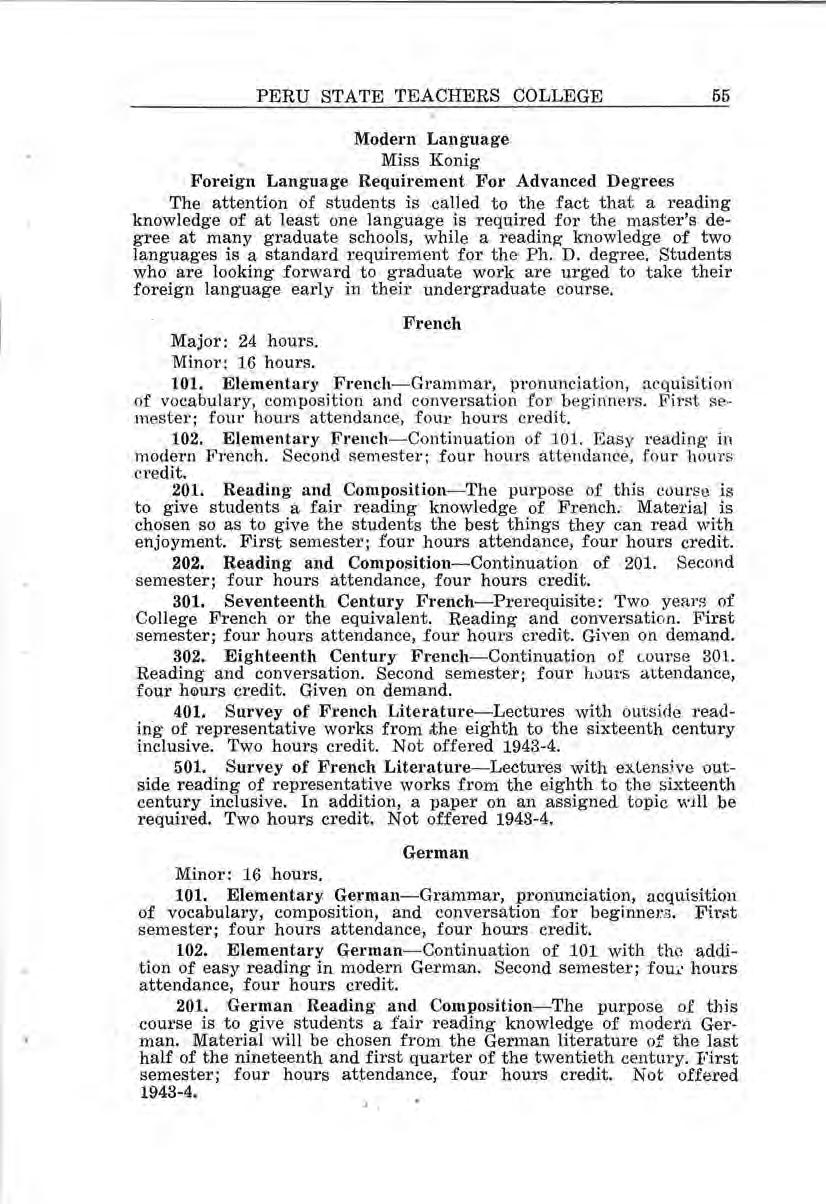
202. German Reading and Composition-Continuation of 201. Second semester; four hours attendance, four hours credit. Not offered 1943-4.
301. Third Year German- Prerequisites: two years of College
· German or the equivalent. The classical period of German literature including the study of Lessing, Schiller, Goethe. First semester; four hours attendance, four hours credit. Given on demand.
302. Third Year German.-Continuation of Course 301. Selections from Auerbach, Freytag, Raabe, Keller, Storm, C. F. Meyer. Four hours attendance, four hours credit. Given on demand.
401. Survey of German Literature-Lectures with outside reading of representative works from the eighth to the sixteenth century inclusive. Two hours credit. Not offered 1943-4.
501. Survey of German Literature-Lectures with extensive outside reading of representative works from the eighth to the sixteenth century inclusive. In addition, a paper on an assigned topic will be required. Two hours credit. Not offered 1943-4.

521. Historical Grammar of the German Language-Designed to introduce the student into historical research in linguistics, with special emphasis on Germanics. Based primarily on lectures and collateral reading. Two hours credit. Not offered 1943-4.
101. Elementary Spanish-Grammar, pronunciation, acquisition of vocabulary, · composition and conversation for beginners. Four hours attendance, four hours credit; first semester.
102. Elementary Spanish-Continuation of 101. Easy reading in modern Spanish . Four hours attendance, four hours credit; second semester.
201. Spanish Reading and Composition-The purpose of this course is to give students a fair reading knowledge of modern Spianish. Material will be chosen from Spanish literature of the last half of the nineteenth and twentieth centuq . Four hours attendance, four hours credit; first semester.
202. Spanish Reading and Composition-Continuation of Spanish 201. Four hours attendance, four hours credit; second semester.
Mr. Clayburn
Miss Hilernant
Students wishing to take a major in Geography for the A. B. Degree should complete courses 101, 102, and twelve hours of electives in the depiartment, eight of which must be of junior or senior rank.
To secure a minor in G~ography for the A. B. Degree a student should take course 101 and twelve hours of electives in the department.
All major and minor sequences of courses must be approved by the head of the department.
101. Princip les of Geography-An introductory study of the mutual relations between man and the elements of the natural environment. The course aims to develop a clear conception of environmental elements such as climate, land forms, soils, mineral deposits
tOn leave second semester, 1947-~3. •
and native vegetation and to show the adjustment of people to them, selected regions being taken as the units of study. First semester; three hours lecture, three hours laboratory, four hours credit.
102. Geography of United States-A study of the regional geography of the country. Emphasis is given the development of major resources and industries such as agriculture, mining, manufacturing and transportation and the fundamental geographic conditions controlling each. Aids in the interp<retation of American History. Second semester; three hours lecture, three hours laboratory, four hours credit.
104. Meteorology and Climatolog·y-An introduction to the science of meteorology. Facts and principles concerning the behavior and response of the atmosphere are set forth in such a way as to enable the student to acquire an understanding of the physical processes underlying observed weather phenomena, their application in weather forecasting and in aviation. Second semester; four hou.rs attendance, four hours credit.

*202. The Teaching of Elementary Geogl'aphy-Deals with classroom procedure in the teaching of elementary geography in the gr.ad es. Topics: basis for the selection and organization of materials for the various grades, elementary field work, introducing simple maps and diagrams, using pictures in lieu of the field, regional units, expression exercises, informal tests, games and other drill devices, and sources of material. Second semester; two hours attendance, two hours credit.
203. Historical Geography-Treats of the early geography of Europe and of the American continents. An attempt is made to trace conditions which lead to the discovery and colonization of the American continent. This is followed by .a study of the relation between earth conditions and earth resources on the one hand, and the settlement and development of the country on the other; the adjustments of a rapidly expanding people to varied environments and how they have helped to bring about present day conditions. First semester; four hours attendance, four hours credit.
206. Geography of Nebraska- A ~tudy of the soil regions, surface features, climate and natural resources of Nebraska in their relation to the agricultural and industrial development of the state. Second semester; two hours a.ttendance, two hours credit.
213. South America - A survey of the development of Mexico, Central America, and the countries of South America in their relation to the natural regions and natural resources. Emphasis on industry and commerce, and outlook for progress. First semester; four hours attendance, four hours credit.
215. Economic Geography-Survey of world geography and principles which affect industrial development. Emphasis is given the geographical factors influencing the production, distribution and trade in the more important world commodities; the development of trade centers and industrial regions, and the great trade routes of the world. Second semester; four hours attendance, four hours credit.
226. Conservation of Natural Resources-The natural resources of the United States as factors in national development. The exploitation of soils, forests, mineral resources; the reclamation of arid and swamp lands; the reductioµ of. erosion; the development of scien·tific forestry; the elimination of waste in mining; effective use of mineral fuels and metals; , t he improvement and extension of water-
ways; the use and control of water power; the prevention of floods and problems of water supply. Fourth quarter; four hours attendance, two hours credit.
300. Geography of Asia-A somewhat detailed study of the geographic regions of India, China, Japan, and a brief survey of the other regions of the continent. The major aims of the course are (1) to discover those features, natural and cultural, which in association give character to the region; (2) in comparative study of regions to explain the similarities and differences in the uses to which the land and its resources are put. First semester; four hours attendance, four hours credit.
304. Meteorology and Climatology-Similar to course 104. For juniors and seniors who have not had course 104. Additional readings and projects required. Second semester; four hours attendance , four hours credit.
3-09. The GeogTaphy of Europe- A regional study of the European countries is made emphasizing relief, climate, resources, and government and industrial development. Special attention is given to changes in the map of Europe and the geographic problems made prominent by the Great War. The study correlates closely with European History. Second hemester; four hours attendance, four hours credit.
310. The Geography of Africa- A survey of the continent by geographic regions. The objective of the co'urse is to establish the adjustment between (1) the complex of economic, social; and political life in each region, and (2) the complex of environmental elements which exist there. Third quarter; four hours attendance, two hours credit
311. The Geography of Australasia-A detail ed study of the geographical regions of Australia and a survey of the a djacent islands of the East Indies, Melanesia, New Zealand and Polynesia. The major aim of the course is to study how the generally hot, arid environment of Australia has affected a white race migrating from cool, moist lands. The economic features especiall_v those somewhat p,eculiar to Australia will be stressed. Second quarter; four hours attendance, two hours credit.
312. Economic Geography of North America- A s tudy of the natural regions of Canada and the United States. More intensive study of the regions of the continent. Problem organization to show the relationships between th e economic activities and the natural environment. First semester; four hours lecture, two hours laboratory, four hours credit.
405. General Geology- A s tudy of the earth- materials, minera ls a nd rocks, forces, process es, and agents operating within and on the surface of the earth. These facts and principles are used to interpTet the lithogenesis, stratigraphy, and paleontology of the earth. Laboratory work consists of field trips, determination of minerals and rocks, the identification and study of evo lutionary changes in the index fossil-forming animal and plants through the different geological eras. Second semester; four hours lecture, three hours laboratory, four hours credit.
410. Field Geography - An intensive course of training in the geographic field methods and in direct application of geographic principles to important prob,Jem s in· selected districts. In pursuing this course it is aimed for the , s tudep.t to acquire (1) ability ' to ob -
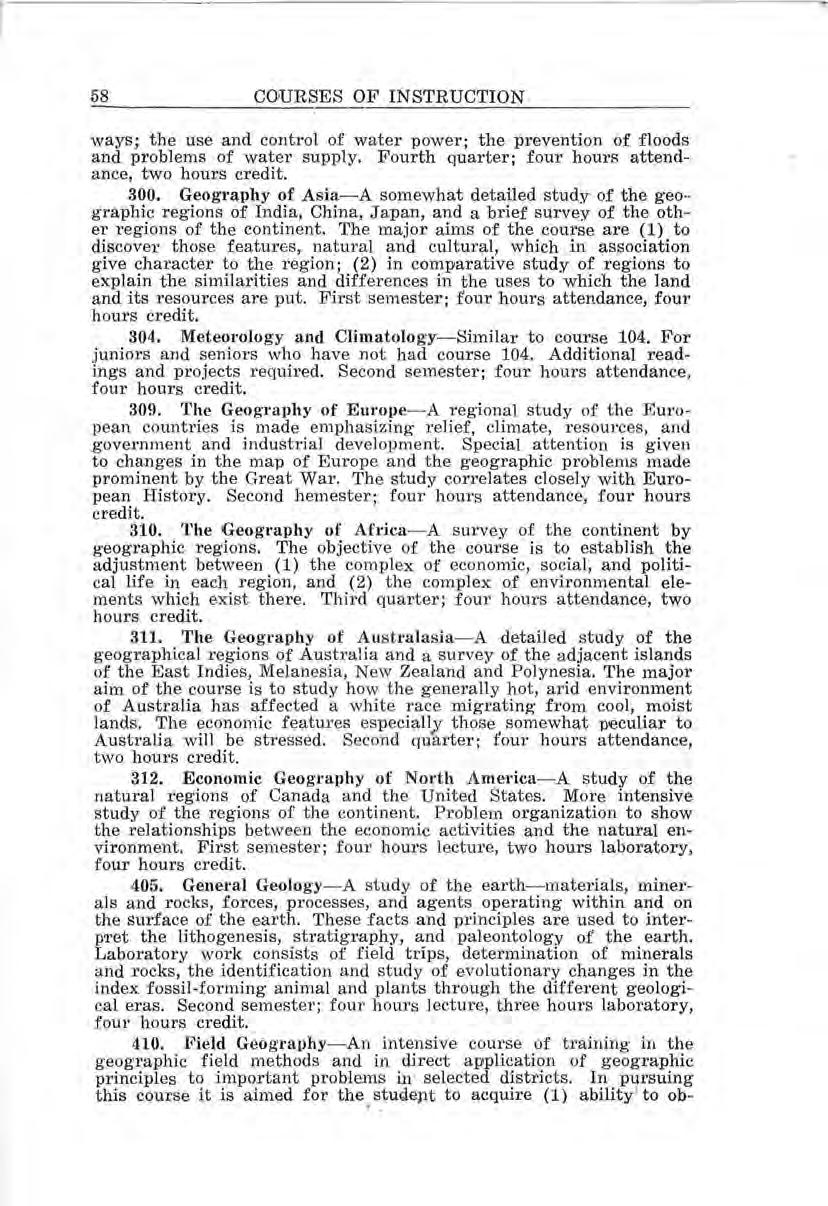
serve geographic facts in the field, (2) practice in determining the relative importance of facts observed, (3) experience, in reporting the results of field studies. Fourth quarter; four hours attendance, field trips on ·Saturdays, two hours credit.
Mr. Brown
Miss Harveyt
Mr. Millert
Mr. Reynolds
Students who major in history are urged to minor in social science. Similarly students who make social science their major should select a minor in history. This recommendation is based upon the close relationship between the two fields, the importance of each to a full understanding of the other and the fact that they are usual•ly assigned to the same secondary school teacher.
A major in history shall include courses 213, 214, 303, 304, either 101, 107, or 325, either 202, 402b, 470 or 471, and at least four hours of additiorial work in history, selected with the approval of the head of the department. If no minor in social science is carried, the history major must include courses 221 and 118.
A minor in history shall include courses 213, 214, 304, either 101, 107, 303, or 325, and 118.
A major in social science shall include courses 118, 220 or 314, 221, 316, 417, 458 and at least four hours of additional work selected with the ap,proval or the head of the department. If no minor in his •tory is carried, the social science major must include eight hours of history selected with the ap,proval of the department head.
A minor in social science shall include courses 118, 220, 221, and either 316, 401, 417 or 458. Students carrying one minor in history and another in social science must take either 202, 402b, 470 or 471. Geography 203 (Historical Geography) may be c0unted towards a major in history. Students planning to enter junior high school work should carry a minor in ge<5graphy.
No course in which the student fails to attain a grade of "C" will be accepted by the department as satisfying the requirements for a major or minor.
Students who intend to do graduate work in history or the other social sciences should elect at least two years' work in French or German, in view of the fact that a reading knowledge of at least one modern language is required of graduate students at most universities. Such students should likewise include in their programs course 470 or 471.
202. Junior High School Methods in History and Social Science

- Materials and methods for teaching history and social science in the junior high school; emphasis on organization of courses and units; observation. Prerequisite: eight hours credit in history and social science, or registration therein. Two hours credit.
402a-b. Senior 'High School Methods in History and Social Science- The nature and relationship of the social studies and their places and purposes in, secondary education with emphasis on matetOn 1eave of absence fov :war 5ervice.
rials and methods for te aching. History receives special consideration in the second part of the course. Op•en to s tudents who are majoring or minoring in history or the oth er social sciences and to persons of maturity or experienc e in teaching with the permission of the instructor. First semester; four hours attendance, two or four hours credit.
101. Western Civilization- An introductory survey of the development since .ancient times of the political, economic, social, religious, and cultural institutions of W estern civilization; objective analysis of contemporary problem s. Inten d e d to give gener.aI perspective as well as b ackgro und for further hi s torical study. Students preparing to major in history are ur ged to make this their introductory course in the field. Second semester; four hours attendance, four hours credit.
107. Survey of English History-Constitutional and social developments will be emphas ized . Students preparing to teach in the secondary schools, with a major in histo ry, are urged to make this course or course 101 their introductory college course in the field. First semester; four hours attendance, four hours credit.
112. Survey of American History - A rapid survey of the history of th e. Briti sh American co loni es and the United States, with emphasis on in stitutional growth. This course is designed pirimarily for prospective teachers in rural schools, and in the elementary grades of city systems. Open only to freshmen. Second semester; four hours attendance, four hours credit.
213. History of the United States, 1783-1865-The formation of the union; economic, diplomati c, and constitutional problems of the new government, the War of 1812; the South and s lav ery ; industrial beginnings; westward expansion; the Civil War. Required of history majors and minors. First semester; four hour s a ttendance, four hours credit.
214: · History of the United States, Since 1865- A continuation of course 213. Post -war reconstruction; th e last frontiers; the rise of big business; labor and capital; imperialism; the progressive movement; the World War; another period of reconstruction. Required of history majors and minors. Secon d semester; four hours attendance, four hours credit.

303. Modern European History, 1648-1815-The Age of Louis XIV; rise of Russia and Prussia; eighteenth century philosophy; economic and colonial rivalries; the "Old Regime"; the French Revolution and the Napoleonic Era; beginnings of the industrial revolution. Required of history majors. First semester; four hours attendance, four hours credit.
304. Modern European History, Since 1815- A continuation of course 303. Reaction, reform, an d rev olution, 1815-1848; growth of liberalism and nationalism; the industrial revolution continued; imperialism and the expansion of Europ•e; causes of the World War; the War and reconstruction. Required of hi story majors and minors. Second semester; four hours attendance, four hours credit.
312. American Colonial History- Foundation of the North American colonies; colonial expansion by th e Spanish, French , and British; colonial life, with emphasis upon social and economic forces; international rivalries; the revohition • of the British colonies. Not
open to students who have received credit for course 212, which this course replaces. Four hours attendance, four hours credit.
315. Survey of Ancient History-Rise of civilization in the Near East; the ancient Greeks and Romans; special emphasis on the contributions of ancient times to modern civilization. Four hours attendance, four hours credit.
325. Europe in the Middle Ages-The decadent Roman Empire; the Germanic invasions; feudalism; the medieval church; the crusades; intellectual and artistic renaissance; national beginnings; the commercial revolution; the break -up of the medieval church; the wars of religion. Four hours attendance, four hours credit.
458. American Diplomatic History - A survey of the whole field of American diplomatic relations from 1776 to date. Special emphasis will be given to the period since the Spanish-American War. Four hours attendance, four hours credit.
459. The West in American History-The westward movement of popu lation from the Atlantic to the Pacific, characteristic of the s uccessive frontiers; relations of the West with older areas of settlement. Prerequisite: a college course in American history Four hours attendance; four hours credit.
470. Topics in American History- An intensiv e course consisting largely of' readings, reports and round table discussions of topics chosen each year from one of the following fields . The American colonies, American immigration, the West in American history, American diplomatic hi story, American eco nomic history, the history of Nebraska, recent American histor y, or American historiography. Instruction will also be given in historical bibliography and in the criticism of historical sourc e materials. Prerequisite: twelve hours credit in h istory, including at least s ix hours in American history; or permi ss ion of the instructor. All students contemplating graduate work in American history s hould register for this course. Four hours a ttendance, four hours credit.
471. Topics in Modern European History- An intensive course consisting largely of readings, reports, and round table discussions of topics chosen each year from one of the following fie l ds : Reformation and religious wars, age of Louis XIV, eighteenth century, French Revolution and Napoleon, nineteenth century liberalism and nationalism. European international relations 1871-1914· , Europe since 1914, Europ~an economic hi s tory. Instruction will be given in historical bibliography and in the criticism of historical source materials. Prerequisite: twelve hours credit in history, including at least six hours in European history, or permission of the instructor. All students contemplating graduate work in European history should register f'or this course. Four hours attendance, four hours credit

118. American Government-National, state and local govern. ment of the United States. Each semester; four hours attendancF.>, four hours credit.
220. Sociology- Social problems . First semester; four hours attendance, four hours credit.
221. Economics-Preliminary view of Economics . The industrial organization of society.; occupation and division of labor; production, exchange and distriqp~ion pf wealth, wages, interest; rent and
profit; rise and fall of prices; transportation; domestic and foreign trade, protection; trusts and trade unions; socialism. Each semester; four hours a ttendance, four hours credit.
314 Modern Government Problems- Lectures and reading reports. Emphasis upon problems of representation, public opinion and the sphere of governmental activity. Four hours attendance, four . hours credit.
316. The Governments of Europe- Special attention to current European governmental problems. Four hours attendance, :four hours credit.
328. Advanced Sociology- Usually the student should have the prerequisite of Sociology 220 before registering for this course. Particular attention will be given to labor problems and social case method. Four hours attendance, four hours credit.
401. International Law-S ources of international l a w, recognition, succession, nationality, territorial jurisdiction, status of diplomats and consuls, treaties, pacific settlement, hostile measures short of war, war. First semester; four hour s attendance, four hours credit.
417 . . American Constitutional Law -A survey of the field of federal constitutional development; case method. Second semester; four hours attendance, four hours credit.
501. International Law-See description under course 401. Independent study and individual rep•orts required. Four hours attendance, four hours credit.
Miss Weare Miss Brackney
Major : Courses 101, 102, 201, 202, 331, and elective 8 hourstotal 28 hours. Art 203, Chemistry 101, 102, and 303.
Minor: Courses 101, 102, 331, and electives 4 hours- total 16 hours.
31. Home Nursing-Red Cross Stmidard Home Nursing course. Red Cross certificate given to those who successfully complete the course. Topics: care of sick in the home; communicable disease; maternal and child care; sanitation; nutrWon Open • to all college women. Two hours attendance; one hour credit.
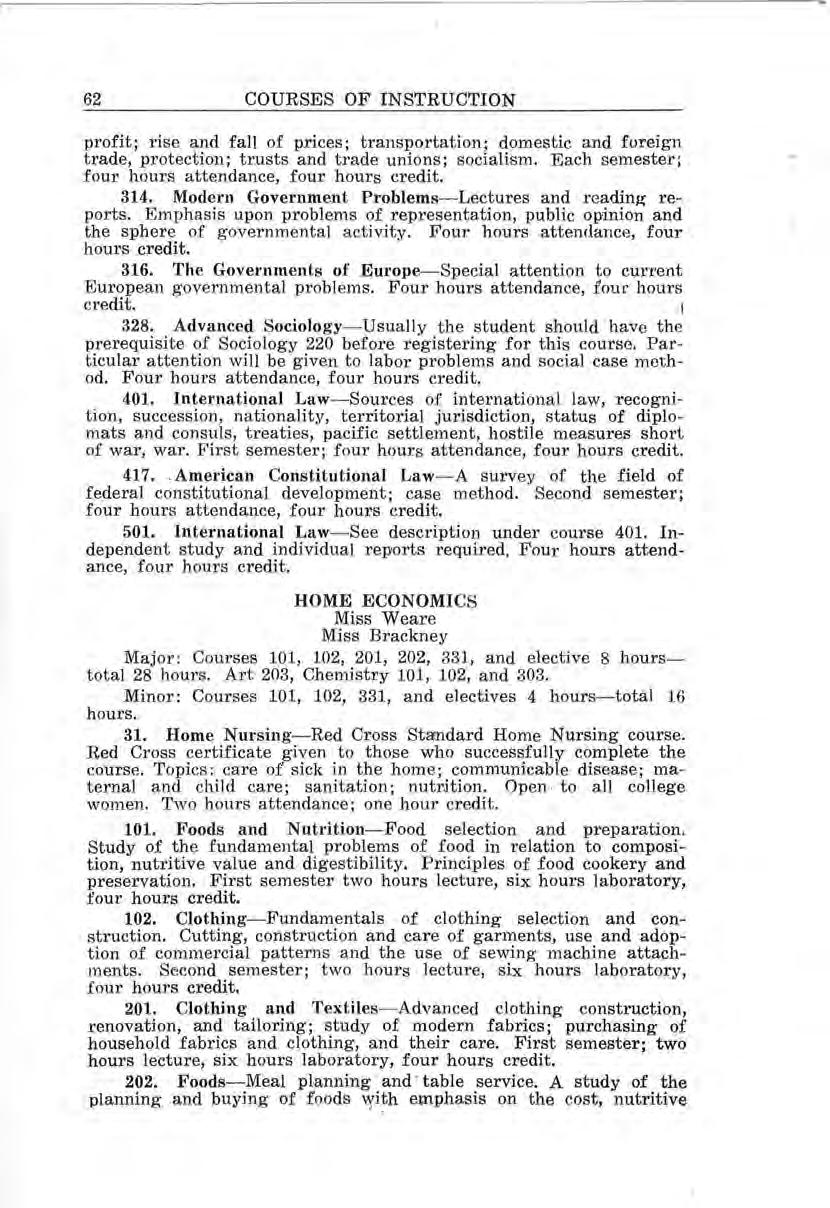
101. Foods and Nutrition-Food selection and preparation . Study of the fundamental problems of food in relation to composition, nutritive value and digestibility. Principles of food cookery and preservation. First semester two hours lecture, six hours laboratory, four hours credit.
102. Clothing-Fundamentals of clothing selection and construction. Cutting, construction and care of garments, use and adoption of commercial patterns and the use of sewing machine attachments. Second semester; two hours lecture, six hours laboratory, four hours credit.
201. Clothing and Textiles- Advanced clothing construction, renovation, and tailoring; study of modern fabrics; purchasing of household fabrics and clothing, and their care. First semester; two hours lecture, six hours laboratory, four hours credit.
202. Foods-Meal planning and · table service. A study of the planning and buying of foods 'Yi~h emphasis on the cost, nutritive
value and marketing of foods; also a study of the serving of informal meals, buffet service and teas. Second semester; three hours l ecture, four hours laboratory, four hours credit.
204. Table Service A study of the serving of informal meals, buffet service, and teas For students who have not had Course 202. Second semester; one hour l ecture, four hours laboratory, two hours credit. ·
206. Meal Planning- A study of the planning and buying of foods with emphasis on the cost, nutritive value, and marketing of foods. For student s who have not had Course 202. Second semester; two hours lectur e, two hours credit.
218. Nutrition for National Defense- Need for nutritional improvement, significance of food nutrients; characteristics of various types of foods; food costs and value; making nutritional knowledge more effective in food selection. No cre dit if a student has had course 314. Summer session; two hours attendance, one hour credit.
219. Nutrition and Health- A course for el ementary and rural teachers which gives an understanding of the fundamental facts of nutrition and its relation to the health of children. Food elements and their history, ·functions, sources, and preservation. Food preparation and selection of well -balanced diets. Two hours lecture, two hours credit.
230. Child Care and Development- Mental and physical development pf the child and a study of those influences which promote natural growth and health. First semester; two hours attendance, two hours credit. Not given in 1943- 4.

233 . Home Hygiene and Care of the Sick-Practical instruction and d emonstrations are given in bedside care of the sick, the sick-room, first aid, and control of communicable diseases. It aims to develop an appreciation of health and an interest in home, community and personal hygiene. Second quarter; four hours attendance, two hours credit
301. Foods arid Nutrition-Same as 101. For juniors and seniors who did not take 101. ., Firs£ semester; two hours lecture, six hours laboratory, four hours credit.
302. Clothing- Same as 102. For juniors and seniors who did not take 102. Second semester, two hours lecture, six hours laboratory, four hours credit.
304. Table Service-Same as course 204. For juniors and seniors who have not had courses 202 or 204. Second semester; two hours credit.
306 Meal Planning-Same as course 206. For juniors and seniors who have not had courses 202 or 206. Second semester; two hours lecture, two hours credit.
311. Costume Design-Principles of art applied in the selection and designing of appropriate costumes. Brief study of historic costume and its relation to modern dress and stage costumes. One dress is constructed from an original design. Second semester; two hours attendance, two hours credit.
314. Nutrition-Choice of food for different individuals and occasions; essentials of an adequate diet; recent advances in nutrition. First semester; two hours attendance, two hours credit.
315. Investigation ' Cookery-Prerequisite: course 101 or 301. Individual readings and e,c:perim.ental work in cookery problems; in-
vestigation in food preparation. First semester; one hour lecture, three hours laboratory, two hours credit.
316. Home Problems-Designed for both men and women. Units in family relations, home ex penditures, clothing selection, meal planning and serving, food preparation, and other home problems. Two hours attendance, two hours credit.
317. Consumer Problems-A study of the economic position of the- consumer and hi s problems as a buyer; analysis of the retailing activities and their cost; and methods of increasing the efficiency of consumer buying. Two hours attendance, two hours credit.
320. . Home P l anning and Furnishing-A study of the points to be considered in building, buying, or renting a house, and in the selection and arrangement of the furnishings from the standpoint of comfort, beauty, and economy. Second semester; two hours attendance, two hours credit.

331. Home Economics Methods-Theory and practice of teaching Home Economics in public schools. Study is made of courses in various types of institutions. Courses of study and home projects are planned for graded schools, high schools, and colleges. First semester; four hours attendance, four hours credit.
432. Seminar in Home Economics-Independent studies in Home Economics Weekly conferenc es On demand. 'l'wo to four hours credit.
433. Home Management-Management problems of the homemaker in regard to income, time, labor and family relations, and a study of the efficient use of time and energy in household processes. Two hours attendance, two hours credit .
Mr. Larson
Mr. Lindstrom t
Major: Courses 101, 102, 110, 116, 209, 213, 214, 219, 302, 303, 304, and six hours of departmental electives.
Minor: Courses 101, 102, 110, 209, ~19 , 302, and 304. Course 30!5 may be substituted for courses 101 and 102 .
101. Bench Woodworking-A teachers course in woodworkii1g for junior and senior high schools. The cou.rse aims to deve lop a high grade technique in handling woodworking tools and materials while working out a number of suitable projects . It does not involve the use of machines. Required of al] majors and minors. First semester and summer schoo l ; four hours attendance, two hours pr.-paration, two hours credit. Fee $1.50. Material deposit $2.00.
102. Bench Woodworking- This is a continuation of Woodworking 101. Its purpose i s to dev elop further proficiency in the handling of the common woodworking too ls while working out a number of projects. Prerequisite: Course 101. Second semester and summer school; eight hours atte ndance, two hours preparation, two hours credit. Fee $1.50. Deposit $2.00.
106. Woodturning-Spindle, face plate, oval, duplicate, chuck and spiral turning in wood. Finishing and polishing are also included. Each quarter and summer school; eight hours attendance, two hours preparation, two hours credit. Fee $1.50. Deposit $1.00 .
110. Shop Maintenance-Instruction in the use and care of the equipment commonly found in t}Je_ ind\tstrial arts shops and a study
of the various s harpening devices. Practice will be given in the crmditioning of han'd and power saws, knife too l sharpening and setting of the · same in the machines. Required of majors and minors . First a nd second semesters and summer school; eight hours attendance, two hours preparation, two hours credit. Fee $1.00.
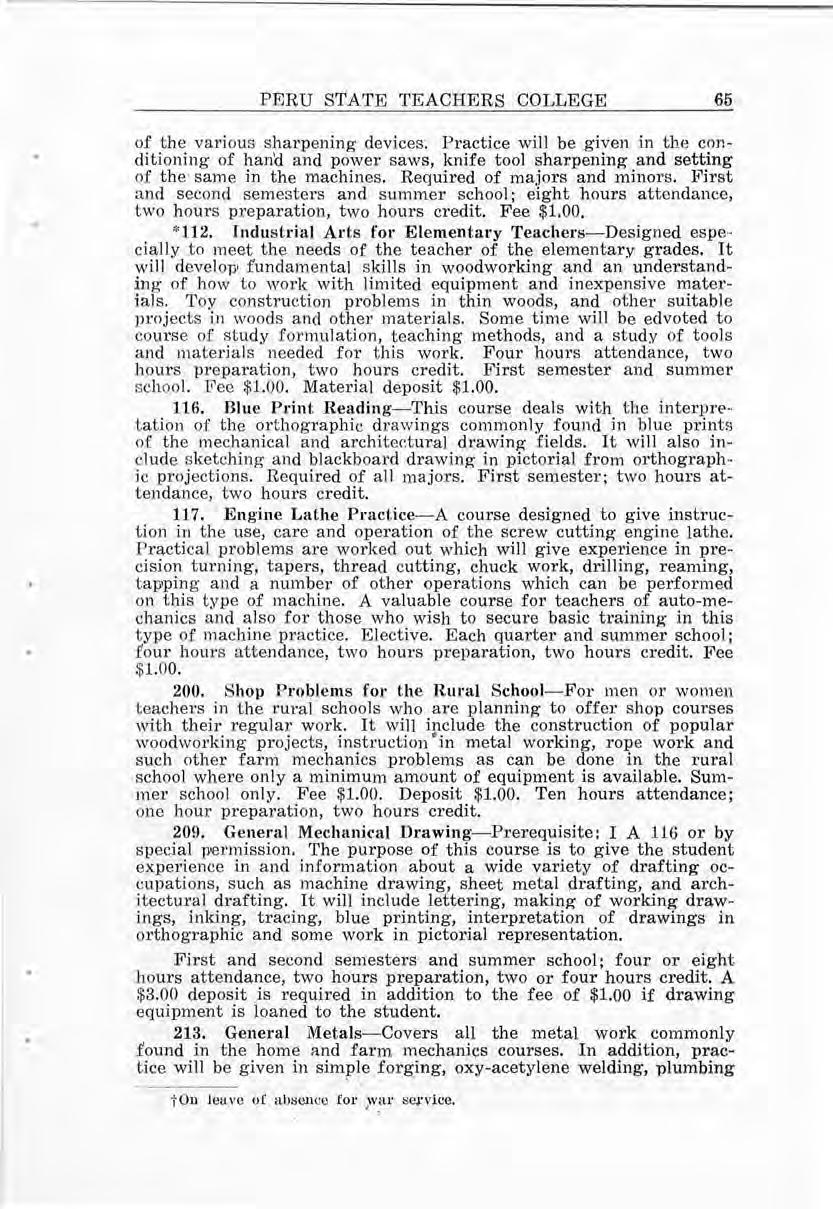
'''112. Industrial Ai·ts for Elementary Teachers-Designed espe •• cially to meet the needs of the teacher of the elementary grades. It will develop• fundamental s kills in woodworking and an understandin g of ho w to work with limited equipment and inexpensive materials. Toy construction problems in thin woods, and other suitable projects in woo d s and other materia ls. Some time will be edvoted to course of s tudy formulation, teaching methods, and a study of tools and materials needed for this work. Four hours attendance, two hours preparation, two hours credit. First semester and summer sch oo l. Fee $1.00. Material deposit $1.00
116. Blue Print Reading - This course deals with the interpre tation of the orthographic dr aw ings commonly found in blue prints of the m echanical and architectural drawing fields. It will also inc lu'de ske t ching and blackboard drawing in pictorial from orthographic proj ections. Required of all majors. First semester; two hours attendance, two hours credit. ,
117. Engine Lat he Practice-A course designed to give instruction in the use, care and operation of the screw cutting engine lathe. Practical problems are worked out which will give experience in precision turning, tapers, thread cutting, chuck work, drilling, reaming,' tapping and a number of other operations which can be performed on this type of machine. A valuable course for teachers of auto-mechanics and also for those who wish to secure basic training in this type of machine pr ac tice. Elective. Each quarter and summer school; four hour s a ttendance, two hours preparation, two hours credit. Fee $1.00.
200. Shop Prob lems for the Rural School-For men or women teachers in the rural ·schools who are planning to offer shop courses with their regular work. It will include the construction of popular woodworking projects, instruction °in metal working, rope work and such other farm mechanics problems as can be done in the rural school where only a minimum amount of equipment is available. Summer school only. Fee $1.00. Deposit $1.00. Ten hours attendance; one hour preparation, two hours credit.
209. General Mechanica l Drawing-Prerequisite: I A 116 or by special p•ermission. The purpose of this course is to give the student ex perience in and information about a wide variety of drafting occ upations, s uch as machine drawing, sheet metal drafting, and architectural drafting. It will include lettering, making of working drawings, inking, tracing, blue printing, interpretation of drawings in orthographic and some work in pictorial representation.
First and second semesters and summer school; four or eight hours attendance, two hours preparation, two or four hours credit. A $3.00 deposit is required in addition to the fee of $1.00 if drawing equipment is loaned to the student.
213. General Metals-Covers all the metal work commonly found in the home and farm mechanics courses. In addition, practice will be given in simple forging, oxy-acetylene welding, plumbing .. . . '
tOn lea ve of absence for }V'.1 r service.
and sheet metal work. Emphasis will be placed upon such operations as ·sawing, filing, chipping, drilling, and tap and die work. - Required of all majors, Fourth quarter and summer school; eight hours attendance, two hours preparation, two hours credit. Fee $1.50.
214. Practical Electricity-General principles and their application to motors, generators, and heating and lighting- systems. It will provide ex perience in all the repair jobs in electrical work commonly fond in home mechanics courses. It will also provide practical experience in the various forms of interior wiring. Required of majors. Third quarter and summer school; eight hours attendance, two hours p,reparation, two hours credit. Fee $1.50.

215. Safety Education-Materials and methods in traffic safety and automobile driving, with some attention given to farm, home and community accident prevention. Topics for discussion will include principles of motor car operation; highway and traffic laws; psychological reactions; safety patrols; farm, home, and community accidents and hazards and how to prevent them. A driving- laboratory will provide opportunity for learning and practicing correct driving technics. Two hours lecture, two hours laboratory; one hour credit. •
216. Sheet Metal-Prerequisite : Course 209 or by special permission. The fundamental processes ·of sheet and metal work, including such hand tool operations as seaming, double seaming, burring, crimpfog, wiring, forming, and beading, which are taught on standard sheet metal equipment. Four hours attendance, two hours preparation, two hours credit. First semester and summer school. Fee $1.50.
218. Oxy-acetylene Welding-Prerequisite: Course 213 or by sp ecial permi ss ion from the instructor. Includes the study of the composition of metals and fluxes as directly related to welding. Experience will be given in the brazing- and welding of the common metals such as cast iron, the steels and aluminum Four hours attendance, two hours preparation, two hours credit; each semester a nd summer school. Fee $1.00. Deposit $2.00.
219. Farm and Home Mechanics-This course is designed for men and women teachers who are interested in teaching shop work in rural communities or small high schools where there is little equipment available to carry on such type of work. It will give an oppor•tunity to construct a number of popular woodworking projects and in addition will give instruction in metal working, rope work and in numerous miscellaneous repair jobs which are commonly found about the home and farm. Second semester and summer school; four hours attendance, one hour preparation, two hours credit. Fee $1.00. Deposit $1.00.
250. Amateur Radio-Prerequisite: High School Physics or Elementary Electricity 114 or equivalent. Construction of short wave radio receiving sets and instruction in the elementary principles governing radio communication. The careful workman will have no difficulty in this course to construct a set with which he can easily secure foreign radio reception. This will give an excellent opportunity for those who are interested in establishing radio clubs and also for those who would like to develop an interesting hobby. Each semester and summer school. Fee $1.00. Ten hours attendance, two hours preparation, two hours credit. Each term.
302. Machine Woodworkihg_:._Prerequisite: Courses 101 and 102. Designed to teach the advanced ,,w:ork -of the senior high school, The
use of machinery is emphasized and a wider scope of tool operation is given. Modern production methods and procedure will be studied in working out group projects. Required of majors and minors. Third quarter and summer school; eight hours attendance, two hours prreparation, two hours credit. Fee $1.50. Material deposit $2 .00 .
303 , Machine Woodworking- A continuation of ·course 302. Prerequisite : Course 302. ·Required of majors. Fourth quarter and summer school; eight hours attendance, two hours credit. Fee $1.50. Deposit $2.00.
304. Industrial Arts Methods and Observation-Historical development of the industrial arts; place in the curriculum, principles, methods, materials and equipment. Required of all departmental majors and minors and will be of special interest to superintendents and principals. First semester; four hours attendance, four hours credit.

305. Bench Woodworking- Similar to Woodworking 101 and 102 with the exception that it is more advanced and especially designed for those juniors and seniors who are desiring to work out a major or minor in the department. Students who have had courses 101 and 102 are not eligible for credit for this course ., First semester and summer school; eight hours attendance, two hours preparation, four hours credit. Fee $3.00. Material deposit $3.50.
306. Fibre Furniture Weaving-As courses in art fibre weaving are being offered in a number of schools in the state, it would be well for the industrial arts teacher to become acquainted with this type of work It consists of the manufacture of a number of projects such as fibre baskets , chairs, davenports, rockers, etc. It will include instruction in methods of presentation and organization of such courses in schools . Elective. Second quarter and summer school; four hours . attendance, one hour credit. Fee $1.00. Deposit $2.00.
309. Woodturning-A course similar to Woodturnin g 106 but involving additional and more difficult projects. It is designed for juniors and seniors who have had no woodturning. Each quarter and summer school; eight hours attendance, two hours preparation, two hours credit. Fee $1.50. Deposit $1.60.
310. Shop Maintenance-Same as course 110. For juniors and seniors who have n ot had course 110. More difficult projects required. First and second semesters and summer school; eight hours attendance, two hours preparation, two hours credit. Fee $1.00.
312. Architectural Drawing-A practical course for students, carpenters, home builders and others desiring a knowledge of building design and the architectural construction of small frame buildings. The work deals essentially with building planning, building construc tion and methods of drawing. It is adapted to those who desire to take up architectural drafting as a vocation. Architectural conventions, basement and foundation plans, floor plans, elevations, framing and construction details, specifications and estimates. Elective. First semester and summer school; eight hours attendance, two hours preparation, two or four hours credit. Fee and deposit same as course 209.
317. Engine Lathe Practice-A substitute course for 117, but involves more difficult problems in metal turning Designed especially for those juniors and seniors who have not had an opportunity to register for the freshman ,course . . Elective. Each quarter and summer school; four hours attendance, two hours preparation, two hours credit. Fee $1.00. •
415. Auto Mechanics-Funadmental principles of the gas engine, its operation, and repair. Includes types of engines, carburetion, ignition, cooling system, lubrication, speed regulation, timing of engines, fitting piiston rings, grinding- valves, trouble hunting, etc. First semester and summer school; eight hours attendance, two hours preparation, two or four hours credit. Fee (2 hours credit) $1.25. Deposit $1.25.
416. Machine Woodworking-Continuation of courses 302-303 witht special study , on the construction of period furniture and adaption to present day needs. Second semester and summer school; four hours attendance, two hours preparation, two hours credit. Fee $1.50. Material deposit $3.00.
418. Oxy-acetylene Welding-Prerequisite: Course 213 or by special p ermission from the instructor. Duplicates course 218. For juiors and seniors who have not had course 218. More difficult projects required. Four hours attendance, two hours preparation, two hours credit; each semester and summer school. Fee $1.00. Deposit $2 .00.
421. Up holstery and Woodfinishing- Prerequisite: Courses 101 and 102. Designed to furnish experience in the principal types of woodfinishing suited to grade and high school work. A study is made of the modern finishes and their uses in the school shop. In upholstery, various methods of construction are studied, both with and without the use of springs. First semester and summer school. Two hours credit. Fee $1.00.
Mr. Hillt
Mr. Huck
Miss Pool
Mr. Sweetlandt
Recognition is given to two types of majors as follows:
1. Those who plan to become eJementary or secondary school teachers, supervisors, or principals take the following: Courses 103, 105, 2 hours of 216 or 307, and electives 10 hours-total 20 hours. Eight of the 20 hours must be in courses of junior or senior rank.
2. Those who plan to enter scientific, technical, or r~search work take the following: Courses 103, 105, 206, 220, 309, 3iO, and 2 hours of 216 or 307.
A minor sha.Jl include a total of 16 hours, including 2 hours of 216 or 307. Four of the 16 hours must be in courses of junior or senior rank.
101. Algebra-Prerequisite: One year of beginning algebra and one year of plane geometry. Four hours attendance, four hours credit.
102. Solid Geometry-Prerequisite: One and one-half years of algebra, and one year of plane geometry. Given during- the summer school. Four hours attendance, four hours credit.
103 : College Algebra-Prerequisite: One and one-half years of algebra, and one - year of plane geometry. Students who find this course too advanced will be permitted to transfer to Algebra lOu.. First semester, four hours attendance, four hours credit.
tOn leave of absence for war ' service.
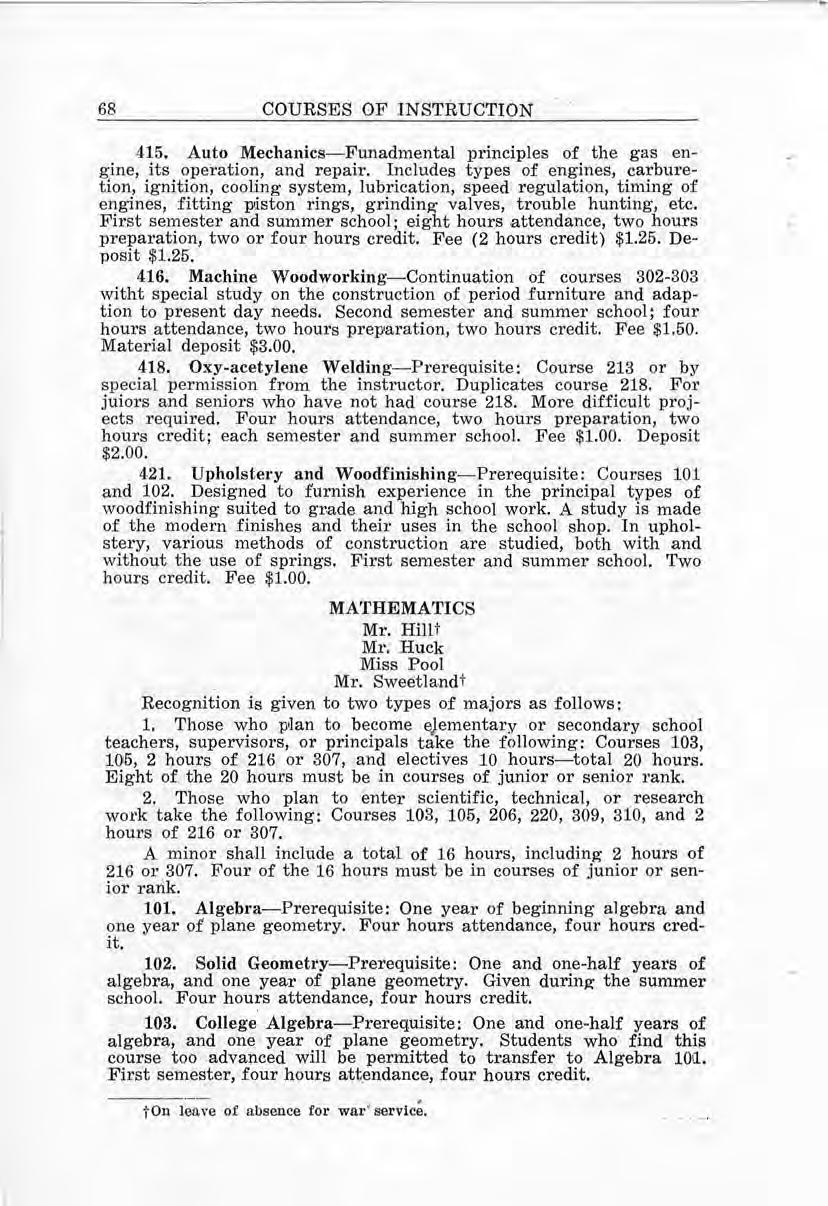
1.05. Plane and Spherical Trigonometry-Prerequisite: Course 103. Second semester; four hours attendance, four hours credit.
11.5. Vocational Mathematics Prerequisite: Same as for 103. Recommended especially for students interested in applied mathematics, those •specializing in manual training. Students may enter this course, either or both quarters. Second semester; four hours attendance, four hours credit. · ,
206. ' Analytic Geometry-Prerequisite: Course 105. First semester; four hours attendance, four hours credit.
21.6. Professionalized Mathematics-A study of the fundamentals of arithmetic, including the four fundamental operations, fractions, and decimals the first quarter and denominate numbers, graphs, percentage, interest, . commercial paper, taxes, and insurance the sec. ond quarter. Includes work in observation. Mathematics or education credit. Second semester; four hours attendance, two or four hours credit. ·

21.8. Surveying-Prerequisite: Course 105. Fundamental theory and practice, use of transit, surveying methods, United States public land surveys, .legal forms, surveying computations, map a.nd blue print reading, field and office work. ·First or fourth quarter; four hours attendance, two hours credit.
220. Mathematical Analysis-The course is intended for students wishing a major or minor in mathematics and who were unable to get the preliminary courses in the freshman year. It prepares directly for the courses in .analytic geometry and the calculus. Students should not attempt this course without having had at - least five semesters of' high school mathematics or the equivalent. Four hours attendance, two or four hours credit. Second semester,
301.. Spherical Trigonometry-Prerequisite: 105. A continuation of the course in trigonometry which prepares for course in surveying. A valuable preparation course for students who plan to take astronomy. Second quarter; two hours credit. .
303. Solid Analytic Geometry-Prerequisite: Course 206. A study of three dimensional space in~luding loci, the plane, the straight line, surfaces and curves. Two hours credit.
304. College Geometry-Prerequisite: Two semesters of high school geometry. A thorough introduction to the geometry of the triangle and the circle. The course deals with the leading· properties ·of the notable lines, points, and circles associated with a p•lane triangle, the geometry of circles and systems of circles. Recommended for teachers and prospective teachers of high school geometry. Second semester; four hours attendance, four hours credit.
306. Astronomy-An elementary descriptive course, valuable ·to prospective teachers of mathematics, geology, geQgraphy and general science. This course may be included to meet the requirements for a teaching minor in physica,l science Second semester; four hours attendance, four hours credit.
307a. Materials and Methods for Teaching Secondary Mathematics~This course will be devoted to the teaching of mathematics in the junior high school grades. First quarter; four hours attendance, two hours credit.
307b. Materials and Methods for Teaching Secondary Mathematics-A course similar to the "a" course but devoted to the ·subjects taught in the senior high s'chool. Both courses include work in observation. Second quarter4 four• hours attendance, two hours credit.
308. Mathematics of Finance-A study Qf compound interest and annuities, which is followed by practical problems in amortization, sinking funds, depreciation, valuation of bonds and building and loan associations. Second quarter; four hours attendance, two· hours credit.
309. Differential Calculus-Prerequisite: Course 206. First semester; four hours attendance, four hours credit.
310. Integral Calculus-Prerequisite: Course 309. Second semester; four hours attendance, four hours credit.
..
312. History of Mathematics-Prerequisite: Ten hours of college mathematics. Two hours credit.

313. Differenti-al Equations-Prerequisite: Course 310. Four hours attendance, four hours credit. ·
316. Statistical Analysis-Prerequisite: Same as for course 103. The principles of statistics as applied to data from the social and natural sciences and to educational data. Given during the summer school. First quarter, four hours attendance, two hours credit.
404. Reading Course-Selected topics in current mathematical literature. Conferences and reports. Open to students who have met requirements for a minor in mathematics. Limited to one hour credit per semester and a total of two hours for any student.
Mr. Benford
Mr. Jindra
Mr. Steckt
Major: 101, 104, 205, 208, 312, 315, 316, 405, and six hours of applied music. Membership in one musical organization ( chorus, orchestra, band or piano ensemble) for 4 semesters is required.
Minor: 101, 104, 208, 312, electives, two 'hours, and applied music, four hours. Membership in one musical organization (chorus, orchestra, band, or piano ensemble) for. 2 semesters is required.
Three hours is the maximum credit which may be earned in ensemble music, except music majors, who may earn six hours.
18. Piano Ensemble- Each semester two hours attendance, onehalf hour credit.
19. Chorus-Prerequisite: Singing ability to the extent of being able to sing in tune and to read music. Regularity of attendance at all rehearsals and public appearances is required. Each semester; four hours attendance, one hour credit.
20. College Orchestra-Each semester; two hours attendance, one-half hour credit.
21. College Band- Each semester; two hours attendance, onehalf hour credit.
101. Elementary Theory- Theory, sight singing, and ear training. This course covers the fundamentals of music and the first two hours fulfill the puiblic school music requirement. It also deals with sight singing and ear training as a foundation for the methods of teaching music. First semester; four hours attendance, four hours credit. ·
104. Harmony-Prerequisite: Course 101. Review of theory building triads, making melodies, harmonizing melodies in major , and ton leave of absence for war" service.
minor modes, authentic, plagal and deceptive cadences, the 6-4 chord, · and the 7th chords. Second semester; four hou.rs attendance, four hours credit.
*110: Public School Music-For the grade teacher who will teach the daily lesson in the classroom. Rote songs, ear and eye training, tonal and rhythmic development, beginning singing, writing from memory familiar figures, p,hrases and songs on the staff; simple sight reading. Each semester; two hours attendance, two hours credit. ·
120. Voice Culture-Freshman and sophomores who desire credit in Chorus 19 must first take this course. Fundamentals of tone production, articulation and part singing. Two hours credit allowed. First semester; three hours attendance, one hours credit.
205. Harmony-Prerequisite: Course 104. Continuation of 104, introducing irregular progressio·ns, modulations, elementary counterpoint, and stressing originality in the writing of melodies and harmonies. First semester; four hours attendance, four hours credit.
208. Methods of Teaching Music (formerly 102)-Prerequisite: Course 101. Methods, materials and observation for all grade music in the primary school, upper grades and high school. Observation both in singing and appreciation. Second semester; four hours attendance, four hours credit.
215. Rhythm Orchestra Problems-A study of the problem involved in the organization and direction of rhythm orchestras, selection of instruments and music, technique· of directing, and group rehearsals. Three hours credit. Summer school only.
303. Counterpoint-Study of the forms of contrapuntal writing in two, three and four voices. Writing of the "invention" in the free style wilJ be included. Prerequisite: Elementary Theory. First semester; four hours attendance, four hours credit. Not given in 1943-4.
304. Advanced Hal'mony-Prerequisite: Course 205. A study of modulations and altered chords from the writing and analytical viewpoint. Practical composing and a»ranging for voices .and piano. First semester; four hours attendance, four hours credit. '
311. Music Appl'eciation-Lectures, illustrations, and class discussions of music as an art form, as a recreation, as a vocation, and as a community activity. Some attention is given to the philosophy and the development of music education. Each semester; two hours attendance, two hours credit.
312. Advanced Appreciation-A course in appreciation designed on the seminar plan. Music students will be given opportunities to familiarize thems elves with forms of musical expression. A constructive correlation of the major musical forms and organizations and their rightful place in the school curriculum and society. For majors and minors in lieu of course 311. First semester; two hours attendance, two hours credit.
315. Study of Instruments-Prerequisite : Music 1:04. First half: a study of stringed instruments-violin, viola, cello and bass. Second half: a study of wood-wind, brass and percussion instrum.ents. First semester; four hours attendance, four hours credit.
316. Band and Orchestra Tecl{nic-Prerequisite: Music 315. Materials and methods use.d in the organization and development of instrumental groups; technic of directing; arranging of scores. Second semester; four hours attendance, fours hours credit.
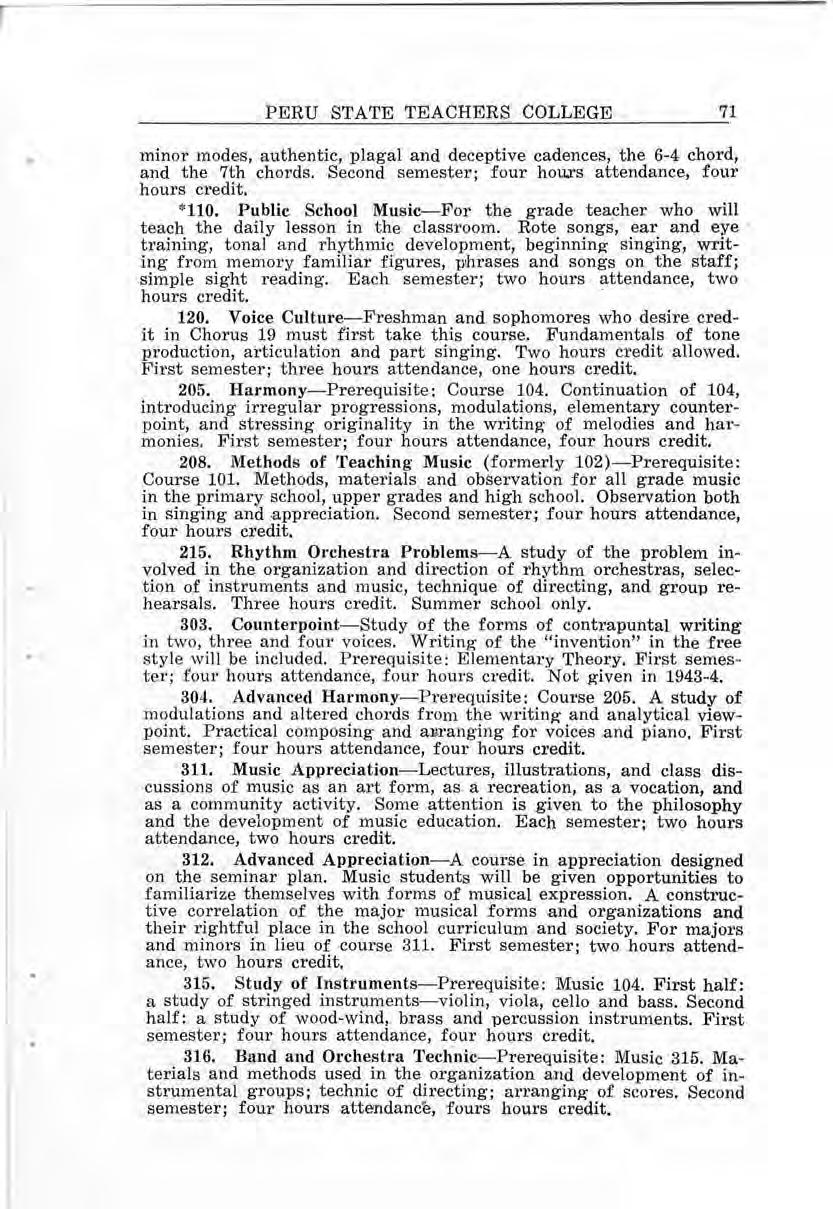
321. Voice Culture-Prerequisite: Voice Culture 120, two hours, or voice lessons, two hours. Designed primarily to provide actual experience with voice problems which confront the teacher as a director of vocal groupis. Students in this class will assist the director of the chorus with such matters as sectional rehearsals-I tone drills, and other details of chorus rehearsal rountine. Two hours credit allowed. Second semester; three hours attendance, one hour credit.
401. Choral Conducting- A practical study in the organization, training and conducting of glee clubs, choruses and vocal ensembles. First semester; two hours attendance, two hours credit.
405. History of Music-Prerequisite: Co urses 101 or 110 and 104. The music of ancient nations and its relation to our modern system; early church music; folk music of the Middle Ages; polyphony and monophony explained and discussed; the story of notation; rise and development ·of the opera and our modern symphony; classical and romantic schools of' composition; modern instrumental music. The aim throughout this course is to trace the growth of music not by mere statement of facts, but through analysis of causes which lead to certain definite results. First semester; four hours attendance, four hours credit:
410. Form and Analysis-Prerequisite: Four hours of harmony
An analytical study of themes and their , relations with some elementary composition. Listening to forms of music for the purpose of developing ability to recognize and appreciate the different 'types. Second semester; two or four hours atendance, two or four hours credit.
Private les sons in piiano, all stringed instruments, - bass instruments, wood-wind instruments, and voice- $1.25 per lesson. Groups of five or more may secure class instruction at $.25 per l esson. ( See Director.)
Credit f'or private lessons taken uiider the direction of the college faculty may be earned as follows: For one period daily practice and one lesson a week a credit of one college hours each semester may be earned. Senior students who give a recital may earn two semester hours of credit for the semester in which th e recital is givn.
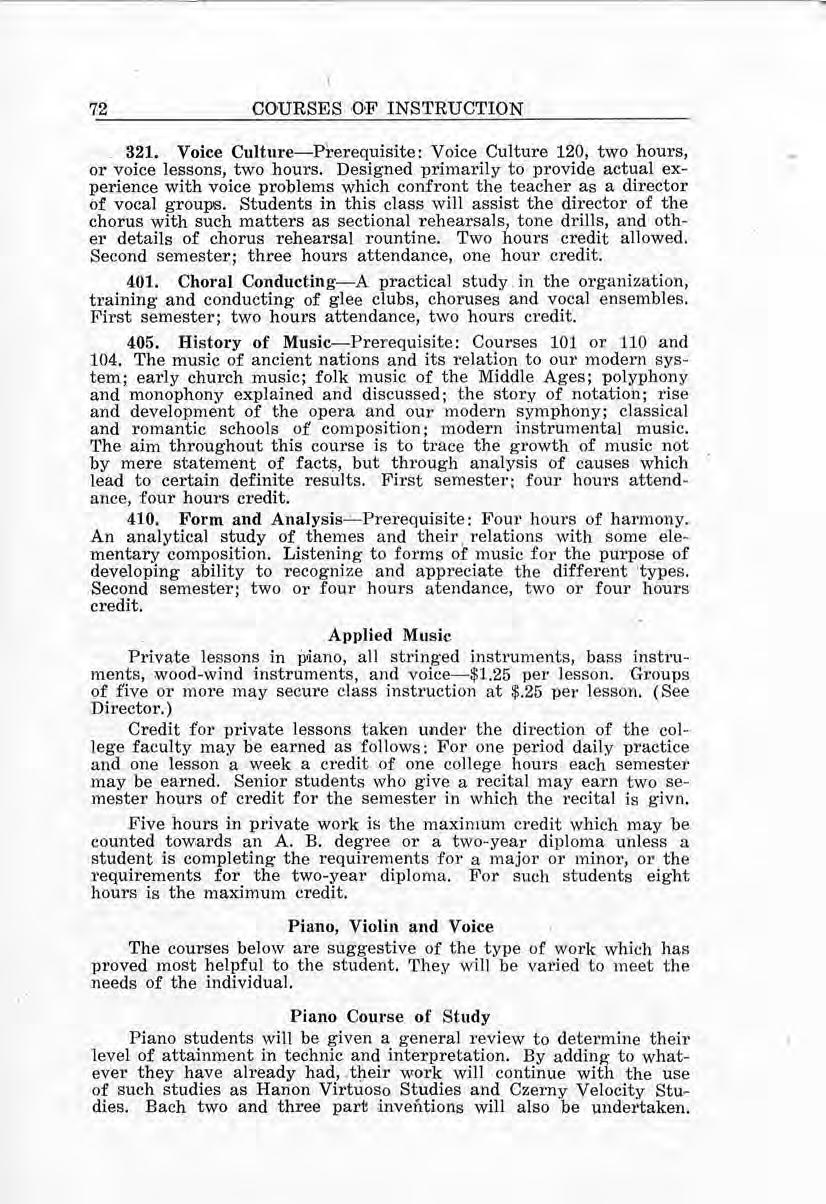
Five hours in private work is the maximum credit which may be counted towards an A. B. degree or a two-year diploma unless a student is completing the requirements for a major or minor, or the requirements for the two-year diploma. For such students eight hours is the maximum credit.
The ·courses below are suggestive of the type of work which ha s proved most helpful to the student. They wilJ be varied to meet ·the needs of the individual.
Piano students will be given a general review to determine their level of attainment in technic and interpretation. By adding to whatever they have already had, their work will continue with the use of such studies as Hancin Virtuoso Studies and Czerny Velocity Studies. Bach two and three part :inventions will also be undertaken .
Other technical works will be used to fit the individual needs of the pupil. Pieces of standa rd an4 modern : composers wil! be studied. Pianists will be excep'Cte d _ to be fairly good sight readers, play simp l er accompaniments, and play medium difficult pieces in an interesting manner. Sightreadin g accompanies every lesson in order that the general ability and aptitude will be properly improved. It is sugges ted that those taking the more advanced work should appear in public in the capacity of a so loist or accompanist.
The study of the violin is approached both from the standpoint of the teacher and th e performer . There is an increasing demand for teachers who know and can explain the technique of violin playing, and this co urse gives an ,opportunit y for such analysis and study. Principles, rather than any particular method, are stressed throughout the course. The ma.terials for study are selected according to the needs and advan cement of the stud ent.
The study of singing is a thoroughly personal matter ·and depends wholly upon the individual and his natural and acquired capacities.
The work of the student of singing is planned and graded in relation to the d egree of advancement evidenced by the applicant. Since improvement in singing is essentially a matter of personality <level. opment, the materials are chosen to suit the needs of each individual. (The principal need of the beginner is vocal exercise which will strength en the voice to meet the increasing demands placed upon it by the ever en larging piersonality.) Study material is chosen from the vocalizes of Concone and Vaccai along with the more simple of classic songs. As the stud ent advances, repertoire is chosen to compliment the personality and insure sound physical development of the voice. · •
To in sure a broad approach to vocal problems and repertoire building, private stud ents of singing meet in class twice each month . They sing for each other and discuss the many phases of singing as suggested by the performances. These meetings also affo rd an · inv aluable opportunity for repertoire stu dy and song interpretation.
Mr. Wheeler
Mr. Jonest
Mrs. Wheeler
Required credit ·for two-year curriculum, two hours; for fouryear program, or A. B degree, four hours. Maximum credit in Physical exercise allowed for two-year p1rogram four hours; for four-yeai· program or A. B. de gree unless a major or minor, six hours. .
Physical Education 101 or 102 is required of a ll men. The remaining three hours may be se lect ed from 101 or 102, 203, 204, 9, and 3 (Women). It is provided, however, that one hour for diploma and two for the degree may be earned in any of the sports-football, basketball, track and tenni s
tOn l eave of absence for ' war serv ice

Major: Courses 9, 101, 102, 203, 204, 207a-b-c, 214, 301, 302, 309, 312, elective one hour and Biology 205-total 24 hours and participation in each of the three major sports-football, basketball, and track - for one season.
Minor: Courses 101 or 102, 203, or 204, 207-.a -b-c, 214, 301, 302, and Biology 205-total 16 hours, and participation in the three major sports-football, basketball, and track-for one season.
1. Football and Basketball-First semester; three hours attend • ance, one hour credit.
2. Basketball and Track-Second semester; three hours attendance, one hour credit.
9. Swimming-Aquatic games, life saving, diving, crawl stroke, back stroke, side stroke and the methods of teaching swimming. Not more than one hour of swimming will be accepted toward diploma or degree . Each semester; three hours attendance, one hour credit.
10. Tennis-Summer school only; five hours attendance, one hour credit.
101. Natural Program-Activities course. Volley ball, hand ball, speed ball, soccer, boxing, wrestling, tumbling and playground ball. Course includes activities which can be used in the elementary and secondary schools. First semester; three hours attendance, one hour credit. ·
102. Natural Program- Continuation of course 101. Second semester ; three hours a,ttendance, one hour credit.
203 . Tumbling and Stunts-Tumbling stunts and some apparatus work in line with ability of the class . Advanced work will be given according to the ability of the class. First semester; three hours attendance, one hour credit.
204. Tumbling and Stunts- Continuation of cour se 20 3. Second semester; three hours attendance, one hour credit.
205. Physiology of Exercise-Anatomy and Physiology of the neuromuscular system. Physiological study of' training and fatigue. Tests of respiration and circulation before and after exercise. Tw0 hours attendance, two hours credit. • · ·
206. Playground Supervision-The organization, direction, and supervision of a playground program for elementary, junior and senior high schools. Materials and methods for both indoor and outdoor games. Four hours attendance, two hours credit. Summer term.
207a-b-c. Coaching Athletics-This course deals with the theory of football, basketball and track. First, second and third quarters; four hours attendance, two hours credit. '
214. Prevention and Treatment of Injuries- (Primarily for men.) Nature and causes of injuries incident to the physical activities of children and athletes. Infections-their care and prevention; first-aid treatment for hemorrhages, bruises, strains, ·sprains, dislocations, fractures; use of protective equipment . Third quarter; four hours attendance, two hours credit.
· 301. Principles of Physica.J Education-:--Scope of the field of physical education-and its relation to modern educational theory; history, principles of physical education furnished by the basic sciences and philosophies of physical education . Study M the principles which should govern the instructional, inte:rscholastic, intramural, pla,yday, and corrective programs. First quarter; four hours attendance, two hours credit.

302. Materials and Methods in Physical Education-Select,ion, teaching and supervision ,of physical and health education activities as they apply to public school situations Second quarter; four hours attendance, two hours credit.
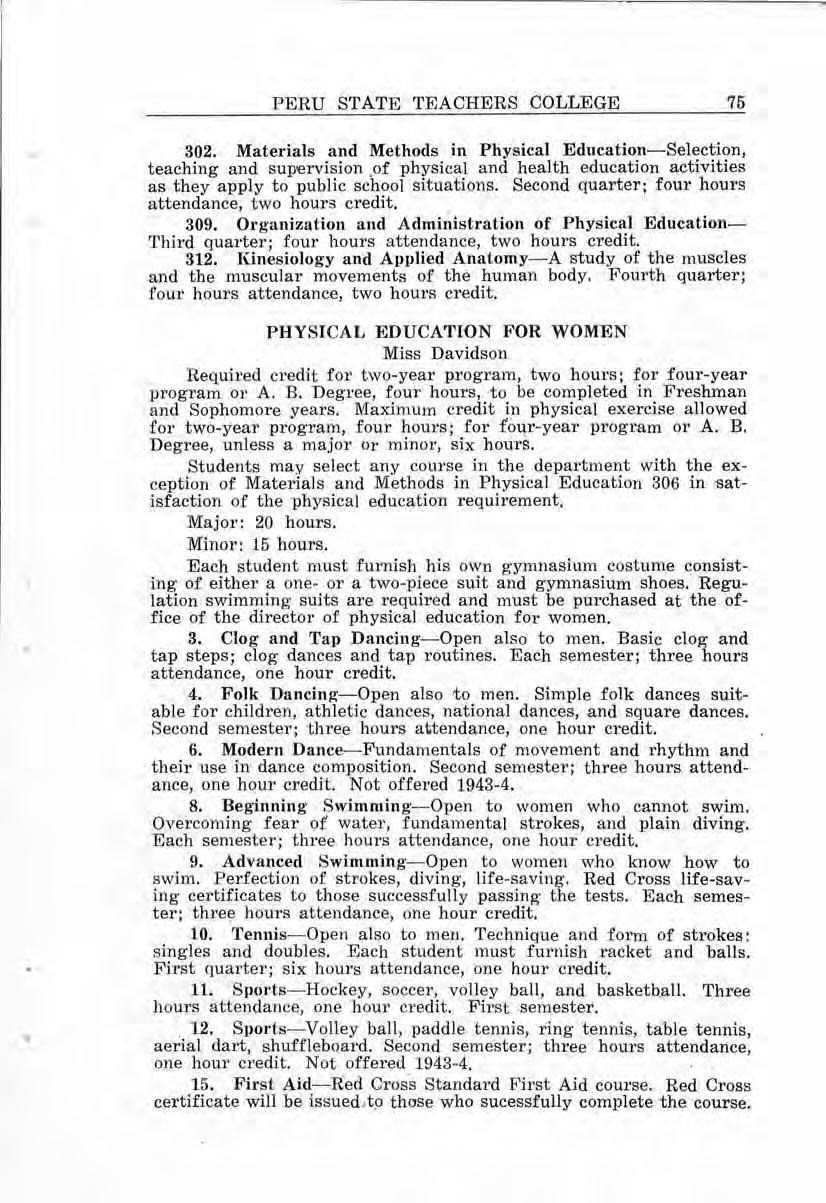
309. Organization and Administration of Physical EducationThird quarter; four hours attendance, two hours credit.
312. Kinesiology and Applied Anatomy-A study of the muscles and the muscular movements of the human body. Fourth quarter; four hours attendance, two hours credit.
Miss Davidson
Required credit for two-year program, two hours; for four-year program or A. B. Degree, ·four hours, -to be completed in Freshman and Sophomore years. Maximum credit in physical exercise allowed for two-year program, four hours; for f'ot\r-year program or A. B. Degree, unless a major or minor, six hours.
Students may select any course in the department with the exception of Materials and Methods in Physical Education 306 in ~atisfaction of the physical education requirement.
Major: 20 hours.
Minor: 15 hours.
Each student must furnish his own gymnasium costume consisting of either a one - or a two -piece suit and gymnasium shoes. Regulation swimming suits are required and must be purchased at the office of the director of physical . education for women. ·
3. Clog and Ta.p Dancing-Open also to men. Basic clog and tap steps; clog dances and tap routines. Each semester; three hours attendance, one hour credit.
4. Folk Dancing-Open also to men. Simple folk dances suitable for children, athletic dances., national dances, and square dances. Second semester; three hours a1.tendance, one hour credit.
6. Modern Dance- Fundamentals of movement and rhythm and their use in dance composition. Second semester; three hours attendance, one hour credit. Not offered 1943 -4.
8. Beginning Swimming-Open to women who cannot swim . Overcoming fear of water, fundamental strokes, and plain diving. Each semester; three hours attendance, one hour credit.
9. Advanced Swimming- Open to women who know how to swim. Perfection of strokes, diving, life -saving. Red Cross life-saving certificates to those successfully passing the tests. Each semester; three hours attendance , one hour credit.
10. Tennis- Open also to men . Technique and form of strokes: singles and doubles. Each student must furnish racket and balls . First quarter; six hours attendance, one hour credit.
11. Sports-:-Hockey, soccer, volley ball, and basketb.all. Three hours attendance , one hour credit. First semester
12. Sports- Volley ball , paddle tennis, ring tennis, table tennis, aerial dart, shuffleboard. Second semester; three hours attendance, one hour credit. Not offered 1943 -4. .
15. First Aid-Re d ·cross Standard First Aid course . Red Cross certificate will be issued ,t,o those who sucessfully complete the course.
Open to all college students. Second sem e ster; one hour attendance, one hour credit.
101. General Gymnastics-Primarily tor those who have had no physical education. Gymnastics, posture correction, games, stunts, relays, tumbling, p,yramid building, rhythm work. Second semester; • three hours attenda.nce, one hour creidt.
202. Advanced Sports-Hockey, soccer, field ball, , speed ball, basketball, volley ball. Three hours attendance, one hour credit. Not ;offered 1943-4.

204. Playground Supervision-Open also to men. Managing a playground; indoor and outdoor games for grades one to eight. Second semester; three hours attendance, one hour credit.
306. Materials and Methods in Physical Education- A combination of courses preyiously offered as Theory of Athletics 203 and Methods of Teaching Physical Education 306. Open .to women who are taking a major or minor in physical education. Prerequisite : courses 4 or 6, 8 or 9, 11 or 12, or the equivalent. Second semester; four hours attendance, four hours credit.
Mr. Winter
Mr. Sharpt Miss Strickland
Mrs. Winter
The sequence of courses for majors and minors must be approved by the head of the department. Those majorin g- in a particular field of science with the intention of teaching should minor in related sciences.
A major in Biology will consist of twenty-four hours of work in the department, including Biology 101 and 102, eight hours of Botany and eight hours of' Zoology. ·
A major in Botany will consist of Biology 101, 102, and sixteen additional hours in Botanv including 201 and 202.
A major in 'Zoology will consist of Biology 101, 102, and sixteen additional -hours of Zoology including 203 and 204,
A minor in Biology will consist of Biology 101, 102, and eight additional hours in the department, these to be chosen after consultation with the members of the department.
A minor in Botany will consist of Biology 101; 102; Botany 201 and 202. ·
A minor in Zoology will consist of Biology 101, 102; Zoology 203 and 204.
40. Man and His Parasites-A series of general lectures dealing with tape worms, liver flukes, and other parasites frequently found Jiving in the human body. Summer term only . Two hours attendance; one hour credit.
50. Floriculture-A series of lectures on the materials and ·methods of p1ractical flower growing. Two hours attendance; one hour credit. Summer term only:
-f On leave of a bsence for war ser,v~ce. •
101. General Riology-Consideration will be given to the structure and nature of protoplasm; cells and cell multiplication; heredity; and to a survey of plant·groups. and their economic importance. Work will be given in identification of the common flowers, trees, weeds, and ornamental plants. Each semester; three hours lecture, three hours laboratory, four hours credit.

102. General Biology-Continuation of 101. A survey of the animal kingdom including a consideration of animal structure and function, inter-relationships and economic importance of animals. One quarter will 'be given to the· study of the commoner types of human diseases caused by bacteria and animal parasites. Each semester; · three ·hours lecture, three hours laboratory, four hours credit .
105. Nature St udy- A general survey · of plants and animals. Their structure, habitats, and life histories will be studied both in the laboratory and in the field. Collection, identification, and preserva-' tiim of plant and animal forms will be emphasized, and practical experience in this phase of the work will be acquired by individual pro jects. Assigned readings and reports wil! supplement the class and laboratory work, Each semester; three hours lecture, three hours laboratory, four hours credit.
205. Physiology and Hygiene-An introduction to the study of the function and care of the human body in health and disease. Includes consideration of the effects of alcohol and of narcotics. Problems of communicable dis ease and community h ealth are given emphasis. Two hours lecture, two hours credit. Each semester,
304. Genetics and Eugenics-A study of the various theories of evo lution and their exponents; the principles of heredity and of genetics . Lectures, assigned readings, and class recitation. Second semester; four hours a ttendance, four hours credit.
406. · Science Methods-Prerequisite: Student must be taking a major or minor in one of the fields of science. A course in the principle s and practice . of science teaching. Four hours attendance, four hours credit. •
410. History and Literature of Biology- A reading · course in general biology and in the student's special field of concentration. Work will be done under the guidance qf the major professor through a series of weekly conferences. By arrangement only. Two or four hours credit.
504. Advanced Genetics and Evolution--'-The student will review in some detail the more recent phases of genetical investigation particularly in the field of cyto-genetics, and the relation of these findings to the theories of evolution. By permission only. Four hours credit.
201. General Botany-An introductory study of the life pro • cesses of flowering plants. Includes work on the gross and microscopic structure of plant organs. First semester; two hours lecture, six hours laboratory, four hours credit.
202, General Botany-An introductory study 0£ the structure, classification and comparative morphology of rep'I'esentative forms from the various plant· groups. Includes the identification of the trees and spring flowers , qf the vicinity. This course, in conjunction
with course 201, is the . equivalent of a basic one year course in Botany. Second semester; two hours lecture, six hours laboratory , four hours credit. ' .
309. Plant Physiology- A detailed classroom and laboratory study of photosynthesis, transpiration, respiration, absorption, metabolism, irritability, growth, reproduction and adaption . Prerequisite : twelve hours work in the department. Three hours lecture, four hours laboratory, four hours credit.
315. Plant Taxonomy - A survey of the plant groups with particular emphasis upon the flowering plants, their identification and classification . Designed to acquaint the student with the more frequent ·plants lof the state and to give proficiency in the identification of unfamiliar forms. Each semester; two hours lecture, six hours laboratory, four hours credit.

317. Plaint Ecology- A study of the climatic and soil factors with reference to their effect on the individual plant and upon the distribution of plants A general treatment of the relations of the plant to its environment. Prerequisite: General Botany 201. Four hours lecture, two hours laboratory, four hours credit.
318. Botanical Technic and Histology- Preparation of plant. ma.. terial for microscopic examination is combined with the study of plant tissues. Two hours lecture, six hours laboratory, four hours credit,
402. Fungi and Plant Diseases-An introduction to the morphology, physiology -and classification 0£ fungi, together with thdr culture and relation to disease, Two hours lecture, six hours laboratory, four hours credit.
510. History of Botany-A survey of the history of Botany and its place in the development of scientific thinking. Assigned readings and conferences. By permission only. Two or four hours credit.
550. Research-Assigned p'l.'oblems in the field in which the thesis is done. Will consist of laboratory work, study of the literature, and of conferences with the instryctor. By permission only. Two or four hours credit.
561. Advanced Morphology and Taxonomy of the Angiospe•.ms - a detailed consideration of the vegetative and reproductive structures of selected representatives of the flowering plants and of the morphologic basi s for the systematics of the group. By permission only. Two or four hours credit.
203. General Zoology-A study of the structure a nd development of the animals belonging to the invertebrate groups, together with a consideration of their habits, distribution, and relationships. First semester. Two hours lecture, six hours laboratory, four hours credit.
204. General Zoology-Continuation of course 203. A detailed study of the anatomy, development, and phylogeny of the vertebrates. Second semester; two hours lecture, six hours laboratory, four hours credit. ·
307. Advanced Human Physiology-A study of anatomy, physiology and hygiene of the human body, .with special refereI1ce to organ systems, and microscopic wo'rk on the human tissues. Four hours l~cture, four hours laboratory, four houl!s credit.
321. Parasitology-A study of the morphology and economic imp•ortance of the parasites affecting man and his domesticated animals. Four or eight hours attendance, two or four hours credit.
414. Animal Ecology-A study of the world distribution of animals together with factors causing ·and limiting their distribution. Prerequisite : Courses 101, 203, and 204. Four hours attendance, four hours credit.
419. Entomology-A study of the morphology and distribution ' of insects and of their economic importance. Methods of collection and identification will be emphasized through field work . Four or eight hours attendance, two or four hours credit.
A Physical Science major will include twelve hours of Chemistry and eight hours of Physics, or twelve hours of Physic and eight hours of Chemistry and one additional four -hour course in the physical sciences.
A Physical Science minor will include a total of sixteen hours .which shall be composed· of two of the following three groups: Chemistry l'O'l and 102; Physics 20'1 and 202; Physical Science 111 and 112.
A Chemistry major will include twenty-four hours of Chemistry.
A Chemistry minor will include sixteen hours of Chemistry.
A Physics minor will include sixteen hours of Physics.
15. Science of · Sound-Lectures, recitations, and dass demonstrations concerning the behavior of sound with the emphasis on the relation between the physics of sound and music. A non-technical course. Summer term only . Two hours attendance; one hour credit.
16. Photography-A study of the lenses of cameras, , theory and practice of developing and printing, and the making of lantern slides, A practical and non-technfoal course designed to aid the teacher or amateur photographer. Summer term only. Two hours attendance; one hour credit. ·
111. Introduction to General Physical Science- A non-technical course designed to give a survey of the physical sciences. Three hours lecture, three hours laboratory, four hours credit.
112. Introduction to General Physical Science- Physical Science
111 continued. Second semester and summer school. Three hours lecture, three hours laboratory, four hours credit.
101. General Chemistry-Non-metals and their compounds. First semester and summer school; three hours lecture, four hours laboratory, four hours credit.

102. General Chemistry- Prerequisite: Chemistry lOL Metallic elements and their compounds. Introduction to qualitative analysis. Second semester and summer term; three hours lecture, four hours laboratory, four hours _ credit.
205. Principles of Analytical Chemistry-Prerequisite: Chemistry 102. Laboratory worR: -devoted to qualitative analysis. First semester; two hours lecture, ~i?C hours laboratory, four hours credit.
206; Principles of Analytical Chemistry-Pr~requisite: Chemistry 205 continued. Laboratory work devoted to quantitative analysis Second semester; two hours lecture, six hours laboratory, four hours credit. ·

206a . . Principles of Analytical Chemistry- Prerequisite: Chemistry 20•5. This course is designed primarily for home economics students. The lectures are the same as for course 206. The laboratory work will be devoted to food chemistry. Second semester; two hours lecture, six hours laboratory, four hours credit.
303. Elementary Organic Chemistry- Prerequisite: Chemistry 102. Chemistry of compounds of the aliphatic and aromatic serie s . First semester and summer school; three hours lecture, four hours laboratory, four hours credit.
303a. Elementary Organic Chemistry- Prerequisite: Chemistry 102. This course is designed for home economics students. Chemistry of compounds of the aliphatic and aroma.tic series, with special emphasis on applications to home economics. Three- hours lecture, four hours laboratory, , four hours credit.
304. Organic Chemistry- Prerequisite: Chemistry 303. Theory of distillation, a more intensive study of' the aromatic series, and an introduction to advanced topics in organic chemistry. Second semester; three hours lecture, four hours la,boratory, four hours credit. Students may, by permission of the head of the department only, take extra laboratory work in the synthesis of organic comp'Ounds for two hours extra credit.
308. Atomic Structure- An introduction to modern theorie s of atomic structure. By permission only.. Two hours lecture, two hours credit.
409. Pl)ysical Chemistry- Propertie s of gas es, liquids and s olids; solutions; thermochemistry; and equilibrium. By permission on. ly. Three hours lecture, three hours credit ..
410. Phyiscal Chemistry- Prerequisite: Chemistry 409. Continuation of ' Chemistry 4 09. Phase nfle, reaction velocity, electro ~ chemistry, and photochemistry .Three hours lecture, three hours credit.
501. Advanced Organic Laboratory - A study of reactions of compounds of theoretical and industrial importance. By permission , only. One to four hours credit.
502. Qualitative Organic Analysis- Identifica.tion of pure organic compounds and. mdxtures. By permission only. Two or four hours credit.
550. Organic Research- By permission only. One to four hours credit.
201. General Physics- Mechanids, heat and sound. First semester and summer school; three hours lecture, four hours laboratory, four hours credit;
202. General Physics~Prerequisite: Physics 201. Magnetism, electricity, and light. Secon'<l· semester and summer school; three hours lecture, four hours labor1tt?ry, £our hours credit.
302. Analytical Mechanics- Prerequisites: Physics 202 and Mathematics 309. Emphasis on the fm;idamental physical principles of the subject with the aid of formal development and problems. Four hours lecture, four hours credit.
303. Electricity and Magnetism- Prerequisite: Physics 202 and Mathematics 309. Theory and practice of electrical measurements; electrical standards; elementary theory of magnetism and electromagnetism; electromagneti c induction. First sem ester; three hours lecture, four hours laboratory, four hours credit.
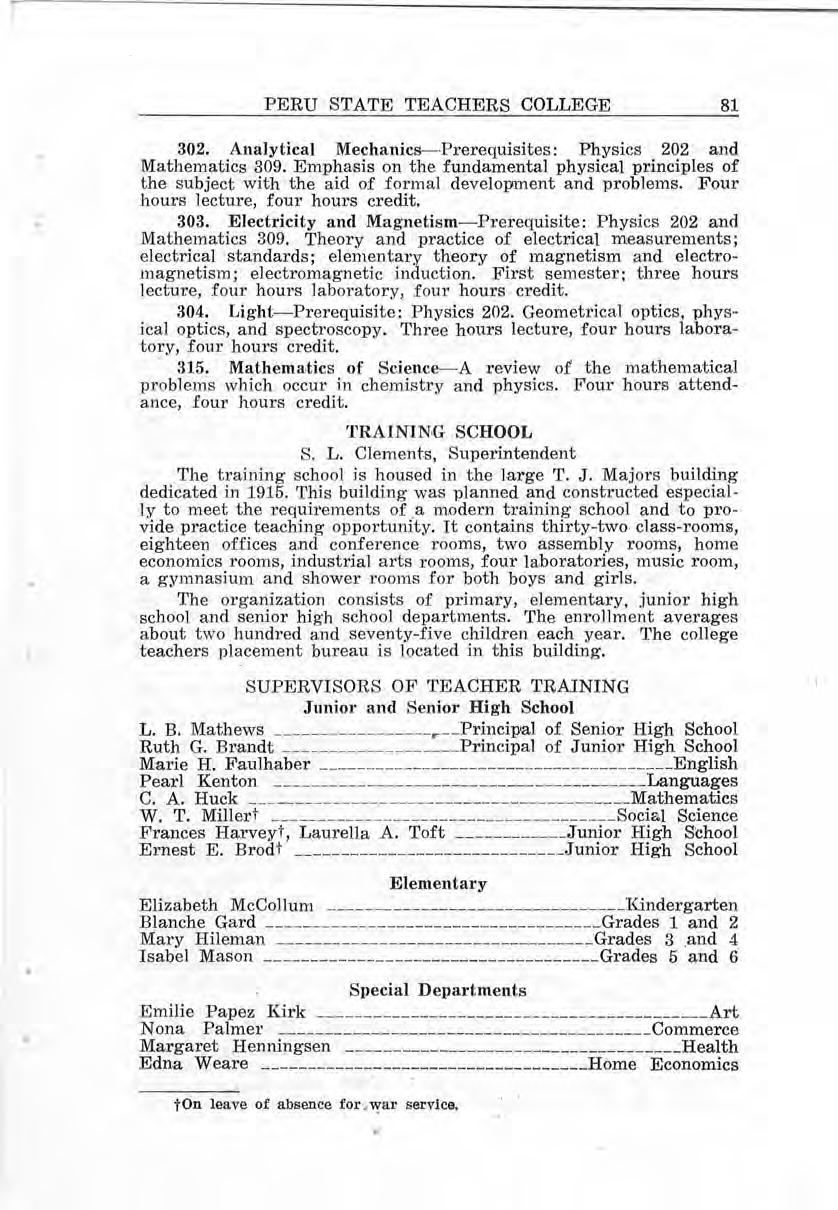
304. Light- Prerequisite: Physics 202. Geometrical optics, phy sical optics, and spectroscopy. Thre e hours lecture, four hours laboratory, four hours credit.
·
315. Mathema,tics of Science- A review of the mathematical p ro blem s which occur in che mistr y and physic s Four hours attendance, four hours credit.
The training s chool is housed in th e large T. J. Majors building dedicated in 1915. This building was planned and constructed especially to meet the requirements of .a modern training school and to provide practice teaching opportunity. It contains thirty-two class -rooms, eighteen offices and conference rooms, two assembly rooms, home economics rooms, industrial arts rooms , four laboratories, music room, a gymnas ium and shower rooms for both boys and girls.
The org anization consists of primary, elementary, junior high school and senior high school departments. The enrollment averages a bout two hundred and seventy -fiv e children each y e ar. The college teachers placement bureau is located in this building.
S UPERVISORS OF TEACHER TRAINING
Junio1· and Senior High School
L. B. Mathews __________ .:. ______, __ Principia! of Senior High School
Ruth G. Brandt _________ Principal of Junior High School
Marie H. Faulhaber ____ English
Pearl Kenton __ Languages
C. A. Huck __ Mathematics
· W . T. Millert _ Socfa.J Science
Frances Harvey t , Laurella A. Toft _ Junior High School
Ernest E. Brodt ___________ Junior High School
Elementary
Elizabeth McCollum __ Kindergarten
Blanche Gard _____ Grades 1 and 2
Mary Hileman _ Grades 3 and 4
Isabel Mason __ Grades 5 and 6
Emilie Papez Kirk __ Art
Nona Palmer - - - ~ - - - - - - - - Commerce
Margaret Hennip.gsen __ Health
Edna Weare ______ Home Economics
tOn leave of absence for , "?ar service, ,.
Stephen 0. Gaines __ Industrial Arts
R. T. Benford ______ Music (Public School)
V. H. Jindra ----------~
(Instrumental)
Practice teaching is a requirement both of the State Normal Board and the American Association of Teachers Colleges. Consequently, it is impossible to accept substitutions for the required pracl;ice teaching. Teaching assignments are secured through the Superinte ndent of the Training School.
210. Teaching·-Prerequisites are: ( 1) Introduction to Education, (2) Educational Psychology, (3) Observation and Methods, ( 4) Classroom Management . Four semester hours are required for completion of' the two-year course. Each quarter. Five hours attendance, two hours credit.
411 Teaching-Four hours credit required of all senior high school teachers for the A. B. Degree Prerequisites same as for Teaching 210 with the addition of at least a minor in subjects t!l.ught. Two hours of this must be earned in the senior year; two may be earned in the junior year. Each q1;1arter. Five hours attendance, two hours credit.
411a. Teaching-Two hours required (in addition · to four hours of teaching 210) of all Junior High and Elementary teachers who qualify for th e Degree. Must be taken in the senior year. Each 9uarter. Five hours attendance, two hours credit.
411b. Teaching-Elective for senior high teachers who want to do two hours additional teaching. The number who may elect this course is limited; superior work is expected. The number who may el ect this course will depend upon the number registered for th e other teaching courses.
Regardless of the amount of superior teaching one has observed, or how much he has read or been told about what constitutes correct t e aching, there is no assurance he will be . a good teacher until he actually takes charge of a class, assume~ full ·responsibility of the activities, and demonstrates ability to attain desirable outcomes. The Training School provides opportunity for this experience through its co urses in practice teaching. Opportunity is provided in all departments from kindergarten through the high school to get this fundame ntal training under expert supervision. In these courses the college student has opportunity to test his theories of teaching, learn new ones, and building a workable philosophy of teaching for himself'. Each student teacher is put in charge of a class and teaches a minimum of forty-five clock hours (five hours a week for a quarter of nine weeks ) to earn two hours credit. At least two hours of planning, conferences , and other preparation is expected for each day's teaching Students are advised to carry a light college load during the quarters they are teaching. Perhaps no other course requires so much careful preparation or provides so great an opportunity to prove one's ability to teach.
1. A general scholastic average of "C" (a number of honor points equal to the number of hours credit) must be earned in all collegiate work to qua.litfy for practice teaching. Junior and senior high teachers should also have secureg an a.verage mark of "B" fa the spe-
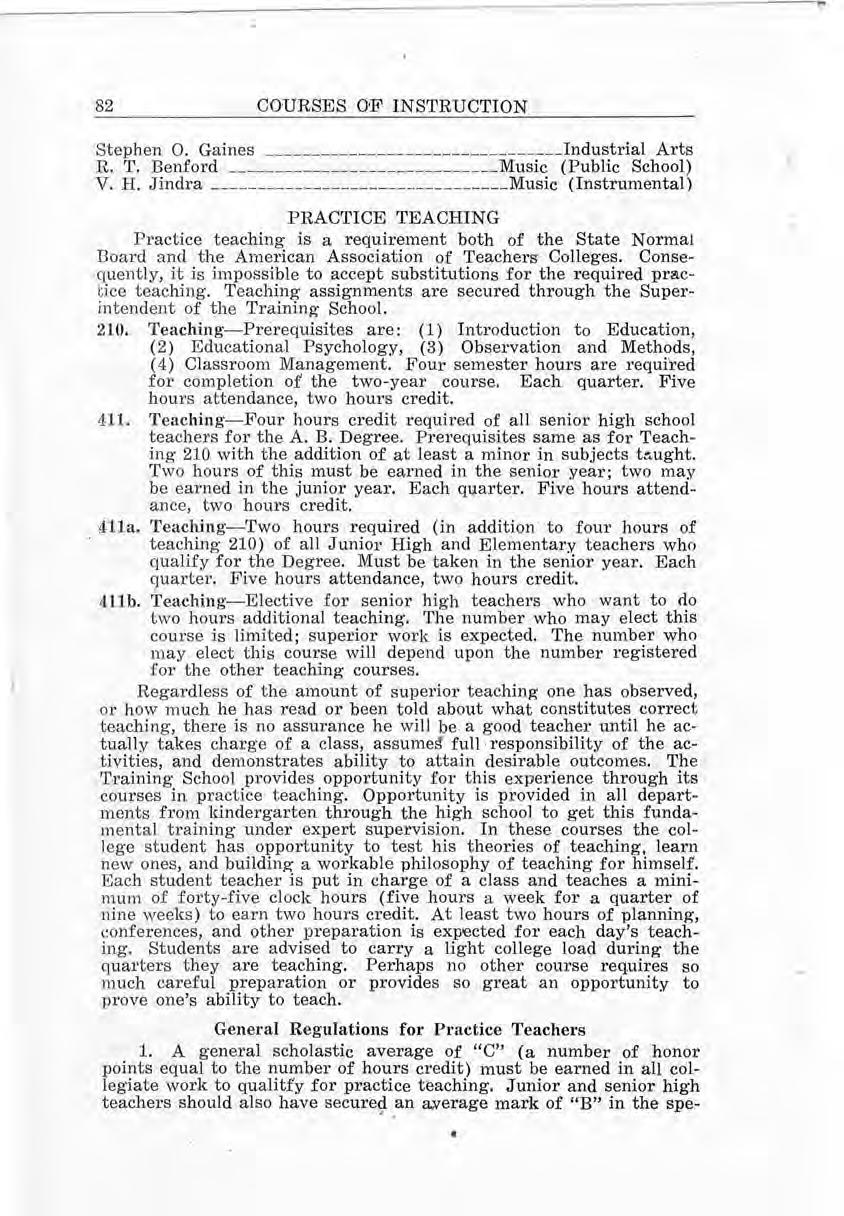
cial subjects they plan to teach. Each candidate must have the ability to speak and write the Egnlish language corr.ectly and effectively.
2. A student making a mark ·below "C" in teaching may not repeat the course the following quarter. It is recommended that all who plan to complete the four -year course, without getting the twoyear Normal Diploma, defer their teaching to the junior and senior '
3. Before receiving a passing mark in teaching, the s tudent should demonstrate to his supervisor:
a. That he h as a working knowledge of the principles of psycho logy, the laws of learning, and will concern himself with the desirable habits, a.ttitudes and ideals of individual pupils.
b. That he knows the su bject matter he proposes to present.
c. That he can set up worth -while objectives, independently plan his teaching procedure and effectively direct classroom activitie s.
d. That his moral conduct and personal habits measure up to the -high standard expected of public school teachers.
e. That he will do more than the minimum amount of work required and demonstra.te ability in conducting extra classroom activities.
f. That he is intellectually and physically able to do the work of a public school teacher.
g. That he will co - operate with his supervisors, demonstrate professional interest in teaching, and be able to indicate wherein his practice teaching has accomplished desirable objectives in the lives of the children he has taught.
4. A maximum of two hours of credit in Practice Teaching (below ninth grade only) may be earend in one summer term by teach_ ing two consecutive hours each day that the training school is in ses-sion. Students who expect to earn teaching credit during a summer term should make application in writing to the Superintendent of the Training School several weeks before registration, as the number who can be accommodated in any one summer is limited

'
The extension service is planned to direct - the ·studies of adults who are unable to attend clas ses in the college. The aim of the department is to provide to the greatest degree possible, for the student unable to a.ttend college, the privileges of academic and teacher training. Students unabl e to begin residence work, those whose college educ a tion has been interrupte d, and those wishing to renew certific a tes will find correspond enc e work a sati sfactory substitute for co ll ege attendance.

Peru is fortunate i n h a ving available a number of qualifie d instructors wh o are not on the r eg ular faculty, but who form the nucl eus of th e extension faculty. Th ey give their undi vide d t eaching efforts to the corres pondence courses.
All communications should be a ddressed to "Director of Extens ion," P er u State Teachers College , P eru, Nebraska.
1. Admission-Correspondence study is open to those who meet the college entrance requirements. Entrance credits must be filed with the registrar before work is begun.
2. Registration-(a) Anyone may register for subjects numbered below 200. Those having some college work may· register for courses below 300. Only college juniors and seniors should register for 300 or 400 courses. (b) Register for only one course at a time. All fees must b e paid before books and lessons will be sent. On completion of one course, all books and materials must be returned before books and materials for a second course will be sent, or before a grade will be reported to the registrar's office.
3. Time-Unless otherwise stated, each course must be completed within one year from the date of registration. A student who
t Access to mi croscope necessa ry Material fee, 75c.
*For elementary teachers. Credit cannot be counted tow ard a degree If student is preparing for seconda ry · work
:j:Registrations fo r this co urs e a re accepted only between loeptember 15 and March 1. All work must be compl~ted by the following June
does not complete his work in one year is dropP'ed, and he must reregister in order to continue the course.
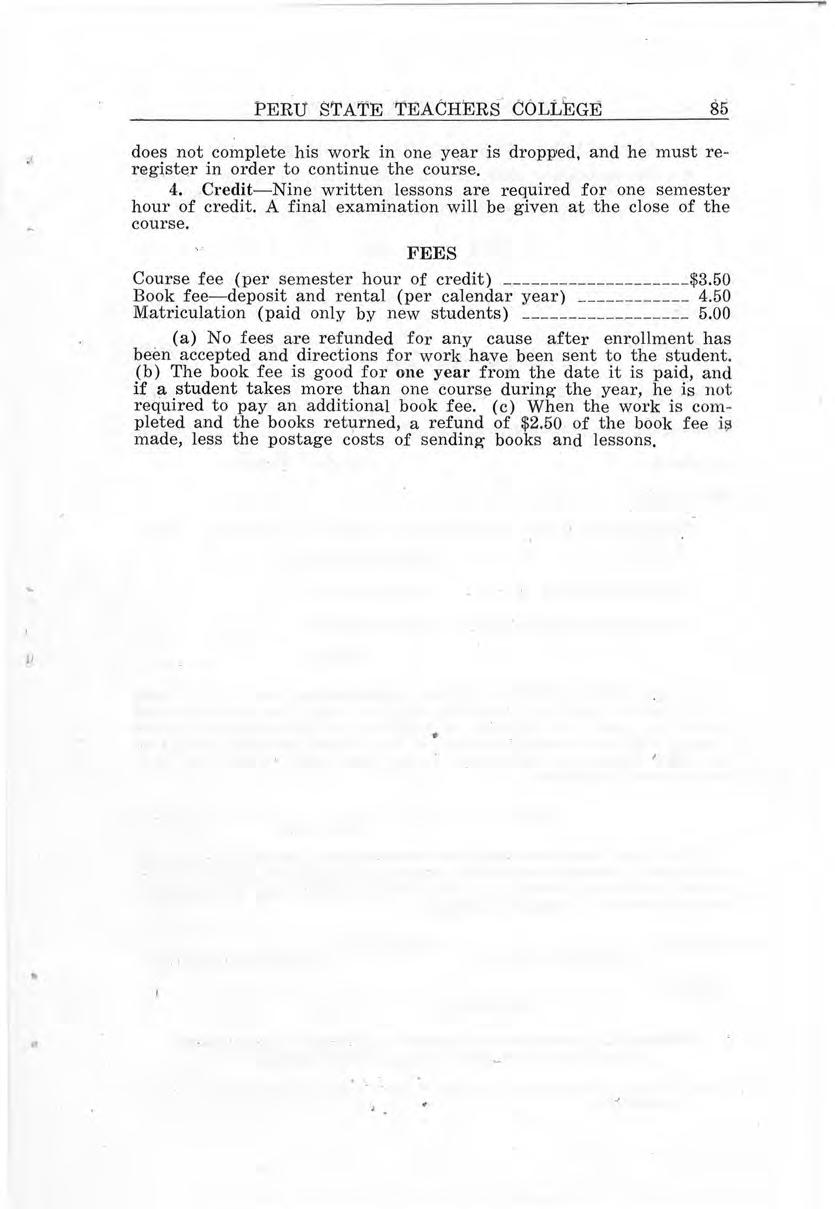
4. Credit-Nine written lessons are required for one semester hour of credit. A final examination will be given at the close of the course.
(a) No fees are refunded for any cause after enrollment has been accepted and directions for work have been sent to the student.
(b) The book fee is good for one year from the date it is paid, and if a student takes more than one course during the year, he is not required to pay an additional book fee. (c) When the work is completed and the books returned, a refund of $2.50 of the book fee i~ made, less the postage costs of sending books and lessons.
No correspondence study can be taken while in resident attendance nor during Christmas or other vacations during the year.
(Ruling of the North Central Association) '
Date - - - ~ -____ _
Name Address - - -Graduate of_ __________________________________ High School. Date (Name of High School) of matriculation at Peru ____________________________________ , Total number College semeste:r; hrs., earned _______________ .:_ _, Course requested ____ , Catalog Number _________ _
Hrs. Credit_ ___ _'_ _:______________________ _
Enclosed find money order to cover fees, etc., mentioned below: $5.00 Matriculation $----- . __

$3.50 per credit hour
$4.50 book rental deposit Course Fee Book Deposit
TOTAL
I make this application with the understanding that all the· work in this course be done in absentia, and that it is to be completed and handed in, ready for approval or rejecJ ion by the instructor before I .again enter as a resident student at Peru State Teachers College or any other College or University. I have done none of thilil work during resident attendance.
Signed ____________________ _
· ( Ap plicant)
This work is allowed with the understanding that all the work is to be done in absentia and fully completed ready for a,pproval or rejection before re-entering any school. This student has done none of this work while a resident student.
Approved ___ Approved ___________ _
(Exten s ion Director) (Head of Department)
Signed _______________ _ (Instructor)
Address all correspondence direct to Extension Department, Peru State Teachers College, Peru, Nebraska.
Note-All written lessons mus t be sent first class as a requirement of Postal Authorities.
Ba l.e t·
S105 'l'yl er
A10 4 Martin
A20 4 Konig
A303 Bradfor<l
S201 Clayb urn
A.10:l Brown
A20 2 Heynold s
' l'l 04 , \\' en re
~ h op Larson
S h op Larnon
S h op La r s on-
S h op
S h op L arso n hours )
Shop Shop
A30 4 l'ool
Ml08 Benfo t•d
MllO .Timlt·a
S204 S ITi Ckl a nd
S304 Winter
L305 Diddel
L 3 01 Ki,·k
L305 Diddel
A 30;, Palmer
L301 Kirk
J\301
A10 '1 T ea r
S105 Tvler
AlOl ~ta:xwe ll
A102 Ma r ti n
A30 3 Bradford
J\204 Konig
S 2 01 C layb urn
A20 2 Heynold s
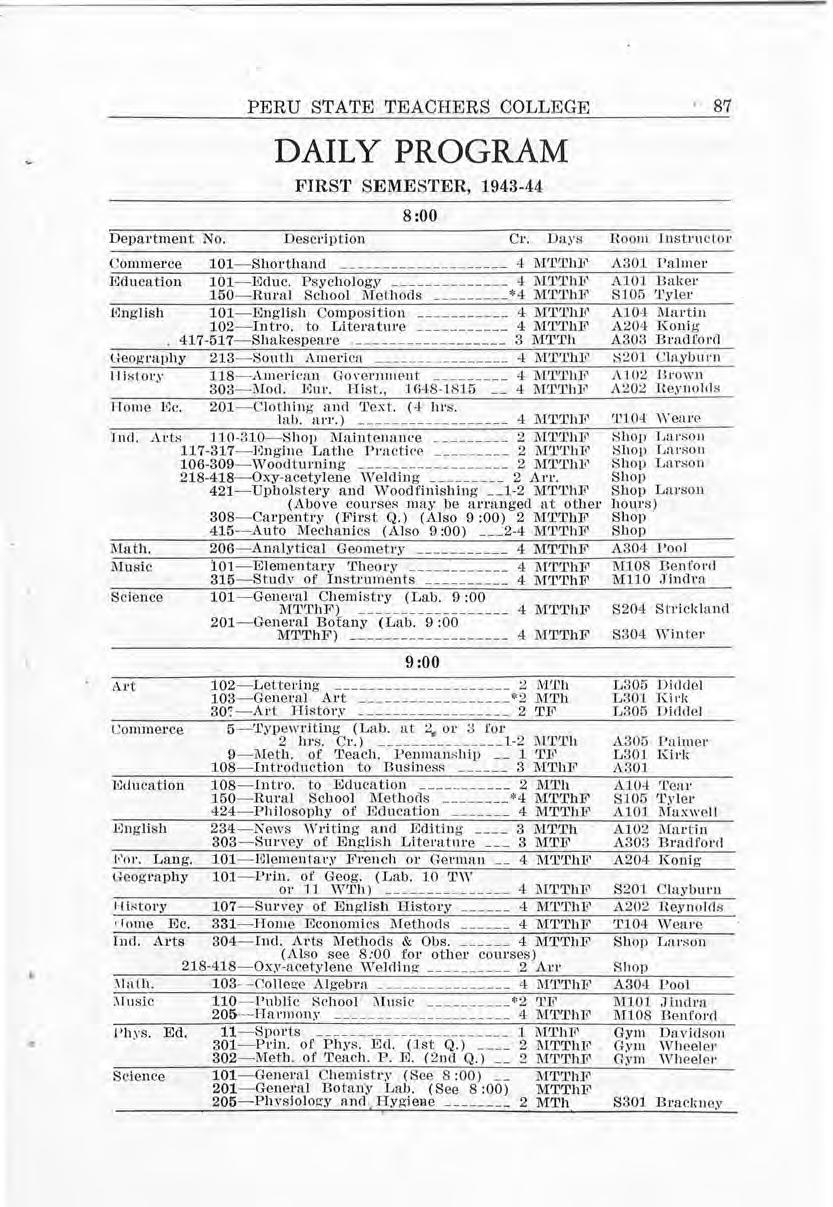
'l'l 04 Wea r e
Shop Lars on
S ltop
A30 4 Pool
1\1101 .Jindra
1\1108 Benford
Gym David s on
Gv m Wheel e r
G~•m \Vheel e t·
S301 Brackney
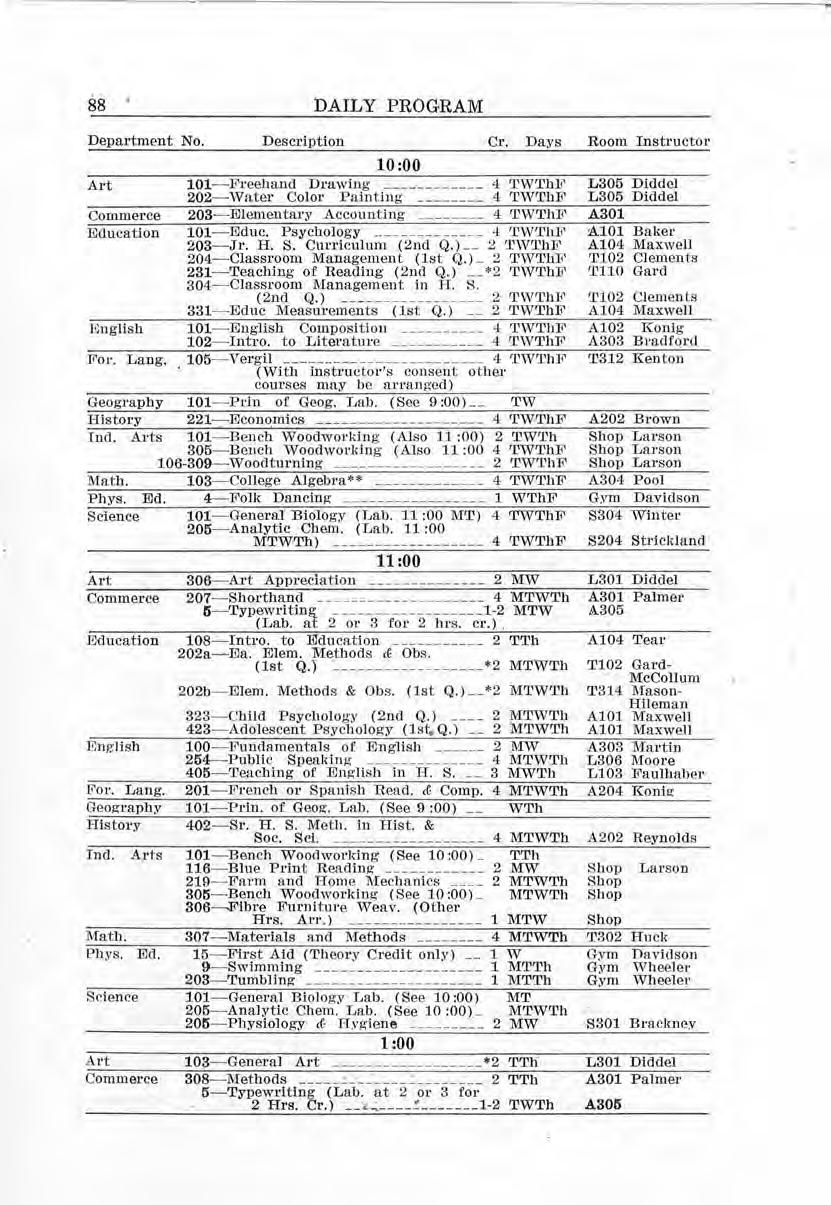


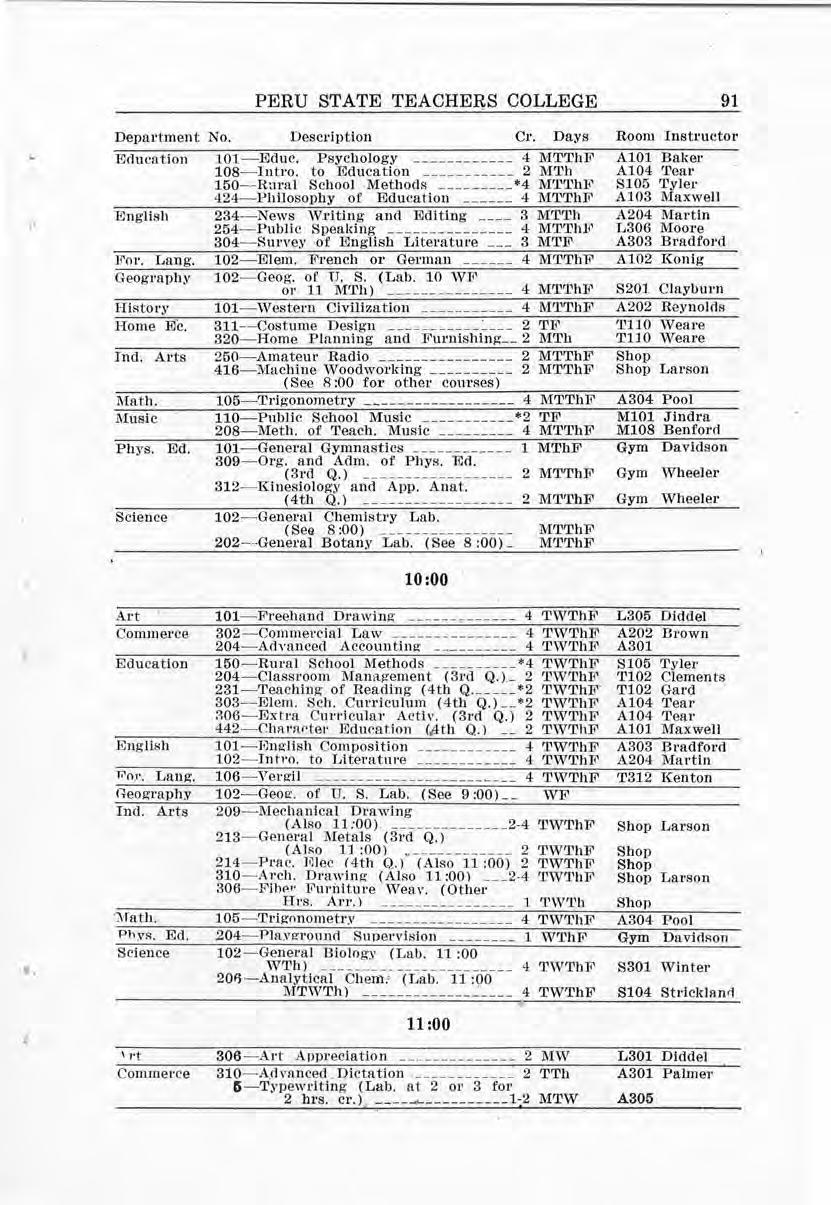
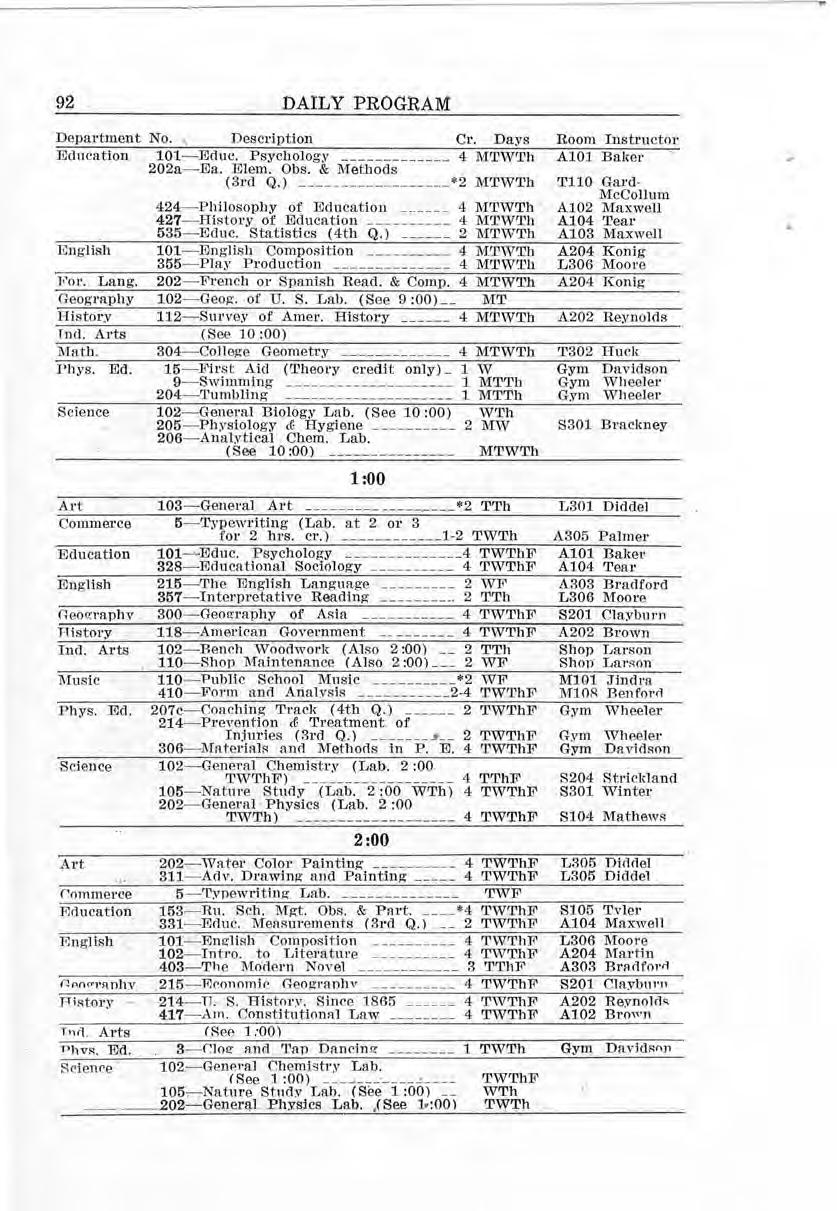
*Cr!)dit allowed only on elemE!nta1:y 'curricula
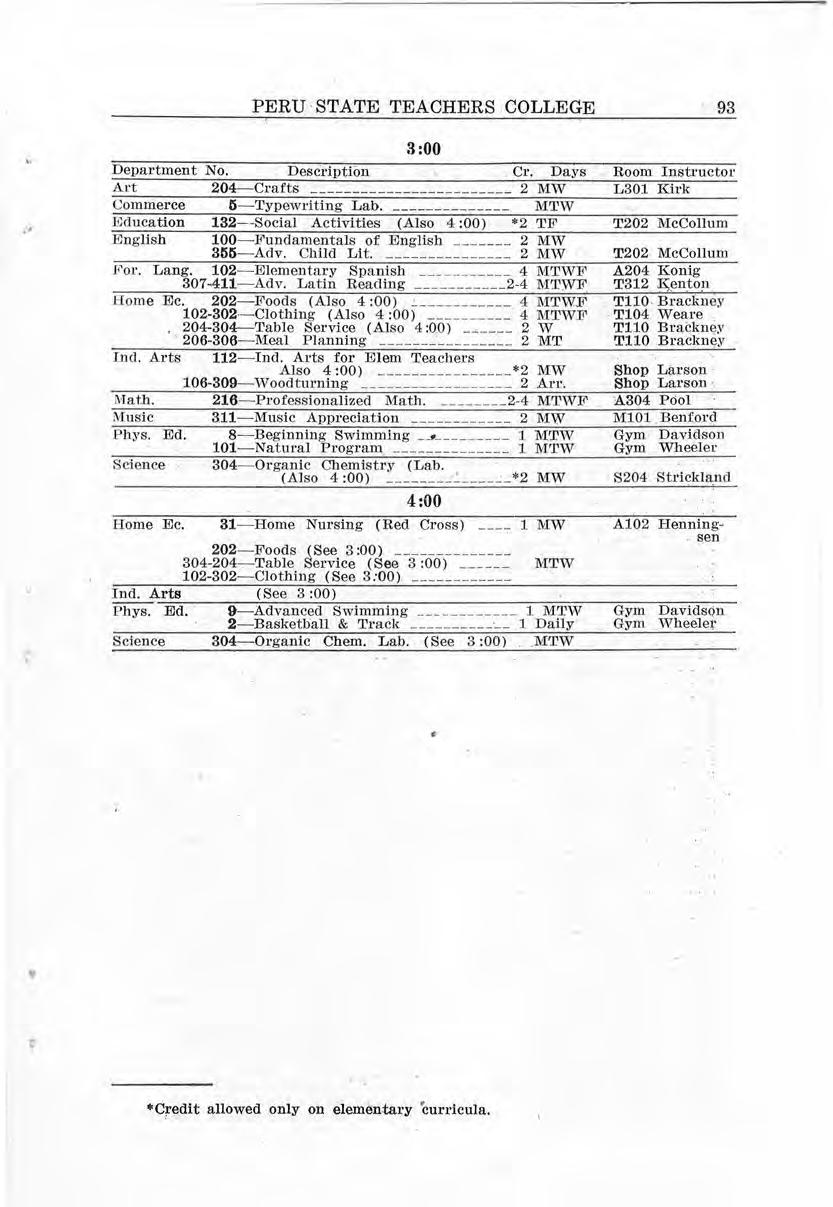
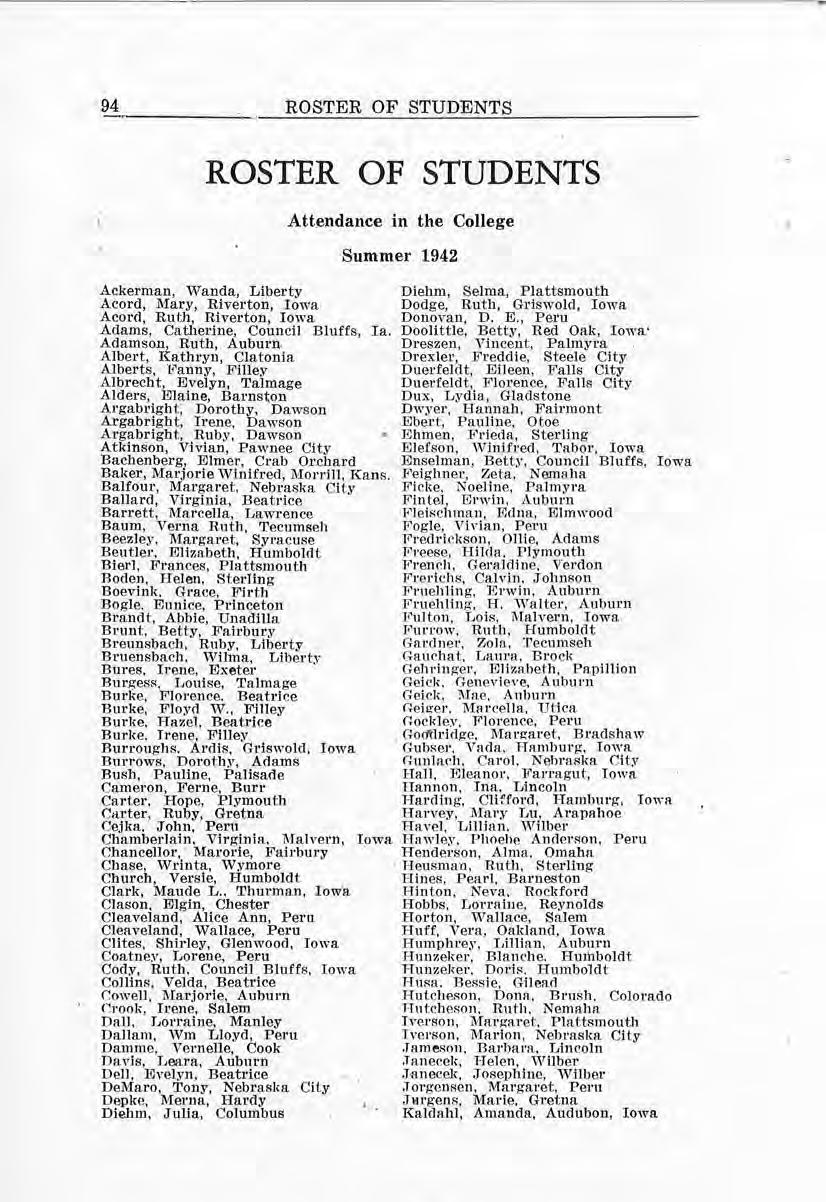
Summer 1942
Ackerman, Wanda, Liberty
Acord, Mary, Riverton, Iowa
Acord, Ruth, Riverton, Iowa
Adams , Catherine, Council Bluffs, ta.
Adamson Ruth, Auburn
Albert, I{athryn, Clatonia
Alberts, l ~a nny, Filley
Albrecht, Evelyn , Talmage
Alders, E laine, Barnston
Argabright; Dorothy , D awson
Argabright, Irene, Dawson
Argabright, Ruby, Dawson
Atkin s on, Vivian , Pawnee City
Bachenberg, Elmer, Crab Or.chard
Dfehm, Selma, Plattsmouth
Dodg e, Ruth, Griswold, Iowa
Dono,ran, D. E. 1 Peru
Doolittle, Betty, Red Oak , Iowa ·
Dreszen , Vincent, Palmyra
Drexler, Freddie, Steele City
Duerfeldt, Eileen, Falls City
Duerfeldt, F lorence, Falls City
Dux, Lydia , Gladstone
Dwyer, Hannah , Fairmont
E bert, Pauline, Otoe
• E hm en , Frieda, Sterling
Baker, M;ujorie Winifred, Morrill , Kans.
Balfour , Margaret, Nebraska City
Ballard, Virginia , Beatrice
Barrett , Marcella, Lawrence
Baum, Verna Ruth. Tecumseh
Beezley , Margaret, Syracuse
Beutler , Elizabeth, Humboldt
Bierl, Frances, Plattsmouth
Roden , Helen, Sterling
Boevink , Grace. Firth
Bogle. Eunice, Princeton
Bran dt , Abbie , Unadilla
Brunt , Betty, Fairbury ,
Breunsbach, Ruby, Liberty
Bruensbach , Wilma, LibertJ•
Bures , Irene, Exeter
Buri;ess . Louise, Talmage
Burke, Florence. Beatrice
Burke, Floyd W., Filley
Burke, Hazel, Beatrice
Burke , Irene, Filley
Burroughs. Ardis, Griswold , Iowa
Burrows, Dorothv , Adams
Bush, Pauline, Palisade
Cameron, Ferne, Burr
Carter, Hope, Plymouth
Carter , Ruby, Gretna
Cejka, J"ohn , Peru
Chamberlain , Virginia. Mal vem, Iowa
Chancellor, · Marorie, Fairbury
· Chase, Wrinta, ,vymore
Church, Versie, Humboldt
Clark, Maude L Thurman , Iowa
Clason, Elgin, Chester
Cleaveland, Alice Ann, Peru
Cleaveland, Wallace, Peru
Clites, Shirley, Glenwood, Iowa
Coatnev, Lorene, Peru
"Cody , Ruth , Council Bluffs, Iowa
Collins, Velda, Beatrice
(;owell, Marjorie, Auburn
Crook, Irene, Salem
Dall , Lorraine, Manley
Dallam, ,vm Lloyd, Pern
Damme , Vernelle, Cook
Davis, Leara, Auburn
Dell, Evelyn , Beatrice
DeMaro, Tony, Nebraska City
Depke, Merna, Hardy
Diehm, J"ulia, Columbus
E lefson , " ' inifred , Tabor , Iowa
E nselman , Be'tty , Council Bluffs , Iowa
Feighner, Zeta , Nemaha
F i cke, Noeline , Palmyra
FinteJ 1 E rwin , Auburn
F l e isch ma n, Edna, Elmwood
Fog le , Vivian 1 Peru
Fredrickson ,. Ollie, Adams
Freese , Hilda, Plymouth
French , Geraldine, Verdon
F r erichs , Cal vjn, ;r olmson
Fruehling, Erwin , Auburn
Fruehling , H. " ' alte r , Auburn
Fulton , Lois , 01:a lvern , Iow a .
Furrow , Ruth , Humboldt
Gardner , Zola , ·.recumseh
Gauchaf, Laura , Brock
Gehrin ger , Elizabeth, Papillion
Geick, Genevieve, Auburn
Geick. Mae, Auburn
<::eie:er. i\farce11a, Utica
<::ocklev, Florence, Peru
Goo'dr idge, Mare:aret, Bradshaw
· Gubser. vada, Hamburg, Iowa
r;unlach. Carol. Nebraska City
Hall, Eleanor , Farragut , Iowa
Hannon, Ina , Lincoln
Harding, Clifford , Hamburg, Iowa
Harvey, Mary Lu , Arapahoe
Havel, Lillian. Wilber
Hawley, Phoebe Anderson , Peru
Henderso n , Al ma, Omaha
·
Heusman, Ruth , Sterling
Hines , Pearl, Barneston
H inton , Neva, Rockford
Hobbs, Lorraine, Reynolds
Horton, vVall ace, Salem
Huff, Vera , Oakland, Iowa
Humphre y, Lillian, Auburn
Hunzeker , Blanche. Humboldt
Hunzeker. Doris , Humboldt
Husa , Bessie, Gilead
Hutcheson, Dona, Brush. Colorado
Hutcheson. Ruth, Nemaha
Iverson , Marp:aret, P l attsmouth
Ive rson , Marion, Nebraska City
Jameson , Barbara. , Lincoln
.T a nece k, Helen, vVilber
J •a necek, J"osephine, ,vnber
,Jorge nsen , Margaret. Peru
J"1-1rgen s, Marie, Gretna
Kaldahl , Amanda, Audubon , Iowa
"
Kan1m e re r, Alic e, Falls City
Peebles, Rita , 'Griswold, Iowa h
Kal'r, Marian, Oma a
K eithl ey, Bessie, P a wnee Ci ty
K e nne d y, Ruth , P e ru
Kenning, Mildred Endicott
King, Betty , Waterloo
King,, E lle n 11~.• Tabqr, Iowa
Klasek, Georgia , Wes tern
Kl e in, Agnes, Steinauer
Knight, Frances, F a ll s City
Kote rn, Ro se, Bee
Kramb ec k, Al'line, Fort Calhoun
Kramb ec k, June, Fort Calhoun
Kraybill, Ada, P e ru
Kr e u zb e rg, Joa n , Wilbel'
Kru eger , Joy, Auburn
Krue gel', Nina , Od e ll
Kucern, Claire, Prague
Ku ce ra , Otto, Pra g ue
Kuhlm a nn , Clara, Chester
Kuh lm ann. Jun e, Cheste r
La rkin s, Ilo, Chester
Penney, Ella, Avoca
I'es hek Nellie, Unadilla
Pfi ster : Anna, Stwinauer
Pilch E v-a, A uburn
Pinct~er t, Marie, Tecumseh
Plvonka Irene, WIiber
Powers ' H a rriette, Palmyra
Prathe1: Charlotte, Falls City
Prine, Mildred Marjorie, Burcha1'.d
Reagan, Janet, Humboldt
Re ed Leona , Auburn
Renz , Faith , Diller
Rethmei er Roma Jean, Crete
R etz Ma>l ine , Lewis, Iowa
Rinn'e Bernice, Beatri ce
R oberts Iren e, P a pillion
Roberts: Keith, Tec umseh
Rodgers , Evelyn, Peru
Rogers, Charles, Peru
Roi:rers, Helen , Peru
Rothm ill er, Melvin . Omah a
Rottman, Nor ma Jean , Otoe
T,11rson , L e onore. Peru Russell , Rita, Peru • ,
T,eonal'd , Dorothy, Bl a nclrn.rd , Iowa Russell ,Vilma. , Burchard
J ,iene1na nn. Don a ld. Papillion
J ,in cnln, Sarah , P acific Jun ctio n, Ia.
Sa fr a n e k , ._ Lorrain e. Wilber
Sai,dfort. M. Lucile, Humboldt
T,i senby , Ooal , Jansen Schacht , Leta, Cook
LoenniJ?. llfarJ?a r e t Humbo ld t Schacht , Ros inn, Talmage
T,ub y, Ruth Aurora Schaefer. Blanche, Talmage
J,urk, J, n ur a. H ll r vard Scl1a e fer , Marcell a Talmage
L11t, F:v el v n , Humbol<'lt S cha non. Bess ie . Shelton
McAlexa.wler. Roh e rt Beaconsfield , Ia Sc lt a non. Jenni e. Shelton
Me0.ormi ck Rut h. Syrncuse Schiermeyer, Ad eline, Beatrice
McFa<lclen , Ge n e vi eve, Atl antic, Iowa ~choenbohm. H a ze l. Cumberl a 1?d, Iowa
McF'ndclen , Opal. Atlanti c. Iowa Schom e rus Irene. Nebras ka City
McKim .Tenni e. Brownvtll e Schre iner Gilbe r t, Unadilla
Wnc ombe r . .T. Harol,l, B eatn ce flchuesslel', 11.larJ?aret, Fort Crook
Mnsn n Mi l rlred. Auburn Scott. Beh·a P11wnee City
~-rs tH1 ews. A nna lWR.rl?ar e t Malve rn , Ia seerrel. Anna , Unad illlt
'-' s tth ews. 0,.a.ce. Halve rn , Town
SP.id le. .Tulia. Jnl es bnrJ? . Colorado
Mn tth ews. Helen. Malvern Jnwn Sh ea R e rth n. :lfoorh ea<l. Iowa ;\ ,f n.yhen·:v. :l\fs:1 rY. r:1 e nwoorl. IowH. Rhepper<l "'fan' , Atls:tntic , Iowa
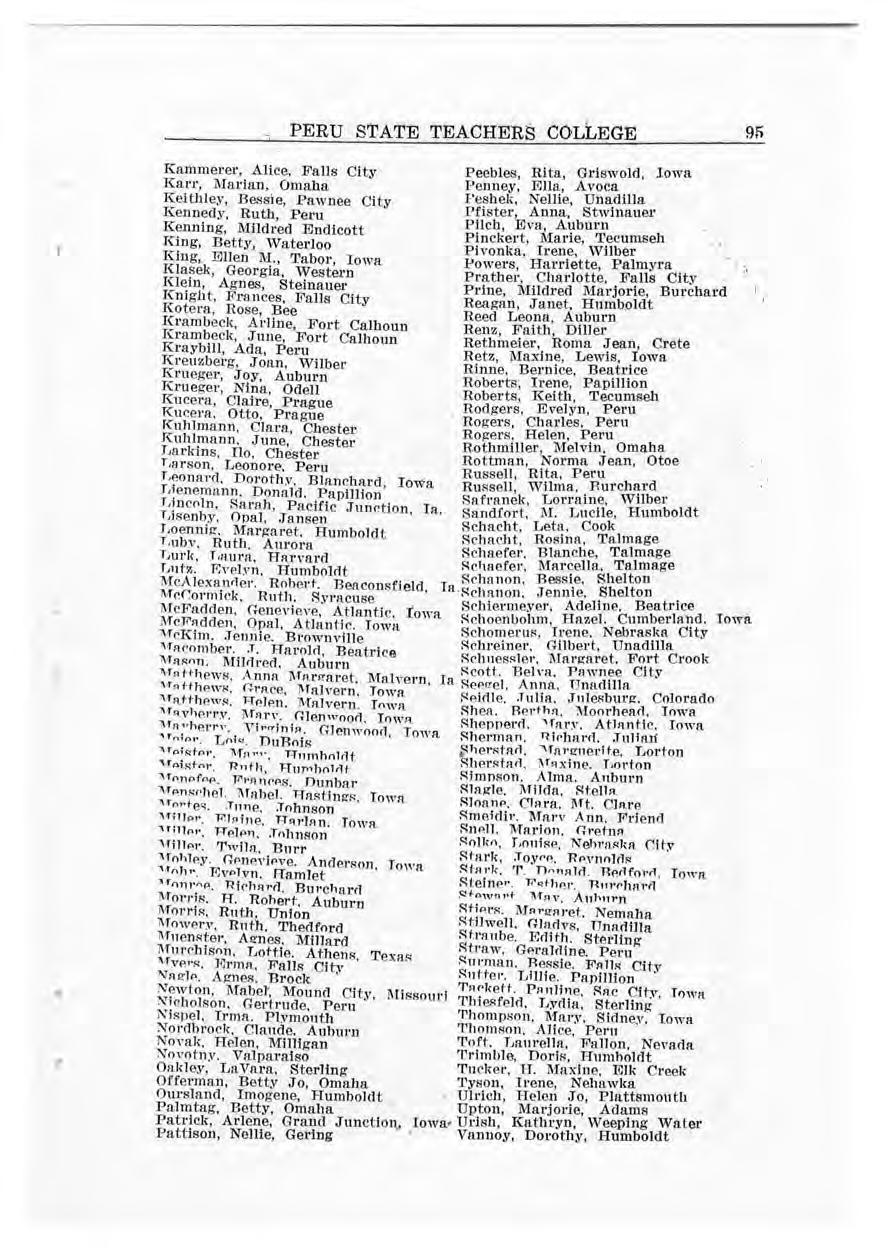
1\-rn,.her1•v. Vii·""inin. G]enwooil, Iowa. Rh e rman. llirharrl .Tulhui
":'lrn; o ,• . Lni ct. DuRni s ~ h et•R tnrl . ~ f n1 •gn e rite. Lol'ton
~ ,rP.1 1:: t o r. l\f$1•·• T-Tninhnlrlt
, ,roi F,: t o r R,1th , JluJ'llhnlrlt
8 h e rRta,l, ~r,;ixine. Tiorton
~ imn s011. Alma. Anburn
Mnnpfpp_ F'•·s11rP.s. Dunbal' Sl a J?l e. Milda , Rt, ella
M,ensd1el. Mahe!. T-Tastln i:s. IowR. Rlo a nP. Cla l'a. Mt. Cln r e
,rcw t ec-,;, Tnn e, .Tohnson
, ,ri11 0 ,•. 'P. 1,.-.in e. T-T qy]An. Towa
~nnPr. 'FTe )P'l. . .Tnhnson
1 fill ~1·. Twila, Burr
"\fohl ey . nPn P.v i r-ive Anderson, Io wa
"' ,rnJn•. I 1 ~v 0 1:vn Hamlet
~,rflll l' "P. . Hirh rrl. Bu1·cha rri
Mo,·r! s, H. Rohert. Auburn
Mo 1·1·is. Rnth, Union
Mowerv. Rnth. The<lford
M'n e nster, A!l'nes,. Mlll a rd
Jlfo1·clJ1 snn, Lotti e. Athen s. T exas;
My.,,•,. J•, rm n. Falls City
~H l?l P.. AJ?n es. Brock
- w to n , Mabet, Mound ~,t .v , Missouri
N.!cholson. Gertrude, Pei u
N1spel, Irma P l ymouth
~or<lbrock. Cl a nd_e Auburn
No,·ak H elen, Mllhgan
Novotn~•- Valp a r a iso
Oa kley, L a Vara, Sterling
Offerman, Betty Jo, Omaha
Oursl a nd, Imog ene, Humboldt
~mp,iclh·. l\ifnl'v Ann. F'ri e nrl
i::;nP.11. JWndon. '1re h111
~olkn , J,0 11i ~e. NehrnRka City
~turk .To y"P. RPvnnlrli.:!
~tnrk'. 'r n :;11:-11<'1 TIP.rlfnrrl Iowa
i::;teJne,· 'TT' Qth P, r Jt111•rlu-t rrl
~.,_own,•t l\if$1v Anl... nrn
Sti.,rs. M~1·a:a;·et. Nemaha
Stilwell. nJa.<lvs , Una<l illa
Rtra nb e. E,lith. Sterling
flt.ra w, Gernl<line. Peru
Snrm a n. R ess ie Falls City
Sutte r Lillie Papillion
'l'nrkef t Pnnlin e Sac Clt:v. Iowa
Thi e..s felrl. Lydia, Ste rling
'l:'homps on , Mary, Si<lne~•. Iowa
•rhomso n Ali ce P e ru
Toft L a iirella, · ll'allon , Nevada
•rrimble Doris Hmnholdt
Tu cke r • H. M~'x ine, Elk Creek
Tyso n • Irene N eh awka
Ulric h' Hele~ Jo Plattsmouth
Upton ' Marjot·ie' Adams
U
Patrick , Arle n e, Gr al}d Junction, Iowa• 11sh, ¥:i 1 )\~· J:~mboldt
Palm t ag, Betty, Omaha
P a t t ison, Nellie, Germg
• K ti 'w ping Water
Vannoy, 0 10 1Y,

Va ughn , Maxine , Pawnee City
Vested, Phyllis. Seward
Vitek , Vlasta, -Virginia
Vra n a, Vivian , Bee ·
Wagner, Cl a ri ce, Co un c il B lu ffs, Iowa
Walker, Ida; Peru
Walker, Wilm a, Peru ·
Walla, Marie Ann, Valparaiso
vVeaver, Dori s, Al ex andria
Wederquist, · Ralph, Mal vern, Iowa
Wenz , Bertha, Diller
Wert, Rob e rt a, Elk Creek
Wheeler. H ele n , Glenwood. Iowa
Wick , Esth er, B lu e Sprin gs
vViedeman, F. Glee, E m erson, Iowa
Willey, E d ith, Libe rty
\Villi ams, Bett y, Peru
,vnm s, Harriet, Holle nberg, K an sas
With e r s, Betty, Humboldt
Wi ttwe r, E l ma, H umboldt
Wright, Mad elin e, Glenwood, Iowa
\V y mol' e, Edith, ] ,reedom
l'.e ars l e,v, Lucille, Palmyrn
Yo un g , Amelia, Brownville
Yo un g, Ahtyn, Adam s
Zasteea, A ud re? , Loui s vill e
Z urbl'i ck, ,vm. , A uburn
September 1, 1942, to June 1,1943
A dams, ,var d, Peru
Adam so n , Carri e Ellen , T a bor , Iowa
Adam son, R u t h , Au burn
Ad en , DeWav1re. Carl e ton
A lb ers, F. · Ke i t h , · Tecum seh
Alde r s , Claren ce, Bal'n eston
Alta ffer , Virginia, R ed Oa k ·Iowa
A rm stron g, Bonnie, Peru '
Arms tron g; Ivn. Ash land
A rn!)ld , Lur:1-, Falls City
Atkmson , Vivian, Pawnee City
Atw ood , Gein·ge, · As hl a nd
Banks. Enrl. S:vracuse
R e ezle:v. Bonnie. ·syracu se
Renforcl. .Te nni e Peru
Rerger. B ett:v, Nebraska Cit:v
Rerge1· Rill v. NP.hrnskii Cit,,
1>e,•,,-e•·. Rn_he,•t ; Nehraskn City
Pa.,.J ett R.1f·n P l nttsni onth
n 1~_; ,. _ .Tack. " 'ahoo
Rlock e r Geo r ire. · Aubu rn
Rnck. Lntll'n, A uhurn ·
Rneckn e r. · Ruth. Plymou t h
'Ro !!le Eunice Princeton
Rohlin g, Sophie John son
Rnncl . ,Tt>n n . ' Diller
Bonesteel . H e rb e rt. Stell a
Branclt W illi a m , Unadill a
Rr~ss ler. Don , Auburn
Br!ght, D arl ene, Auburn
Tlrm s on . Phyllis. Peru
Brod , Ernest, Peru
R,·oers. Merlin, Burr
Brooks, llfar.iol'ie Bi gelo w Misso u ri
Brown, Bob, Peru
Brown, Wilb er, Auburn
Bruns, Donald , Sterling
Buhrmann. W a yne , Princeton
Burgess, Hugh, Talmage
Burgess, Margaret. T a lm age
Burroughs, Ma x, Beatrice
Burrows, H el en Roberta , Ad a m s
Eve r s , Ortll ello , Gl enwood , Iowa
Cacek, Donald , Odell •
Carm a n, Mervin , Cook
Carmi n e, A rdis , Elk Creek
Carmin e, P at ri c ia , Falls City
Cejka, John, P e ru ·
Chaloupka, Berneice, Swanton
Cleaveland , Alice Ann, P e ru
Cle aveland , W'allace, Peru
Clements, Ar t hur, P eru
Cline, lfach el L e on a , Auburn
Col glazi er, Richard, Falls City
Cordes , Dori s , P a pillion
Coupe, Betty, Auburn
Cram e r. , v m . Laurance, S up eri or Czeschin, Alvin. Avoca
Dall. Mar il y n , Ma nley
Das h e r . Bettye, P eru
DnYid ~on. P h y lli s, Pel'tl
D ec k. 1Wa ri o n. Peru
D eL<i n g-, Phyllis. Sy l'ac use
Dellfaro Tony, Neb rask a City
DeYo n g-, Lyle Adam s
Dn esc h ot .. Mel v in. Arlams
nool Py, V i vi.rm. Hn mbur g
n o n .,-h ertv. Ma,·,·. B l'ock
nrexl e r M:nrv Lon. Steel e City
Dr exl e r. F rPclcli e. Steel e City
n11 e1·fe l rlt Tuliom ne. F'nlls Cit v
V,hP1·lrn 1•if JV[ t1 1•,· i n. T-T fl mnton ·
Tr:,11110111: l ~o n. ~f,n •jeJ. Pe 1·11
~:1lnv_ r'J,wilifi. ~.'" 'RC~H::e
fi',;_:f>h(.)11 _ l\ 'lilif• •erf. PPl'l1
Pn11rl t:\1' I.:.!. RP.nl1e11. Dill pr
Pn 11 i:: f T,o,vP11. _ Sv l' tif> 11Rp
"filiclr A. J\1"a1·u-arP.{ · Palm Yea
~intel. Lo i i::_ Anb111·n ·
li"l e m_in g_ . Wilm"a . H e nd er~ on , Iown
T<'ox . Boh. Slcl n ev. Iowa
T<'i•nnkfortP1•• Ifo b a ni s . T obia s
-,,,,.~.nsnn. Tl.oh e rt. W a ho o
Fr1e6JJ' Hester. Verd on
Gall~way, Gl e ndora Auburn
GatT!Son. Do,:oth y, .Union
ne~rml!er. Elizabeth. Papill io n
<+ei c1c Ge n evieve, Auburn
n eol'ges L u etta. Shubert
fless On a Syr ac use
<::-ockl ev, F lor ence, P er u
Good, Law ren ce, Peru
G1:ady, Bettie Ann e, Elmo, Missouri
G1aves, Jean , Coun cil Bluffs Io wa
Gross Ethel Burr '
Gr undman , Donald. Syracu se
Grundman, Lois Nebrasl,rn City
G ub ser, ?a?a, H a mburg, Iowa
Hanek, Al v m , Elk Creek
H acker, Mary Alice, Auburn
Halcomb, nuth Filley :
]{a ll, Rollin, Nemaha
Hammons , Margaret Mable, Nebr. City
Hancll P.Y, Mattie, Shubert
H a ndley , Wendell, Nem a ha
Hanlon , Nettie Frances, Peru
Harding, Clifford, Hamburg, Iowa
Harvey, Mary Lu , Gra nd I sl a nd
II.asenyager , Willi a m, Salem
Havel, Lillian, Wilber
H ~yes, Esther Jeane, Auburn
Hechler, Mabel, Troy, Missouri
Hector, Arnold , John son
Henders on, Max, Carleton
Henning, Charles, Peru
Herndon , Ruth , Hebron
Hietbrink, Myrtle, Adams
Iiill, Patri ci a, Peru
Hin es, Pearl , Barneston
Hinman, Vera, Council Bluffs, Iowa
Hoagland, Jean , Omaha
Holliway, Al a n , Nebraska City
Holman , Jea n , Auburn
Holman, Vester, P eru
Houseman , Dwig ht, Barneston
Howell , Thelma, How e
Huey, Jam es, Auburn
Hnff, Lowell , Oakland , Iowa
Huff, Vera, Oa kland, Iowa
Hunzeker , Will a rd, Humboldt
Hutton , Kenneth, Brow n v ille
Hutton, Luther, Auburn
Hutton , Rich ard, Auburn
Jacka, Wa nd a , Tecumseh
James, Rob er t, Elmwood
J enkins, H a rold, Humboldt
Jimerson, Mary Shirley, Peru
John s on , Cec il , Kan sas City , Missouri
Johns on , Vir gie Lee, Kansa s Ci ty, Mo.
Jones , Joy, Peru
Jones, Dori s, Liuerty
Jones, L esli e Dean , Lib erty
Jones, Rita, Auburn
Jordan , Edith, Sidney, Io wa
Juilfs, Ma r y, Burr
Kane!; Nina, Humboldt
Kasten, Evelyn, Greenwood·
Kelley, Jo se phine, F a ll s City
Kennedy, n etty, Brown vill e
K e nned y, Burtis, Peru
Kenned:v , Ruth, Peru
Kenton, Pearl ,- Peru
Kerker, Barton, Nemaha
Kerker, Earl, Omaha
l{in g, Ellen , Tabor, Iowa
Kingsolver, Richard, Peru
Kl e in , Evelyn, Hamburg, · Iowa
Knapp , Richard; Auburn
Konig, Selma, Peru
Koeppel, Bonnie, Peru
La1'sen, Melvin, Hampton
L arso n , L eo nor e, Peru
I,atshaw , Ruth, Cortland
Law r en ce, John , Brown ville
Leech, Una May, Humboldt ·
Lempka, A l ve n a, Vesta
Lienemann , Donald, Papillion
Lilly, L ave rne , Stella
Linder, Wn.yne, Nehawka
Livington, Gerald , Omaha
Locke, Ralph, Crab Orchard
i\'IcA!exander , Rober t, Beaco n sfield , Ia
McAninch, Doyle, Rh: e rton, Iowa
McArclle , Betty, SRlem
McCandless, Arlin , Nemaha
McKee, F 1·e d e ri ck, Pawnee Cit y
Macombe r , J. Harold, Beatrice
Mann sc hreck, Mary, Syrac us e
Mares, Mary, Peru
Marshall, Walter , Beaver City
Mason , I sabel, Peru
llfats chullat, Deloris , Nemaha
Matthews, Anna Ma rga r et, Ma l vern
Maxw ell, H a rrie t, Omaha
Meister , Mel v in, Humboldt
i\Iill er, Doris, Atlantic, Iowa
•Miller, Esther, Peru
Miller, Lois, Unadilla
Miller, Lucille, Geneva
Monroe, Rich a rd , Burchard
:.\1oore, L eo nard , Ne maha
;\foore, Marjorie Helen , Brownv ille
Morris, I-I. Robert, Auburn
Moss, Jean, Burr
i\Iulder, Goldie, Firth
Mulder, Iva , P a nama
M~•ers, Robert, Sidney, Iowa
Xedd en ri ep, Margie, Johns on
Kewton, Mabel, Mound City, Mis souri ·
Nie buhr , Gold e ne, ,vflhoo
K ispe l, Irene, Plymouth
Nord brock, Claude, Auburn
Norto n , Lois, A uburn
Noyes, Mildre d , StellR
Oakley, LaV ara, Sterling
Oakman, Rob eut, Auburn
O'B ri en, John Fremont
O' Dell , Robert, McPaul , Iowa
Oetken, Ve ron a, Co ok
Osterthun, Er vin , Tecum seh
Ottersbel'g, Willi am, Johnso n
Palmer, Virginia, Fairmont
Palm tag , Betty , Omaha
Parks, Way n e, Dorchester
Pasca l, Dick , , veston
Pate , Gert rude, Peru
Patrick, Ralph, Emerson, Io,va
P a t te r so n , Donn a Lee, Arlington
Pershing, Dorothy , Greenwood
Pershing , Ro se1n a ry, Greenwood
Peterson, Ethe l, P eru
Pierson , ,villar d , Sidney, Iowa
Powers, Allen, Oberlin, Ohio
Prine , :.\1arjorie, Burchard
Pruitt, Helen Betty , Elmo, Missouri
Pulwer, Ella, Auburn
Rachow, ,vm Carleton
Redding, Mary Frances, P e ru
R edfern, F. Will a rd , Peru
l'leutter, Eldon, Sterling
Riley, Bette, Dawson
Roberts, Keith , 'l.'ecumseh
Roberts on, Ernest, Auburn
Rodgers, Evelyn, Peru
Roet tge r , Loui se, Otoe
Rogers , Verna, Peru
Rohr s, Kathryne, Peru
Rohrs, Kenneth, Auburn
Rohrs , Orval, Johnson
Rohrs, Ruby, John son
RonhoYde , Arthur, Lincoln
Ro se, Rogene, Auburn
Rothmill e r, Me lvin , Om a h a
R ya n , Thomas, Missouri Valley, Iowa
Sac k, \ Va yne, Beatrice
Safran e k , Lorrain e, ,vnb er
Sayer, \Va:rn e, Ne1naha
Sch aec h te rle , Katherine, Burr
Sc hilling, Ruth, E me r son , Iowa
Schme l zer, Percy , Hayes C~ nter
Schmidt , K enn eth, Auburn
Schmidt, Mildred, Sterling
Scho e nbohm, Hazel, Cumberland
Schreiner, Delores, Unadilla
Schreiner, Gilbert, Unadilla
Schul z, Milton, Sigourney, Iowa
Scott, Bette J a ne, Humboldt
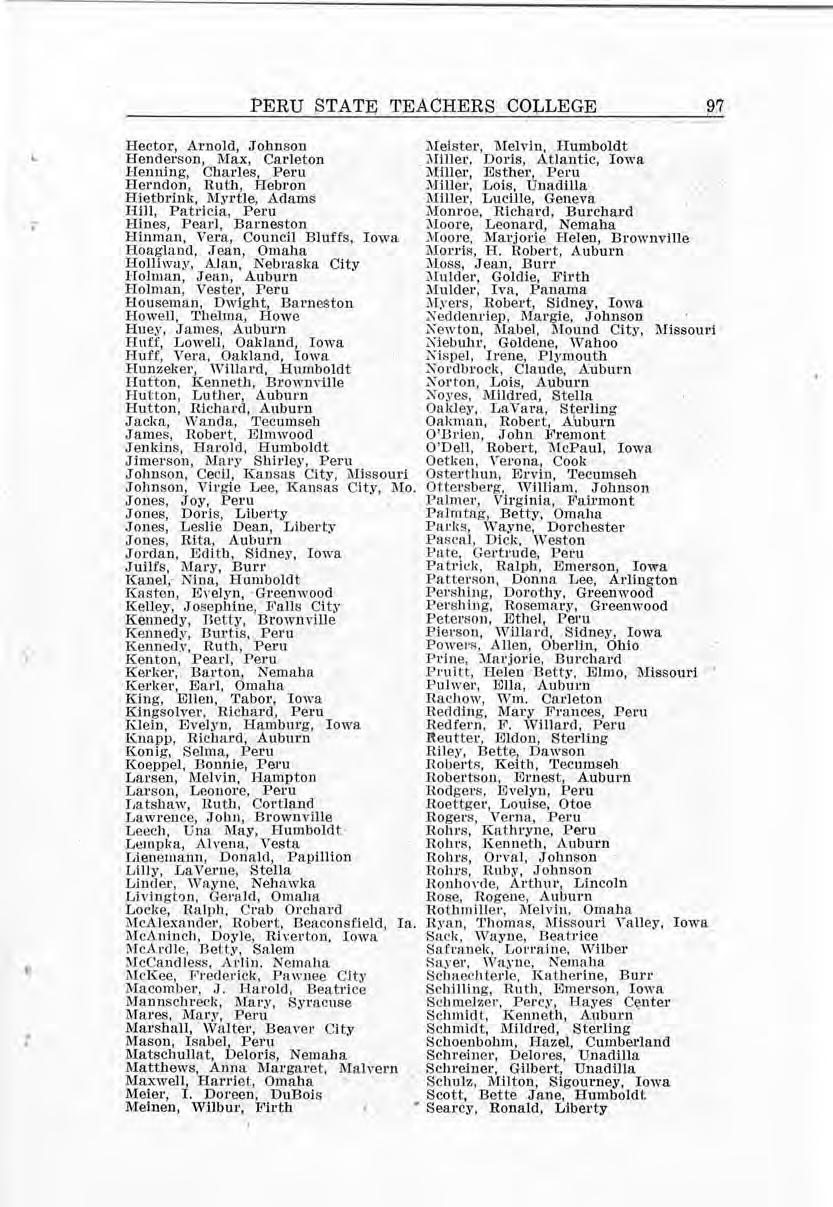
Sed l a ck, Betty, Table Rock
Showen, Maxine, Barneston
Shrader, Wesley, Nemaha
Slagle, Annetta, Stella
S lagl e, Evelyn, Falls City
Slagle, J an ice, Falls City
Smith , Oscar Dean, Peru
Snow, W. Harold, Auburn
Spoor, Beul a h, Peru
Stan l ey, Elizabeth, Peru
S tark, Donald, Bedford, I owa
Steffen, Donna Mae, Pern
Stepan , Virginia, Peru
Steven so n , Mary, Auburn
Stewart, Cl arence, Stella ·
Sto ner , Geraldine, Falls City
Sutter , Lillie, Papillion
Tanner , Arthur Richard , Per u
Tenhulzen , Von ia, Firth
Thomp sen , Beul ah, Palmyra
Tiemann, J. Lo u ell a , Tarkio, i\Iissouri
Ty n o n , Isabel, Peru
Ul ri ch , Esther , Steinauer
Ulm er , Harlan , Bedford , Iowa
Vosicky, L. Lydia, Wilber
\Vagoner, Lois, Louisville
\Valker, Ella Louise, Peru
Walker, Wilma , Peru
. Wall, Iola, U nad illa
Wareham, Marjorie, Stella
Weber, Lu cille, Cook
Weddle, Jo y, Peru
Wehrmann, Dennis, Wabash
, veiler, Marjorie, Dunbar
Wd ls, Helen, H astings
" ' est, Darlene, Beatrice
W h eel e r , Robert, Nebras k a City
White, Du ane, Superior
Wil kin so n , Christi n e, A uburn
W ilki nso n , Ruth, H umbo ld t
Williams , Donald, Glenwood, Iowa
" ' illi ams , Mad ge, Oakland , Iowa
Wirt1,, Carl , Louisville
Woods, Billy, Emerson, Iowa
Wymor e , Edith , Freedom
Yocum, Orivell, Humboldt
Youn(!' , i\Ja 1·vi n , Fall s City
7.astera. An<lrey, Louisville
Zurbrick , , v mi a m , Auburn
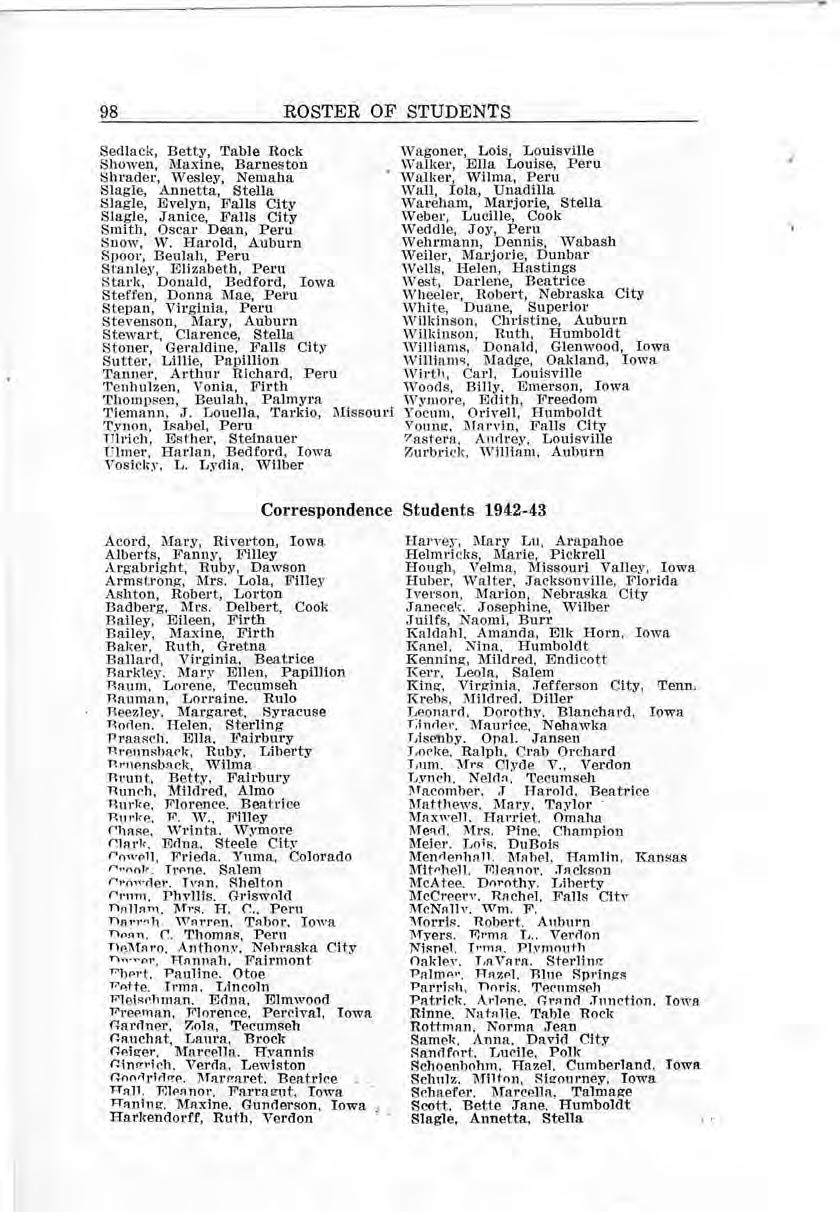
Acord, Mary, Riverton, Iowa
A lb e rts, Fanny, Filley
Argabright, Ruby , Dawso n
A rm stro nl!', Mrs . Lola, Filley
As hton, Robert, Lorton
Badb erg, llfrs. Delbert, Cook
Bailey , Eileen, Firth
Bail ey , llfaxine, Firth
Baker, Ruth, Gretna
Ballard , Virginia, Beatrice
Harkley. Marv E ll e n , Papillion
Ra um , Lorene , Tecumseh ·
Haum an, Lorraine. Rulo
Beezley, Margaret, Syracu se
no,len. Helen , Sterling
f'raaR Ch. Ella , I!'airbury
nreu n Rbark , Ruby, Liberty
RnlP.nsback. Wilma
Rrunt, Bett~•, Fairbury
nun ch, Mildred, Almo
Rurke Florence. Beatrice
n11,•ke. F. ,v. , Filley
f' h as e. W'rinta \Vymore
f'larJ,. E<l11a. Steele Cit~•
<'nwplJ. Frieda. Yuma, Colo ra do
0 ""nk . lrPne . Snlen1
f'11 ·owti e l'. Tvnn, Shelton
f' rnm. Ph:vllls. Griswnld
nn11a1>1 M>·R. H C Peru
nny1•!1h . , v".1 r ~n . Tabor . Iowa
n pn n C. Thomas, Peru
n eJ1fa 1•0 Antho,w, N,:,braska City
n~••·p1• Hanna h , Fa irmont
"'bP>·t. · P a ulin e. Otoe
"'"tte. Irma , Lin coln
ll'JeiRchman. Edna, Elmwood
l"reeman , F l orence, Percival, Iowa
ffar<lner , 7.ol a , T ecu mseh
ffauchat, Laura, Brock
11<>1 ,rnr. Marcella. H:vannls
11\nrn·ich. Verda, Lewiston
11nn,lrirlrre. Marrraret. Beatrice
-r=ra 11 J1Jlf'anor. Farr al!'ut. Iowa
T=Taninl!'. Maxine , Gunderson, Iowa ,
Harkendorff, Ruth , Verdon
Harve r, Mary Lu, Arapahoe
Helmricks, Marie, Pickrell
Hough , Velma, Missouri Valley , Iowa
Huber, Walter, Jacksonville, Florida
Iverson , Marion, Nebraska City
Janecek Josephine, Wilber
Juilfs , Naomi , Burr
Kaldahl, Ama nd a , E lk Horn ,. Iowa
K a n e!. Nin a , Humboldt
Kenning , Mildred , Endicott
Kerr, Leola, Salem
King, Virl!'inia, .Jefferson City, Tenn.
Krebs , Mildred . Diller
Leo n ard, Dorothy. Blanchard , Iowa
nn cl e r. Maur ice , Nehawka
J,isetiby , Ona!. Jansen
Locke. R a lp h, Crab Orchard
J ,um. :\frs Cl yde V. , Verdon
L:v n ch N elda 'l'e cumseh
]l•raco mb er. ,T Harold, Beatrice
Matthews, Mary, Taylor
111ax"·ell. Ha rri et. Oma h a
Mes.a . Mrs. Pine. Champion
Meier. Lo;s, Du Bois
ll1enne11hall. Mabel. Hamlin. K ansas
Mit~h e ll. lllleanor. ,T R.ckso n
McAtee. Dn1·oth:v. Liberty
McCre erv. RR Ch P.I, Falls Citv
McNallv. Wm. F.
C\forrlR. Robert Anburn
Myers. ll11•ma L.. Vet•ilon
N .if.m el. J,·ma. P J.vmouth
·Oakl e )' T,A VRi·a Sterlin!!
PRlm"''. RA ZPl. Rin e S pl'in gs
P a r r i s h. nni·is. Tecnmseh
Patrick. A.1'1 .,n e. CT 1·An d .T1m ction , Iowa
Rinn e , NatA.l i e. Table Ro ck
Ro ttma n , Norma Jean
Samek. An n a David City
Ranilf()l't. Lur.ile, Polk
Scl1oenbohm, Hazel. Cumberland , Iowa
Schulz. Milton , Ria;oumey , Iowa
Schaefer. Marcella , Talmage
Scott. Bette Jan e. Humboldt
Slagle, Annetta, Stella
Steven son , Margaret, Malvern, I owa
St irba, EYelyn, Swanton
Stoc k , Ma ry Lee
Stocker, Augusta, Auburn
Sunderl and, Nedra
Swiman, June, Fall s City
Vannoy, Dorothy, Humboldt
Vedsted, Phyllis, Seward
Vra n a, Vivian, Bee
Wager, Mrs. Fred, Beatri ce
W'ag n er, Vesper, Hambur g, Iow a
wal Le r , , Vilma, Peru
Walla, Marie, Val par a iso
Weave r , Dori s, Alexandria
Wederquist, R a lph, Malve rn , Iowa
Wei c hel, Elaine, Plymouth
Williams, Twila, Liberty
Wi r t h, Carl, Loui svill e
Withers, Betty , Humboldt
Yearsel y, Lu cille, Palmyra
You n g, Grace, B eatrice

Granted from May 1, 1942, to May 1, 1943
Degrees
May 29, 1942
Ad ams, Co rinne , Whitfield, Peru
A nd erso n , Maurice, Ong
Argabrigh t, Edwin, Coin, Iowa
Beal , Barbara, ,vatson, Missouri
Boosi n ge r, Josephin e, Pawnee City
Bo u se, Hazel, Dunbar
Ca ll a n , Clair, Odell
Cl ayb urn, Bertha, Monroe
Col e, Betty, Fall s City
Cro n e, Ruth , Beatrice
Dallam, H aro ld, Peru
Dea n , Charle s Thomas , Humbold t
Dean, Dona ld, Fairmont
Fank h ouser , William, Humbold t
F ilm er, W a yn e, Peru
Henders on , R obert , Anderson, Io wa
Horto n Ma r y, Salem
Hurlburt, Ella Mae, Fairbury
Jackson , Edna, Lin co ln
Jackso n , Max, Pacifi c Jun ct ion, Iowa
Jensen, Mary Co llin, Peru
Jones, Nancy Ellen, Peru
Knutson, H erb e rt, L ouisv ille
McGi nnis , Rose, Humboldt
Ma n g old, Anna, Falls City
Morelock, Monna, Watson, Missouri
,V[uenchau, Grace, Alvo
Nispel, Althea, Plymouth
Rhodus, John, Peru
Sav ille, Helen, Salem
Sehn e rt, Lloyd , Crete
S h afer, Nedra, Shubert
Slagl e, Dean, Falls City
Strasburg, Theodore T a lmage
'l'eachman , Doroth y, Lin coln
~ ' illia ms, Robert, Glenwood, Iowa
July 31, 1942
As h to n, Robert, Lorton
Dreeszen , Vincent, Palm y ra
Fru e hlin g, Erwin, Auburn
Gardn er, Zola, Tecumseh
Hannan, In a , Lincoln
Hutc h eso n , Ruth, Nemaha
King, Virginia, Tabor, Iowa
Krueg er, Jo y, Auburn
•Linder, Maurice, Nehawka
Muenster, Agnes , Millard
Peter s on, Ferne, Shickley
Rti er, Margaret, Nem a ha
Toft, Laurella, Fallon, Nevada
Willey, Edith, Lib erty
Yo un g, G {\:lwyn, Adams
September 28, 1942
Nispel , Irma Sue, Plymouth
January 22, 1943
Hutto n , Luther, Auburn
Three- Year D-iplomas
May 29, 1942
Albe r ts , Fan ny , Filley
Arm strong, Dorothy , Howe
Lovejoy, Fay, Inavale
Miller, Betty J ean, Hamburg , Io wa
Sandfort, M. Lucile, Humboldt
Willman , Edwinnie, Martell
July 31, 1942
Burke, Florence, Beatrice
Burke,. Floyd, Filley
Feighner, Zeta, Nemaha
:Henefee, Frnnces, Dunbar
:\Iiller, Helen, Johnson
September 28, 1942
Stark, Pauline June, Reynolds
May 29, 1942
Acord, Bernice, Riverton, Iowa
Bretthorst, Oscar, Syracuse
Brier, Phyllis Ji]]aine, DeWitt
Dres s ler, Barbara, Nemaha
Fogle, Vivian, Tecumseh
Friedly, Marjorie, Pawnee City
Fulton, Lois, Malvern, Iowa
Gardner-•· Letha Panama
Geiger, 'Maxine,' Waco
Graham, ,vanda , Brock
Grefe, Robert, Lanham
Hacker, Evelyn, Auburn .
Hamel, Elda, Mill Grove, Miss ouri
Hineline, Lutie, Percival, Iowa .
Hinman, Charles, VVymore
Kiburz , Gretchen , DeWitt
Leigh , Katherine, Nebraska City
Link, Marguerite, Waverly
Lum, Ec ho Elaine, Verdon
i\Iag neso n , LaVema, Stanton, Iowa
Ma nsfield , Ella, Hamburg, Iowa
Ma stin, Helen, Auburn
M iller , \Vilm a, Tecumseh
Moore, Marjorie Kathryn, \Veepin g Water
Robison, l{uth, Pawnee City
Rockwell , Patricia, Humboldt
Schneider, Bette , Panama
Schuldt, S hirl ey, Council Bluffs, Iowa
S lagle, Milda Ardell, Stella
So lled er, Ruth, Thurman, Iowa
S picer , Hazel, Ames, Iowa ·
S teuteville , L Genevieve, Nebraska City
'.rhomas, Mary Ellen, Nebraska City
Uter mohlen , Billie Dean , Verdon
Wilkinson, Christine, Auburn
Wylie; Helen, Sidney, Iowa
July 31, 1942
Adams, Catherine, Council Bluffs, Ia.
Barrett,· 1\1:arcella, La,vrence
Beezley, Margaret. Sy racuse
Carter, Hope, Plymouth
Doolittle, Lorraine, Red Oak, Iowa
Duerfeldt, Florence, Falls City
Goodridg-e,. Margaret, Bradshaw
Hall. Eleanor, Farragut, l0wa .
Hawlev Phoebe · Anderson , Peru
Kaldahl , Amanda , Audubon, Iowa
Mason, Mildred , Auburn ·
Meier, Lois , DuBois · ·
Mohr, Evelyn, Hamlet
Nov otny, " ' innifred , Valparai s o
Offerman , Betty Jo, Omaha Ro g~r s, Helen, Peru
Safranek, Lorraine , Wilbur Sc haefer, Blanche, Talmage
Sc haefer, Marcella, Talmage
,-\chiellll1e ye r, Adeline, Beatrice
Stark , ,Tovce, Reynolds
Rtilwell , Gladys, Unadilla
'l'l'imble, Dori s, - Humboldt
Wederquist , Ralph, Malvem , Iowa
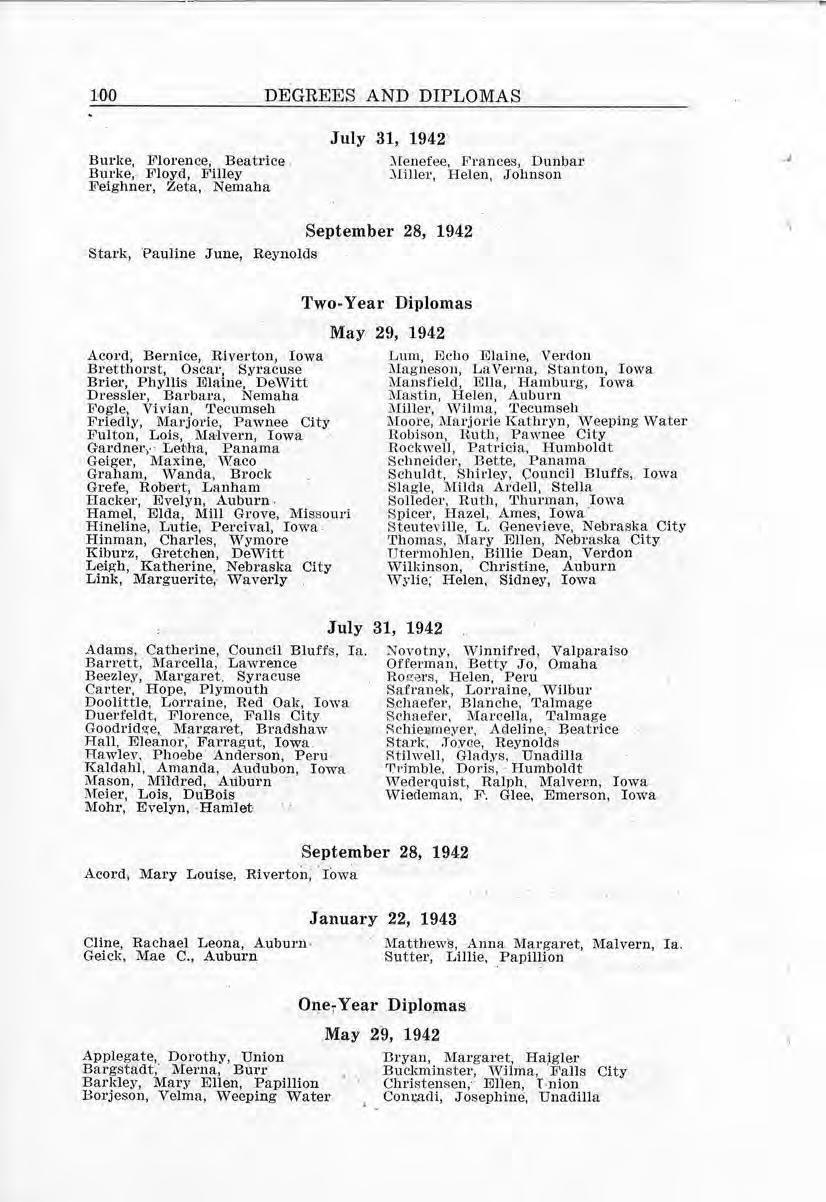
W'iedeman, F. Glee, Emerson , Iowa
September 28, 1942
Acord , Mary Louise, Riverto~ ; Iowa
January 22, 1943
Cline, Rachael Leona, Auburn ·
Geick, Mae C., Auburn
iVIatt hew s, -Anna Margaret, Malvern, Ia .
Sutter, Lillie , Pap!Uion
One ; Year Diplo.mas
May 29, 1942
Applegate, D()rothy, Union Bargstadt, Merna, Burr
Barkley, Mai'y Ellen, Papillion
Borjeson, Velma, Weeping Water
Dryan, Margaret, Hajgler
Buckminster, Wilma , Falls City
Christen s en; Ellen, T,nion Com;adi, Josephine, Unadilla
Copenhaver, Carol, DuBois
Dell , Martha, Bea trice
Drent; Marjorie, Adams
Durfee, Dornthy, Falls City
Eastwood, Dorothy, Liberty
Ficke , Noeline; Palmyra
Forsyth, Lucille, Beatrice
Frantz, Martha , Beatrice
Gess, Norma, Syracuse
Handley, Jean, Nemaha
Harding, Helen , Humboldt
Hays, Helen, Cook
Lynch, Nelda , Tecumseh
Meister . Irene, Humboldt
l\Iohr , Lucille, Hamlet
Mulder, Mona, Panama
Neeman , Wenona. Douglas
Reschke , · Mary , Preston
Bricker, Alta Fern, Ashland
Burg ess, S a rah, Talmage
Bush. Pauline, Palisade
Cowell, Marjorie, Auburn
Monroe, Richard, Burchard
Rose, Evelyn, Falls City
Russell, Wilma, Burchard
Ruzicka, Adelene, Pawnee City
S chacht, Hilda, Cook
Scrimsher, Mary, Hamburg, Iowa ·
Sisco, Mary, Burchard
Smidt, Wilma, Crab Orchard
Sohl, Shirley , Ashland
Stepanek, Velma, DuBois ,
Stroh, Orpha, Plymouth
Sugden, Betty, Douglas
Thiltges, Ilene, Rulo
Townsend, Marguerite, ,vymore
Vohs, Norma, Burr
Whitfield, Marian , Ames , Iowa
Williams, Edith, Endicott
Wirthele, Doris, Burr
Zweibel, Lois, Central City
July 31, 1942
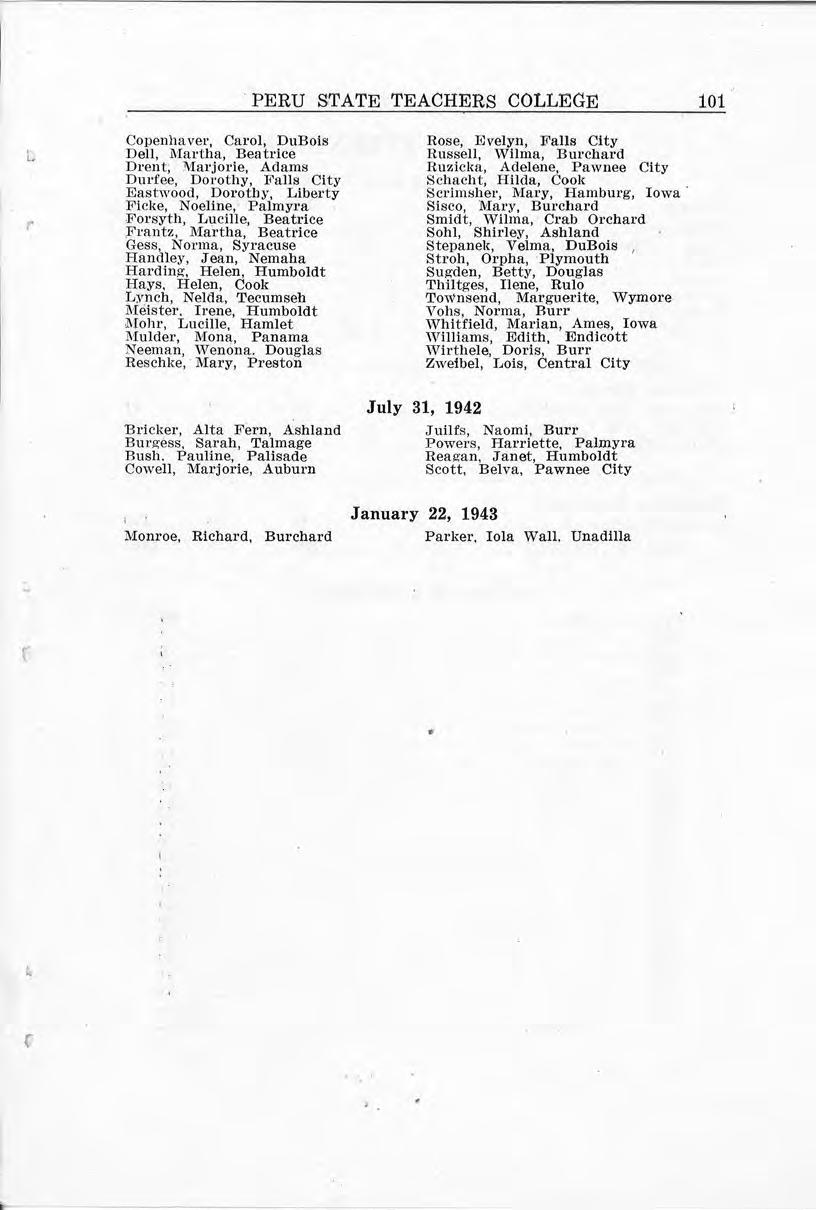
Juilfs , Naomi, Burr
Powers, Harriette, Palmyra
Reagan, Janet, Humboldt
Scott, Belva, Pawnee City
January 22, 1943
Parker. Iola Wall. Unadilla
